
Mental Vitality: Assessing the Impact of a
Walk in the Woods
A thesis submitted in partial fulfillment of the
Professional Doctorate in Education at
London South Bank University
August 2015
Revised April 2016
by
Mark F. Bowen
Dissertation Committee:
Prof. Stephen Lerman
Prof. Paula Reavey

i
DEDICATION
Dedicated to the furtherment of Ecopsychology.

ii
ACKNOWLEDGMENTS
I would like to thank Professors Lerman and Reavey for their expert and tireless
guidance in this dissertation process. Additionally, the entire team of professors at
LSBU who instructed us illuminated my path and opened up new ways of thinking
during the programme and for that I am very grateful.
Additionally, I would like to thank my focus group of students who provided feedback
and advice on my initial research proposal and helped shape my final research
project: Amilee Bishop, Julia Colleluori, Emma Imbert and Yunting Huang.
And finally, I thank my ever-so-patient partner, Gabriel English, who ended up with
many, many weekends of my household chores so that I could focus on completing
this dissertation.

iii
ABSTRACT
As pressures mount in the world, they take a toll upon our mental and physical
capacities. A foundational principle of ecopsychology is that connection with nature
positively impacts our mental and psychological health and well-being. While much
research has focused on children and adults, no research into the influence of nature
specifically targeting 16-18 year olds has been conducted. Additionally, this doctoral
dissertation addressed the calls from literature and the gaps in the knowledge base
regarding employing just one independent variable and one dependent variable in
ecopsychology nature walk research. Existing commentaries are critical of many
extant research projects which have sought to measure too many outcomes (in their
opinion) in one study. Mixed methods research was justified and employed based
upon the researcher’s philosophy and the goals of the research project. This
investigation examined the effect of nature walks on a population of 16-18 year olds -
- students at an international school, or Third Culture Kids (TCKs), defined as a child
living outside of their parents’ native culture, a further novel innovation in this area of
research. This study measured one aspect of mental vitality, that of mental acuity.
Using the d2 Test of Attention as a quantitative measure to evaluate the impact of
regular nature walks and personal reflection journals as a qualitative measure, this
study found a significant improvement in participants’ mental acuity in both the
quantitative and qualitative results after a regular, twice weekly, 40 to 60 minute
duration nature walk intervention. Implementation of nature walks into schools is
highly recommended to benefit students’ psychological health and well-being.
Recommendations for additional research are also suggested.

iv
Table of Contents
Dedication………….………………………………………………………………………...i
Acknowledgments..……………………………………………………………………...ii
Abstract……………….………………………………………………………….…………...iii
Table of Contents…………………………………………………………………………..iv
Chapter 1: Introduction………………………………………………………………...1
Chapter 2: Literature Review………………………………………………………...13
Chapter 3: Methodology………………………………………………………...…....72
Chapter 4: Results………………………………………………………………………….100
Chapter 5: Discussion…………………………………………………………..…….....123
Chapter 6: Conclusion……………………………………………………………....…..131
List of References……………………………………………………………………….….135
Appendix I: Publicity Poster…………………………………………………..……….144
Appendix II: Initial Information Sheet……………………………………………..145
Appendix III: Informed Consent……………………………………………………...146
Appendix IV: Weekly Theme Handouts……………………………………..…...149
Appendix V: Debriefing Document……………………………………………..…..151
Appendix VI: d2 Answer Sheet…………………………………………………….….152
Appendix VII: d2 Instructions…………………………………………………….…...154
Appendix VIII: Word Analysis………………………………………………………....157
Appendix IX: Raw Data/Inferential Statistics…………………………..………162
Appendix X: Two Participants’ Full Journal Entries………………………….165

1
Chapter 1
Introduction
"As long as this exists," I thought, "and I may live to see it, this
sunshine, the cloudless skies, while this lasts, I cannot be unhappy."
The best remedy for those who are afraid, lonely or unhappy is to go
outside, somewhere where they can be quite alone with the heavens,
nature, and God. Because only then does one feel that all is as it
should be and that God wishes to see people happy, amidst the simple
beauty of nature. As long as this exists, and it certainly always will, I
know that then there will always be comfort for every sorrow, whatever
the circumstances may be. And I firmly believe that nature brings
solace in all troubles.
-- Anne Frank, excerpt from The Diary of a Young Girl.
So wrote Anne Frank during her ordeal before she and her family were discovered
by the Nazis. Her insight and analysis reflects the common wisdom shared by
humans regarding the positive effects nature can have on the human psyche and
well-being. As with many other subjects of “common knowledge,” until the past 40 to
50 years, these ideas were not subjected to scientific methodology. But the concept
of nature influencing not only mental, but physical, health has had a long intuitive
influence even in the absence of empirical evidence over time.
As recently as 2003, for example, a comprehensive UK government White Paper
could reliably note: “Intuition and experience seem to support the notion that nature
contact should be seen as a positive health intervention, yet health professionals
have not yet widely adopted horticulture, wilderness, nature or animal therapy….It is,
in other words, insufficiently evidence-based”. (Pretty, Griffin, Sellens & Pretty, 2003,
p. 21). The report continues with a critique of much of the published research in this

2
area as being not well designed and therefore not reliable enough to establish a
cause and effect relationship.
This present research project sought to examine the specific effect of nature walks
on the participants’ psychological health and well-being by examining cognitive
functioning using both quantitative and qualitative measures.
Historical Precedent
Restorative gardens and natural areas were key parts of infirmaries and hospitals
going back to the Middle Ages in Europe. Marcus and Barnes (1999) recount the
inclusion of these features beginning with the writings of Saint Bernard as far back
as the twelfth century CE to illustrate the origins in Western culture in places of
healing. (Marcus and Barnes, 1999). Marcus, writing alone the following year states:
“In past centuries, green nature, sunlight and fresh air were seen as essential
components of healing in settings ranging from medieval monastic infirmaries, to
19th century pavilion-style hospitals, to early 20th century asylums and sanatoria”.
(Marcus, 2000, p. 461).
As Enlightenment and scientific revolution ideals took hold and spread, the approach
to treating the mentally ill, then known as the “insane,” affected treatment protocols.
Dr. Thomas Story Kirkbride, who served as Superintendent of the Pennsylvania
Hospital for the Insane from 1841 to 1883 believed that surroundings and
environment could have a complementary effect on the healing process:
Kirkbride’s principles of design for moral treatment of the insane came to be
known as the Kirkbride Plan, and influenced the design of virtually all

3
American mental institutions in the late nineteenth and early twentieth
centuries…...And he believed in beauty. In his 1854 On the Construction,
Organization and General Arrangements of Hospitals for the Insane, he wrote,
‘The surrounding scenery should be of varied and attractive kind and the
neighborhood should possess numerous objects of an agreeable and
interesting character.’ The hospital building had to be situated so as to assure
views from every window, especially from the parlors and rooms where
patients congregated during the day. Flowers were to be grown in
greenhouses, and picked daily to decorate the halls and common areas of the
hospital. (Sternberg, 2009, p. 232).
But as the 19th century progressed into the 20th century and society became less
comfortable with the visibility of those with mental health issues, these principles
were abandoned. Mental institutions returned to the status of near prison like
conditions.
However, there has been a resurgence of these healing principles through
Ecopsychology in the 21st century which affirms that Kirkbride’s basic principles
should still be followed for maximum complementary benefits which have been found
to improve emotional outlook and mood. It is noted that these design features should
be included in all health care facilities be it for mental or physical health. More and
more research is acknowledging that simply attending to the physical parts of healing
is not enough but that there is a psychological component to any injury which the
body receives, which has long been unacknowledged or ignored (Sternberg, 2009).

4
And in the treatment of purely medical (as opposed to mental) conditions, there was
a parallel development in hospitals, with a prominent advocate like Florence
Nightingale.
After the war, she was a major proponent of British architect Henry Currey (the
designer of St. Thomas Hospital in 1868). It was based upon the pavilion principle
which originated with French architect Bernard Poyet, drawing upon the natural
sunlight, ventilation and airiness even in the absence of other natural elements due
to its location in urban London. In Poyet’s designs he incorporated large bays of
windows with long hallways to facilitate airflow, placed the sanitary facilities well
away from the patients, and located each bed near a window bay (Sternberg, 2009).
Nightingale’s ideas and concepts crossed the Atlantic and were incorporated into the
design of the Royal Victoria Hospital in Canada in 1893. Features were incorporated
such as twelve foot ceilings and large windows to allow sunlight and air into the
public wing and maternity wards, while affording views of the hillsides and woods
with the express intent of allowing patients to view nature. The nearby Children’s
Hospital included allowing the children outdoor time within their limitations which was
seen as crucial for their healing (Sternberg, 2009).
The relationship between stress reduction and viewing nature scenes was
demonstrated empirically shortly after Ulrich’s ground-breaking 1984 study detailing
accelerated recovery from surgery for subjects who had a nature view during
recovery. Ulrich et al. (1991) designed an experiment to artificially stress participants
through the viewing of a video and then viewing one of six “recovery” videos -- two of
nature scenes and four urban. 120 undergraduate volunteers (60 male/60 female)

5
participated and had 4 physiological measures taken immediately before and
throughout the viewing of the videos. These were Electrocardiogram (EKG), pulse
transit time (PTT), spontaneous skin conductance responding (SCR), and frontalis
muscle tension (EMG). “The results strongly support the conclusion that recuperation
was faster and more complete when subjects were exposed to natural settings rather
than the various urban environments”. (p. 222).
And right up to the current day, the importance of the environment in helping to
reduce stress to improve healing can be seen in Maggie’s Centres throughout the
UK and around the world. Charles Jencks, along with his late wife Maggie Keswick
Jencks, formed the charity to encourage complementary therapeutic treatments
incorporating features championed by the renowned architect Frank Gehry. “The
architect Charles Jencks, when interviewed in a PBS television documentary
directed by Sydney Pollack, said that Gehry ‘is committed to a notion of an
architecture that relates to healing.’ Jencks should know. Gehry designed a tranquil,
restorative refuge in memory of Jencks’ wife, Maggie Keswick, who died of cancer.
This small, whimsical, modernist building, reminiscent of a thatched-roof cottage, is
set in the rolling countryside near Dundee, Scotland, and is one of a series of
Maggie’s Centres designed by master architects. It is filled with places for reflection,
and provides views of the peaceful hills all around”. (Sternberg, 2009, p. 166).
Early Psychologists’ Views on Nature
“You must go in quest of yourself, and you will find yourself again only
in the simple and forgotten things. Why not go into the forest for a time,
literally? Sometimes a tree tells you more than can be read in books.”
The Earth Has a Soul: C. G. Jung on Nature, Technology & Modern
Life ed. by Sabini

6
After psychology had become a separate discipline from philosophy in the latter part
of the 19th century, two influential popular figures were Sigmund Freud and Carl
Jung. Their theoretical formulations are considered less scientific nowadays than
later psychologists as many of their concepts were built upon anecdotal data, but the
quote above emerges from Jung’s experience with Analytical Psychology. And, while
still anecdotal, is an opinion moving closer from simply “common knowledge” to that
of an experienced psychologist. Jung believed in an intimate inter-relationship
between each human being and the world around them. His admonition recognizes
the same common wisdom humans seem to instinctively know: that contact with
nature can make us “feel better.” This innate feeling is many times at direct odds
with our current age, however, as the number of people dwelling in cities and having
little contact with nature is at a record level, replaced by increasing contact with
virtual reality and technology (Pergams and Zaradic, 2008).
Consequently, humankind is facing increasing physical and psychological challenges
from the accelerating pace of modern life -- from the overwhelming quantities of
information inundating individuals during 24 hours of each day, to the constant
sensory stimuli from a variety of media, including mp3 players, televisions, mobile
phones, and the Internet. Meanwhile, social pressure within the workplace to
increase effort contributes to additional mental fatigue. The cumulative effect of
these has been observed to take a toll on an individual’s physical health,
concentration, alertness and focus (American Psychological Association, 2013;
Bratman, Hamilton and Daily, 2012; Buzell and Chalquist, 2015; Kaplan and Kaplan
1989; Tennessen and Cimprich 1995; van den Berg, Hartig & Staats, 2007).
While there are various approaches and strategies to address these issues,

7
ecopsychology is the specialization within psychology in which the disconnection of
the individual/patient from nature is seen to contribute to her/his problem; the
counterbalance indicates that the reconnection of the individual with nature is part of
the solution (Roszak, 1992). Ecopsychology is influenced by biophilia which is
defined as “...a human dependence on nature that extends far beyond the simple
issues of material and physical sustenance to encompass as well the human craving
for aesthetic, intellectual, cognitive, and even spiritual meaning and satisfaction”
(Kellert and Wilson, 1993, p. 20) and leads to healthiness and wellness, but
conversely, can lead to various forms of dysfunction -- if there is a disconnect from
nature.
Many subdisciplines of psychology also recognize a nature-psyche connection, even
if their main focus is not ecopsychology. Gardner (2006) in his Multiple Intelligences
theory proposes a naturalistic intelligence which suggests a human cognitive
connection to nature. Psychodynamic theorists also note a strong connection
between nature and psychological health (Jordan 2009). Maslow, a key humanistic
theorist, includes place-based elements in the two basic levels of needs:
physiological and safety. Elements in both of these include the need for physical
shelter and the ability to feel safe and secure (or attached) to the place in order to be
psychologically healthy (Maslow, 1943). Louv (2005) focused on the lack of
connection to nature with a number of psychological conditions among children, and
similar to Roszak, proposes that at least a part of the solution is helping children to
interact with nature more frequently. This disconnection from nature has been further
documented by Pergams and Zaradic (2008, p. 2295) where “...all major lines of
evidence point to an ongoing and fundamental shift away from nature-based
recreation.” And disturbingly, the shift appears to be because of videophilia -- defined

8
as overly attached to televisions and tablets -- placing further distance between
humans and nature. Orr (2004) reflects on the importance for each of us to connect
with nature, “I do not know whether it is possible to love the planet or not, but I do
know that it is possible to love the places we can see, touch, smell, and experience”.
(ebook Loc. 1786).
Contemporary Structural Obstacles
But current thought questions the ability of humankind to solve the environmental
problems facing the world today due to both a willful disregard of the underlying
causes as well as the basic economic structure of the world. Commenting on the
plethora of environmental problems constantly surrounding us, Orr (2004) reflects:
“These facts only appear to be random. In truth, they are not random at all but part of
a larger pattern that includes shopping malls and deforestation, glitzy suburbs and
ozone holes, crowded freeways and climate change, overstocked supermarkets and
soil erosion, a gross national product in excess of $5 trillion and superfund sites, and
technological wonders and insensate violence. In reality there is no such thing as a
“side effect” or an “externality.” These things are threads of a whole cloth. The fact
that we see them as disconnected events or fail to see them at all is, I believe,
evidence of a considerable failure that we have yet to acknowledge as an
educational failure. It is a failure to educate people to think broadly, to perceive
systems and patterns, and to live as a whole person”. (p. 91).
Orr, 2004, continues in his introduction to dissect this continued duality of thought
where humankind acknowledges grave environmental issues while continuing to
engage in destructive behaviours in this introduction to a collection of essays
regarding the interaction of the mind and nature:

9
They are joined by the belief that the environmental crisis originates with the
inability to think about ecological patterns, systems of causation, and the long-
term effects of human actions. Eventually these are manifested as soil
erosion, species extinction, deforestation, ugliness, pollution, social decay,
injustice, and economic inefficiencies. In contrast, what can be called
ecological design intelligence (italics original) is the capacity to understand the
ecological context in which humans live, to recognize limits, and to get the
scale of things right. It is the ability to calibrate human purposes and natural
constraints and do so with grace and economy. Ecological design intelligence
is not just about things like technologies; it also has to do with the shape and
dimension of our ideas and philosophies relative to the earth. At its heart
ecological design intelligence is motivated by an ethical view of the world and
our obligations to it. On occasion it requires the good sense and moral energy
to say no to things otherwise possible and, for some, profitable. The surest
signs of ecological design intelligence are collective achievements: healthy,
durable, resilient, just and prosperous communities. (p. 104).
Koger and Winter in 2010 add further commentary to this phenomenon of denial:
“Somehow, people must split off their awareness so that they understand
environmental problems and yet forget them at the same time. Apparently, people do
not behave as intelligently and consciously as they think they do. These
considerations lead us to consider the enormous contributions of psychoanalytic
psychology, and its founder Sigmund Freud, the first and most influential
psychologist to theorize about the unconscious”. (p. 63).

10
One suggestion is that the very foundation of the Western mindset perpetuates the
misuse of the natural world and resources: “In this way, Western thinking is
dominated by a line -- of progress, of power, and of consciousness (or closeness to
God). The line is a potent basis of modernist visions. It sanctions and promotes the
idea of growth, which is good, and diminishes the value of sustainability, which is
stagnation. The line promotes resource extraction, production, consumption and
waste to the detriment of finding ways to reuse waste as food for the next
cycle….Here our point is that people in industrialized societies are deeply wedded to
the hope of progress, improvement, growth, ascendance, and enhancement”. (Koger
and Winter, 2010, p. 56). With a defining philosophy such as this, then, the very
foundation of the definition of success in Western society would exclude the concept
of something being “merely” sustainable, and in fact, make sustainability
undesirable.
This theme -- the suggested incompatibility of acting to prevent further climate
change with capitalism -- has been picked up and analysed fully in a book-length
examination by Naomi Klein (2014) This Changes Everything: Capitalism vs. The
Climate. In this detailed analysis, Klein points out the fundamental incompatibility
between capitalism and ecologically sensible policies. She calls attention to the
disconnect between the core tenets of capitalism which include ever-expanding
markets and unlimited resources and the realities of the world. Indeed, so many
resources are very limited, while many other resources are reaching the end of their
supply or becoming so polluted as to be unusable. Climate change is wreaking
havoc on areas of the world and presently the state of California in America is
experiencing its worst drought in history, highlighting the devastating effects that

11
continuing to follow market principles has on the environment. She can confidently
conclude: “Right now, the triumph of market logic, with its ethos of domination and
fierce competition is paralyzing almost all serious efforts to respond to climate
change”. (p. 23).
Given these challenges, is there evidence to support the concept of nature contact
being beneficial to human psychological health and well-being?
Study Development
This modest research project has attempted to study the intersection of nature and
its various restorative influences upon the human psyche. There is much intuitive
knowledge that informs humankind’s opinions regarding the beneficial effects of
nature-related experiences on human health and well-being, but gaps exist in the
literature to support this intuitive understanding with empirically-based evidence. The
effect on mental functioning of direct contact with nature in the form of nature walks
is what the present project undertook to examine. Responding to calls in the
literature for narrowly focused research projects, only one independent variable and
one dependent variable were studied -- the nature walk and a measure of mental
functioning, respectively.
The target population group for this study has been 16-18 year old students. This
has been an overlooked population in previous research studies which have tended
to either focus on children up to about age 16 or university age and higher adults.
Further, a subset of this group, students at an international school, were examined.
This is because while developmentally all 16-18 year olds are defining themselves
and making connections, students at an international school may in fact feel less

12
connection to the world around them because of their peripatetic lifestyle situations.
Contact with nature could also enhance their grounding and identity as they
continued to grow and develop, in addition to the psychologically restorative effects
on cognitive functioning.
Therefore, the research questions to be examined are:
To what extent do nature walks have a positive impact upon psychological
health specifically cognitive attention?
How do participants describe the nature walk experience?
Organization of Dissertation
There are six chapters to this dissertation. Chapter 1 contains the research question
and sets the topic in context. Chapter 2 discusses relevant background research and
related-field research. Chapter 3 presents theoretical and practical methodology
principles. Results are detailed in Chapter 4, while Chapter 5 interprets the results
and Chapter 6 discusses practical implications and recommendations for further
research.

13
Chapter 2
Literature Review
In this chapter, I will examine the literature relevant to the background of the current
study. I will also provide working definitions for the concepts being explored. The
topic of the impact of nature upon psychological health and well-being is by definition
cross-disciplinary and so correlates and precursors from a wide variety of fields will
be examined. This chapter will be subdivided into General Background and Topic
Specific Research sections.
Following this review, the limitations from prior studies will be identified as well as the
knowledge gaps which emerged and will be presented along with the research
question and hypothesis. Finally, key terms will be identified and defined.
General Background Studies and Antecedents
Philosophical Foundations: Evolutionary Psychology and/Biophilia
Many practicing ecopsychologists feel that Ecopsychology itself draws inspiration
from another subfield of psychology, that of Evolutionary psychology. Sampson, in a
chapter written in 2012, makes explicit this connection and proposes the Topophilia
Hypothesis which he defines as humans’ innate desire to bond with a local place
including both living and nonliving elements. Evolutionary psychology examines
characteristics of the human psyche through the lens of humankind’s evolutionary
development. By examining contemporary human experiences and comparing that
with a variety of historical sources including both anthropological and archaeological

14
evidence, logical conclusions can be drawn as to how and why humans behave
currently, and in the past, and the evolutionary path that connect the two.
One hypothesis arising from evolutionary psychology is the Biophilia hypothesis.
Biophilia entered into the lexicon of psychology with Erich Fromm. For Fromm, it was
a more general term: “Biophilia means, of course, love of life. For Fromm, biophilia is
the essence of humanitarian ethics, which is the central theme of every one of his
books”. (Eckardt, 1992, p. 233).
Edward O. Wilson, explaining his expanded concept of biophilia in his 1984 book
Biophilia, defines it as “the innate tendency to focus on life and lifelike
processes….We learn to distinguish life from the inanimate and move toward it like
moths to a porch light…...to explore and affiliate with life is a deep and complicated
process in mental development.” (Wilson, 1984, p. 1-2). He thus locates the
propensity of human beings to affiliate with nature and nature-like settings with our
evolutionary history.
In a follow up volume edited by Kellert entitled the Biophilia Hypothesis, the
explanation was expanded to note that the innate dependence on nature evolved in
our species and manifests itself in every level of human functioning: affective,
cognitive, spiritual, and physical, and therefore should affect our species desire to
preserve and conserve the natural environment. (Kellert, 1995).
Besides this innate attachment, what are the specific mechanisms that are proposed
that engender this continued appreciation and attachment to nature? One such
explanation involves a “re-balancing” of internal thoughts and feelings. In a

15
beautifully poetic passage Kellert (2003) observes: “Perceiving beauty in nature can
engender feelings of harmony, balance, and symmetry, no matter how fleeting or
even illusory these feelings may be. Certain elements of the natural world offer a
model of perfection in form. We discern unity and symmetry in the brilliance of a
colorful butterfly or crane, the flowering of a desert cactus or rose, the funneling of
breaking waves, the grandeur of snow-capped mountains, the breaching of
humpback whales, the bugling of elk at the height of their breeding impulse. Each
suggests a glimpse of perfection in a world where frailty, shortcoming, and chaos
often seem normative. These encounters may be infrequent, but they occur with
sufficient regularity to suggest an ideal of perfection in nature and life”. (p. 36).
Wilson focuses on the concept of “wonder” in humankind’s interactions with nature:
“Now to the very heart of wonder. Because species diversity was created prior to
humanity, and because we evolved within it, we have never fathomed its limits. As a
consequence, the living world is the natural domain of the most restless and
paradoxical part of the human spirit. Our sense of wonder grows exponentially: the
greater the knowledge, the deeper the mystery and the more we seek knowledge to
create new mystery. This catalytic reaction, seemingly an inborn human trait, draws
us perpetually forward in a search for new places and new life. Nature is to be
mastered, but (we hope) never completely. A quiet passion burns, not for total
control but for the sensation of constant advance”. (Wilson, 1984, p. 10).
While humankind has made vast progress in the last 10,000 years, moving from
hunter gatherer tribes, to modern day urban dwellers for the most part, our
evolutionary psychology has yet to catch up; humankind still essentially is wired to
live out among nature. Our natural environment has to have had an impression upon

16
our cognitive and emotional abilities. “This process is referred to as a gene-culture
coevolution wherein a certain genotype makes a behavioural response more likely”.
(Gullone, 2000, p. 295).
As with other concepts within evolutionary psychology, biophilia proves challenging
to be able to test empirically. By the very nature of the discipline, extant evidence
and records are consulted and conclusions drawn which do not lend themselves to
testability. However, Kahn in 1997 designed a research project directly based upon
testing the biophilia hypothesis with children. In a cross cultural study of children
conducted by Kahn in 1997 in the USA, Canada and Brazil, children were
interviewed concerning their level of awareness, knowledge and appreciation of
nature which data could then be used to conclude about biophilia. “Empirically, my
collaborative research supports the biophilia hypothesis, and fleshes it out
developmentally. Our research, for example, reveals ways in which children have an
abiding affiliation with nature, even in economically impoverished urban communities
where such affiliations seem least likely…..Thus, in line with the biophilia hypothesis,
it may be that there are aspects of nature itself, that help give rise to children’s
environmental constructions”. (Kahn, 1997, p. 54).
But multiple other branches of psychology also lend support to this intricate
relationship between nature and the human psyche. In Cognitive psychology, for
example, Howard Gardner in modifying his Multiple Intelligences theory, proposes a
naturalist intelligence. He feels that the “...the evidence for the existence of a
naturalist intelligence is surprisingly persuasive”. (Gardner, 2006, p. 18). This

17
intelligence involves the ability to “distinguish the diverse plants, animals, mountains,
or cloud configurations in their ecological niche”. (p. 19).
Psychodynamic theorists also have noted a relationship between “person and
planet” (Jordan, 2009, p. 26). Essential to this theory is a healthy and secure
development of the concept of self and others. According to this perspective, those
who do not, may experience psychological issues. In the contemporary expanding
view of “others,” attention has been directed to the inclusion of the nonhuman
environment in this description. “...(N)ature can be seen as representing a secure
base, an aspect of both our internal and external relational world that can provide
great comfort”. (p. 28).
Ecopsychology: Counterculture Movement to Mainstream Science
Ecopsychology began its re-emergence into mainstream science and psychology in
the 1990’s. One major stream of influence that contributed to Ecopsychology was
Psychoecology, a term coined by Robert Greenway in a 1963 essay he published at
Brandeis University (Schroll, no date). In the 1960’s and 1970’s, however, while
psychoecology had a scientific following, it also became a movement embraced by
the counterculture movement which therefore diluted its scientific bona fides. It was
not until 1992, though, when a graduate student of Greenway’s had begun a
discussion group about psychoecology in California that attracted the notice of
Theodore Roszak, who in turn published an essay and then a book in 1992 entitled
The Voice of the Earth, that it began its truly scientific rise. In it Roszak
communicated his view of Ecopsychology, perhaps wanting to avoid the possibility of

18
being called a “Psycho Ecologist!” The movement then began its slow scientific
resurrection. (Schroll, no date).
Ecopsychology continued to plod along until a kind of convergence of a variety of
factors. During the first decade of the 2000’s, it became apparent that the predictions
of seeming doom and gloom about the future of the environment were indeed
coming true. Al Gore toured the United States and parts of the world, raising
awareness of the reality of the environmental crisis approaching largely through his
“An Inconvenient Truth” tour. And a professional peer-reviewed journal entitled
“Ecopsychology” was founded in 2009. These events propelled the status of
ecopsychology from a little-known subdiscipline of psychology with New Age ties to
the mainstream of psychology as a full-fledged reputable part of mainstream
psychology.
Divisions still remained, however. Those who had joined the “ecopsychology
movement” and had little interest in the science side did not go away. And there
remain basic philosophical differences even among the scientists in the discipline,
but it has emerged to be the force it hoped to become to help both the environment
and people’s psychological health and well-being at the same time by raising
awareness that these two things are not at all unrelated, but rather actually intimately
interrelated to one another for the health of both (Doherty, 2009).
The intimate relationship between nature and healing was explored by Hegarty in
2010. In his article he notes that “Nature-connectedness is a core concept in
ecopsychology” (p. 64). He states that it is difficult to design research specifically to
test the hypothesis of the positive benefits of nature on psychological health because

19
of the possibility of so many confounding variables. So, he designed a “qualitative,
narrative, and ethnographic” (p. 66) study to try to overcome those issues. He
sampled the opinions of two groups regarding the participants’ nature
connectedness, disconnectedness, and connectedness and self-healing. The two
sample groups were “17 members of a European research group on ‘green care and
health’” and “26 university postgraduate counselling students ranging in age from 22-
62 years”. (p. 67). While acknowledging the inbuilt bias in the samples, he believes it
is still indicative of “the notion that connectedness to nature is a concept that is in at
least some people’s everyday experience and that they can relate it to their health”.
(p. 79). In response to the first question which all participants responded to regarding
connectedness to nature, “The positive emotional tone runs through all the
contributions to Question 1”. (p. 69). His findings regarding the second question
which dealt with nature disconnectedness and which was answered by all
participants were: “The answers to Question 2 hint at those to the final question,
showing that people found nature-contact personally meaningful and emotionally
valuable”. (p. 75). The third question asked the participants to consider the
relationship of nature and their own well-being. This was a semi-structured question
in that there was a Likert scale with room for additional comments. “Thirty-eight of
the 43 respondents ‘agreed’ or ‘strongly agreed’ with the statement….’Being
connected with the natural world is a positive force for healing’”. (pp. 75-6). Question
4 was open ended to expand upon their standardized answer in question 3.
“Furthermore, their responses show that some individuals regularly seek out nature-
experiences to help their emotional or physical health, or link a nature-connected
experience to an important psychological time in their life”. (p. 79). He concludes:
“Based on the data reported here, nature-connected experiences seem to be

20
strongly emotional, and positively so. Emotions include not only relaxing and
pleasant ones but also those which are described as religious”. (p. 80). Thus this
empirical research strongly supports the biophilia hypothesis, as well as nature-
based interventions to improve psychological health and well-being as advocated by
ecopsychology.
The focused attention on the influence of environmental factors on various aspects
of human health and well-being is giving rise to new fields of study and
specializations. This includes, for example, the discipline of acoustic ecology. While
it had precursors in the 1960’s, similar to ecopsychology, it has garnered much more
attention and involvement, particularly since 2000, when its peer-reviewed journal,
The Journal of Acoustic Ecology, was launched. One of the major ways in which the
surrounding environment is mediated to human beings is through the sounds
received by each of our acoustic receptors -- or ears. And this particular discipline
examines both the positive and negative impacts that sound from the surrounding
environment, and the interpretation of sound, can have on our well-being (Wrightson,
2000).
Turning to children specifically, in 2002, the issue of the importance of the
consideration of the various influences that environment can have on children, was
examined by Isenberg and Quisenberry. They observed: “Outdoor play is
significantly different from indoor play. The outdoor environment permits noise,
movement, and greater freedom with raw materials, such as water, sand, dirt, and
construction materials.” (p. 35). While not directly addressing the specific benefits to

21
children of contact with nature, they do highlight the importance of outdoor play
which would be an underlying principle to that specific outdoor environment.
Richard Louv, in 2005, published a provocatively titled book, Last Child in the
Woods: Saving our Children from Nature-Deficit Disorder. His analysis connects
many contemporary behavioral and psychological “issues” among modern children
to their disconnection from nature:
The postmodern notion that reality is only a construct—that we are what we
program—suggests limitless human possibilities; but as the young spend less
and less of their lives in natural surroundings, their senses narrow,
physiologically and psychologically, and this reduces the richness of human
experience.
Yet, at the very moment that the bond is breaking between the young and the
natural world, a growing body of research links our mental, physical, and
spiritual health directly to our association with nature—in positive ways.
Several of these studies suggest that thoughtful exposure of youngsters to
nature can even be a powerful form of therapy for attention-deficit disorders
and other maladies. As one scientist puts it, we can now assume that just as
children need good nutrition and adequate sleep, they may very well need
contact with nature. (Louv, 2005, p. 3).
From this we can see, based upon empirical data and theoretical interpretation, that
there is an intimate connection between quality of psychological health and well-
being and connection with the natural environment. Nature-deficit disorder posits that
many modern psychological “issues” are nothing more than the requisite nature
connection which our psyches long for.
Indeed, a public service guide published by the USDA Forest service in 2010 cited
further research into the importance of outdoor activities for children and

22
recommends: “Educational theory suggests that contact with nature facilitates
children’s development of cognitive, emotional, and spiritual connections to social
and biophysical environments around them”. (Wolf and Flora, 2010, p. 3).
This concept was validated in a recent Annal of the New York Academy of Sciences
issue which focused on The Year in Ecology and Conservation Biology 2012. One of
the reports reinforced this identical point: “As we move into cities and indoors at an
unprecedented rate, we are faced with a rapid disconnection from the natural world,
and this opens a suite of critical questions about repercussions for psychological
well-being”. (Bratman et al., 2012, p. 119).
A recent news story on the American National Public Radio show “All Things
Considered” covered an elementary school in the state of Vermont where a
kindergarten class spends every Monday out in the forest -- no matter the weather.
Called “Forest Monday” the teacher and the principal cite a plethora of benefits, not
the least of which are improvement in noncognitive skills such as persistence and
self-control. The classroom is a natural setting for contextualized learning and
according to the principal of the school, “When the kids come back from the woods,
they look healthy and happy” (Hanford, 2015) which is an anecdotal illustration of the
positive impact that nature can have on psychological well-being.
Emotional Benefits, Social Work, Place Attachment, and Political Science
While the previous section focused on some of the cognitive benefits involved with
nature and attention restoration, research is also being conducted into emotional
benefits of nature interactions. Building upon generations of “common knowledge”
regarding the importance of place, and in particular, nature in the role of healing and

23
healthiness, many related disciplines have contributed to, and benefit from, this
renewed attention to Ecopsychology.
Research by Marselle, Irvine and Warber from 2014 examined effects of nature
walks upon various affective measurements among a large sample (N=1516) of
mainly age 55+ individuals (88.3% of sample). They were able to support their
hypotheses that nature walk participants “reported significantly less depression,
perceived stress, and negative affect and significantly greater mental well-being and
positive affect than individuals who did not take part in the group walks”. (p. 141).
This result supports the efficacy of nature walks in helping humans with the affective
domains.
One example of an emergent discipline which has manifested in the academic field
of geography is medical geography. This is an evolving field which has become very
focused on the therapeutic value of certain places and the commonalities which they
share which seem to contribute to healing. “Symptomatic of such changes in the
discipline has been emergence of a significant body of research focused on the
relationship between place and varied therapeutic practices”. (Smyth, 2005, p. 488).
Examining the development of this discipline, Smyth recounts the history of the
discipline as beginning with examinations of places of “extraordinary” healing such
as Lourdes, Bath, etc. Throughout time, humans have associated healing properties
to basic elements such as water, fresh air, and landscapes. Indeed, one only needs
to consider the development of various institutions of healing going back to the 19th
century and beyond to see this influence. “The location of institutions of health care
has tended to reflect the ways that diseases and health are socially constructed. In

24
the nineteenth century, for example hospitals were designed to incorporate fresh air,
adequate daylight and low population densities (Gesler et al., 2004)...In essence,
philanthropists of the time sought to bring elements of rurality into the institution and
thereby, address the suspected cause of much illness, namely urban living“. (Smyth,
2005, p. 490). She concludes her article by observing that based upon emerging
research, planning spaces for therapeutic treatment can incorporate features to not
only cure disease but promote health.
One unique piece of research also ties into the concept of nature and place
attachment. As is discussed elsewhere regarding the population studied, Third
Culture Kids, these results can be highly relevant. “An element of emotional
happiness can be attributed to familiarity with place or place attachment. Processes
of attachment and emotion regulation are highly related…...The possible next step
may be to experience safety in the place, and feeling of security did indeed emerge
as a theme in the narratives reported by Morgan (2010). It may even be possible to
speak of the place as a secure base, and even nature itself as a secure
base…..People may enter into relationships with specific natural places, feel safe,
and feel soothed by being in a specific place”. (Johnsen, 2011, p. 180).
The issue of the interrelationship between the natural environment and our
psychological health and wellbeing is not confined to academia. An article in “Wired”
magazine in 2008 entitled “Clive Thompson on How the Next Victim of Climate
Change Will be our Minds” outlines the problems and challenges faced by individuals
as the natural environment around them changes. “Their environment is moving
away from them, and they miss it terribly” (Thompson, 2008). He goes on to

25
conclude that: “Ironically, we may simply be rediscovering a syndrome that we
thought was dead and buried. Back in the 1940s, the military considered
homesickness to be a serious and potentially fatal illness, because drafted soldiers
who got shipped overseas would often become savagely depressed…..Few of us
have the experience of being unmoored in the world”. (Thompson, 2008). Then in
2010, a New York Times Magazine piece further brought the matter to the general
public presenting the case for “solastalgia” which involves an involuntary break with
the surrounding natural environment due to external forces beyond the control of the
individual such as strip mining or mountaintop removal mining. The article recounted
in depth Glenn Albrecht’s pioneering work in the field and examined both supporters
and critics (Smith, 2010).
Back in academia, though, the emerging research indicates that at times it is
possible to become disconnected from one’s home “place” and nature without
leaving -- rather when the natural landscape is drastically changed or disrupted by
human interventions, such as coal mining or when it is affected by changing weather
patterns caused by human induced global warming. Albrecht, Sartore, Connor,
Higginbotham, Freeman, Kelly, Stain, Tonna and Pollard (2007) have proposed a
new condition known as solastalgia: “solastalgia is the distress that is produced by
environmental change impacting on people while they are directly connected to their
home environment”. (Albrecht et al., 2007, p. S95). They further propose that this
condition is a psychoterratic illness. “Psychoterratic illness is defined as earth-related
mental illness where people’s mental wellbeing (psyche) is threatened by the
severing of the ‘healthy’ links between themselves and their home/territory” (p. S95).

26
Research leading to this proposal came from two separate studies. In the first, 60
people in the Upper Hunter Region of New South Wales in Australia were
interviewed. This location was chosen in response to many local people in the
community reaching out to Dr. Albrecht complaining of symptoms which resembled
severe homesickness but paradoxically all of whom were still living at home. The
research team conducted key informant, community member, and group interviews.
What they found in common was that: “Their sense of place, their identity, physical
and mental health and general wellbeing were all challenged by unwelcome change”
(p. S96). Themes emerged which included: “the loss of ecosystem health and
corresponding sense of place, threats to personal health and wellbeing and a sense
of injustice and/or powerlessness”. (p. S96). This qualitative data was validated by
use of a quantitative instrument, the Environmental Distress Scale.
The Environmental Distress Scale (EDS) was validated in a separate work by
Higginbotham, Connor, Albrecht, Freeman and Agho in 2006. The purpose of the
development of the instrument was to offer a quantitative measure for the distress
associated with a changing environment -- where the subject has not changed, but
rather the ecological setting around them has. “The EDS is designed to measure
distress either from direct experience of environmental disturbance or from the
anticipation of potential disturbance…...In areas devastated by human and natural
events such as mining, drought, hurricanes, and even war, the EDS can identify that
component of people’s distress arising from solastalgia, the lived experience of
home and home environment desolation”. (Higginbotham et al., 2006, p. 253).

27
Additional empirical support for the condition of solastalgia can be found in a recently
published research article by Sangaramoorthy, Jamison, Boyle, Payne-Sturges,
Sapkota, Milton and Wilson (2016). The researchers targeted Doddridge County in
West Virginia, based upon extensive fracking which was occurring along the
Marcellus Shale (one of the largest shale formations in the USA) and the potential for
disruptions in the environment due to this development. Subjects were recruited
using various public media to invite anyone who felt that their lives had changed
since the fracking began. Thirteen subjects participated in two focus groups using
open ended standardized questions. Those who were long-term residents described
their feelings of loss and distress over the deterioration of the surrounding natural
environment. Because of the decline in property value, many could not leave and
this factor compounded their feelings of loss and stress. While the authors of this
study did not specifically use the term solastalgia (even though Albrecht is included
among their background sources) these symptoms are consonant with the condition
as proposed by Albrecht, et al. (2007).
Hasbach (2015) acknowledges solastalgia as a condition to be considered by
psychotherapists which contributes to “eco-anxiety.” Recommendations for
treatments with the consciousness of this new etiology included three points. The
first is to broaden the therapeutic focus from just intrapersonal and
interpersonal/social to include the person in environment as a possible factor in
diagnosis/treatment. This would include the second point of expanding the intake
interview to include questions about the client’s relationship with nature and the
environment. And finally, when appropriate, to assign nature-based homework for
clients or “rewilding therapy” (p. 207) as she terms it.

28
Similarly, the concepts surrounding place attachment have value for related
disciplines such as social work. A key concept underlying social work is that the
individual feels a part of a group or something greater than her/himself, and not just
limited to other human beings as discussed in a 2009 piece by Norton: “We are
disconnected when we experience detachment from nature and view it as a separate
or other, instead of something of which we are a part” (p. 140). She argues that
ecopsychology can inform and complement traditional social work: “However, just as
ecopsychology can help explain the human etiology of environmental destruction, it
can help social workers transform the notion of person-in-environment to include the
natural world in a way that promotes a broader view of human empowerment and
well-being. Connection to the natural world occurs when we are in relationship with
nature, experiencing a deep attachment to the planet. Connection also occurs when
we place ourselves in the larger ecosystem equally with other living things and do
not seek domination over the natural world”. (Norton, 2009, p. 140).
Concepts regarding place attachment and ecopsychology impact many political
discussions and decisions, but a particular political movement is based upon
organizing political divisions on ecological biosystems. This system is known as
bioregionalism. “Bioregionalism is a body of thought and related practice that has
evolved in response to the challenge of reconnecting socially-just human cultures in
a sustainable manner to the region-scale ecosystems in which they are irrevocably
embedded”. (Aberley, 1999, p. 13). This could be thought of as place attachment
translated into a political governing unit, or state, based upon biosystemic
completeness. A particularly long lived movement is the Cascadia independence
movement which one pro-independence organisation describes as: “a unique coastal
bioregion that defines the Pacific Northwest of the United States and Canada,

29
incorporating British Columbia, Washington, Oregon, parts of Idaho, southern Alaska
and northern California. This area is in many ways geographically, culturally,
economically and environmentally distinct from surrounding regions”. (Cascadia
Now, 2015). This is but one example of worldwide movements seeking to realign
political designations around ecological biosystems.
Ecotherapy
A related field to this research project is Ecotherapy. “Ecotherapy is an umbrella term
for a gathering of techniques and practices that lead to circles of mutual healing
between the human mind and the natural world from which it evolved”. (Chalquist,
2009, p. 64). Chalquist (2009) in a comprehensive review examined evidence of
ecotherapy practices and their efficacy. His conclusion based upon this analysis
included that disconnection from the natural world produces a variety of
psychological symptoms and that reconnection (he specifically mentions nature
walks outside as one modality) can alleviate these deficits and even contribute to a
renewed sense of purpose in life.
The current research project is focused on maintaining everyday mental health while
Ecotherapy is therapeutically assisting individuals to resolve various psychological
issues using nature and the environment, so both are related disciplines, in much the
same way that medicine and preventative medicine are related fields.
Ecotherapy as a practice long pre-dated the current text entitled Ecotherapy (Buzzell
& Chalquist, ed.) from 2009, but this volume collected writings from various
practitioners in the field. In the Foreword, David Orr traces the recognition and
attention that connecting nature and psychological health and wellness is currently

30
receiving. Research into ecotherapy, or integrating nature into treatments and
therapeutic interventions, has also seen an increase. As a recent article in the APA’s
Monitor on Psychology notes, “More psychologists are using the wilderness as a
backdrop and therapeutic tool in their work”. (DeAngelis, 2013, p. 49). In this same
article psychologist Scott Bandoroff, who uses nature and the wilderness as an
integral part of his therapeutic treatments, was interviewed and this was noted: “For
Bandoroff, there is no doubt that the combination of being in a beautiful natural
setting and working through your issues with highly trained professionals is a winning
one that more psychologists should consider exploring”. (DeAngelis, 2013, p. 52).
While it seems intuitive that nature could help with human psychological health and
restoration, these beliefs and claims have not been well documented and supported
by empirical testing.
One piece of research whose main focus was integrating physical activity into the
treatment plans for persons suffering from serious mental illness, did consider the
benefits of walking. “Although structured group programs can be effective for
persons with serious mental illness, especially walking programs, lifestyle changes
that focus on accumulation of moderate-intensity activity throughout the day may be
most appropriate”. (Richardson et al., 2005, p. 324).
In a comprehensive White Paper prepared in 2007, Mind, the UK charity formerly
known as the National Association for Mental Health, reviewed the findings to that
point of research and original articles concerning the possible benefits of
Ecotherapy. A summary of some of the key findings follows here (Mind, 2007):

31
“Research has found that there is a relationship between lack of green space in
urban areas and levels of stress (Grahn and Stigsdotter, 2003).” (p. 5)
“Terry Hartig argues that nature can restore deficits in attention arising from
overwork or over-concentration…” (p. 7)
After participating in Mind’s ecotherapy programmes, “Ninety-four percent of those
surveyed highlighted particular mental health benefits. Many respondents said that
they felt mentally healthier, more motivated and more positive. They felt the green
exercise helped to lift depression and instill feelings of calm and peacefulness. Their
overall mood, confidence levels and self-esteem all improved.” (p. 20).
Finally, the conclusion to the report suggested: “Ecotherapy is emerging as a
clinically valid treatment option for mental distress, and a core component of an
adequate public health strategy for mental health”. (p. 28).
In their follow-up report some six years later (2013), Mind in a report entitled “Feel
better outside, feel better inside” was able to observe regarding the various research
projects over the six years: “Seven out of ten people experienced significant
increases in wellbeing by the time they left the project. The type of project people got
involved in didn’t seem to make any difference, nor did their age”. (p. 21). Among
many other noticeable benefits: “With mental health problems such as anxiety and
depression increasing significantly, ecotherapy can improve physical health and
mental wellbeing. Its flexibility as an intervention means it can be used as a
wellbeing service that people can use to look after their mental wellbeing, an early
intervention to support people who may be at risk of developing a mental health
problem, or as a treatment in its own right”. (p. 39).

32
However, another piece of research into a residential wilderness therapy program
unexpectedly found no improvement in participants’ mental health and well-being.
One possible explanation for this result, however, could be that participants were
only exposed to ecotherapeutic interventions for a total of 3 hours out of possible
168 hours (seven 24 hour periods) residential (Wilson et al., 2011, p. 51).
In a comprehensive review article, Brymer, Cuddihy, and Sharma-Brymer (2010)
were able to conclude: “Exposure to non-human nature has benefits for a variety of
wellness related constructs. Theoretical perspectives suggest a range of possibilities
1) contact with nature acts as a medium for restoration, 2) contact with nature
provides an opportunity for emotional care, 3) nature provides a mirror for in-depth
reflection or 4) contact with nature provides an opportunity to rekindle an innate
union. That is, theoretical perspectives point to broad possibilities as to why being in
nature enhances wellness”. (p. 24). Recommendations for incorporation of
ecotherapy are not just confined to academia, however. There are a plethora of
recent UK government initiatives and guidance regarding the incorporation of
ecotherapy in communities for a variety of benefits. For example, the above-
referenced “Feel better outside, feel better inside: Ecotherapy for mental wellbeing,
resilience and recovery,” by Mind UK (2013), recommends: “This government
framework identified five key areas for action to promote wellbeing. Ecotherapy
works across all of these domains offering a holistic service to promote wellbeing in
the community,” (p. 10) and “A recent report by Mind and The Mental Health
Foundation, identifies three key components of an effective strategy to promote
resilience and recommends that public health teams should plan to ensure access to

33
services, such as ecotherapy, that prioritise building resilience and preventing mental
health problems”. (p. 11).
Further research specifically examined the efficacy of allotment gardening,
examining two aspects: “doing” the gardening and “being” in the natural setting
(Hawkins, Mercer, Thirlaway, and Clayton, 2013). This was conducted in Cardiff in
Wales using 14 participants who engaged in allotment gardening. A semistructured
interview was deemed the most appropriate instrument, as the subject’s individual
impressions of the gardening experience were most relevant to the research goals.
Thematic analysis was then used to identify key themes. Their findings showed that
participants described “doing” as: (a) distraction, physical activity, doing something,
Sharing: Expertise, Sharing: Produce, and achievement. Subjects identified the
following benefits of “being:” being away, being outdoors, social interaction,
community involvement, natural environment and retirement plan. Benefits which
overlapped in both categories included: escape, enjoyment, stress reduction, and
relaxation. It was clear from their results that both doing and being in the garden
helped restore their mental acuity and focus which supported Kaplan’s Attention
Restoration Theory as the explanation for the improvements. As a final thought, they
comment: “It is important to note, however, that the participants in this study may
have attributed most benefits to the gardening itself without perceiving how the
natural environment contributed to this. The effects of the natural environment may
be more subtle or unconscious and therefore should not be underestimated”. (p.
123).
The conclusion of a comprehensive review article examining the efficacy of
ecotherapeutic techniques as complementary to more traditional forms of therapy

34
noted: “Despite methodological limitations, there does appear to be a growing
evidence base demonstrating the physical, psychological and, to a lesser extent,
social benefits of viewing, and interacting with, greenspace”. (Wilson et al., 2009, p.
32).
A recent study by Passmore and Howell (2014) examined the affective wellness
aspects of simply being in nature. It consisted of 84 undergraduate students at a
Canadian university. 43 were assigned to the nature condition and 41 to a control
condition. Those in the experimental condition were given nature tasks to complete
during a two week period while the control group were given cognitive performance
tasks. They were able to conclude that “ongoing nature involvement over a 2-week
period boosted aspects of both hedonic and eudaimonic well-being” (p. 152) further
demonstrating positive benefits of interacting with nature and lending support to
ecotherapeutic interventions.
Geography/Environmental Science Research and Urban Planning
A closely allied discipline to the topic at hand is environmental psychology. In its
infancy in the 70’s the main concern of the field was focused on designing pleasing
environments that helped to foster positive human behaviours and discourage
undesirable or anti-social behaviour. As concern with environmental issues has
risen, however, the focus has shifted. As Daniel Stokols, a psychologist at the
School of Social Ecology at the University of California, Irvine, shared for a recent
Monitor on Psychology article: “While such topics are still of interest, Stokols says,
the field has shifted to reflect modern concerns, such as ecological sustainability and
public health. As we adapt our urban environments for the challenges of the 21st

35
century, psychologists have a particularly important role to play in making sure
human nature is part of the plan”. (Weir, 2013, p. 51).
As the proportion of human beings living in urban environments continues rising to
all-time highs and parallels with concerns over human-produced environmental
degradation, the question of the role of the constructed environments and their effect
upon health and well-being of the humans has become the subject of much
research.
In a comprehensive review article, van den Berg, Hartig, and Staats in 2007
analysed research relating to people’s preference for nature elements even in an
urbanized setting. In the section where they examine people’s beliefs about the
restorative power of healing, they noted that in most of the studies subjects identified
stress reduction, clearing the head, getting away from civilization and time to reflect
as the chief benefits of being in nature (as opposed to an urban environment.)
Recounting their own research, they reported their results in which subjects felt that
natural settings were more effective in bringing about psychological restoration than
urban settings. Based upon their analysis, they could conclude and recommend that
urban planning should include elements of nature and green spaces in order for
urban residents to be able experience the psychological restoration needs and de-
stress.
In a meta-analysis Professor Ian Douglas writes: “For urban people, the separation
from nature is greater than in other forms of human settlement, but need not
necessarily be so. Natural vegetation fulfils many ecosystem and human well-being
functions in urban areas. One of the more important is alleged to be improvement in

36
mental health, through recovery from, or alleviation of, mental illness and stress and
through helping to raise a feeling of well-being among people using natural areas”.
(Douglas, 2008, p. 12). He continues that his meta-analysis revealed: “There is good
scientific evidence that contact with nature in urban areas can improve mental health
and help in the restoration of psychological well-being”. (p. 20).
The interest in the importance of human nature interactions in urban environments is
not just academic, however. A recent Washington Post article concerning the High
Line in New York City demonstrates how these principles are ever expanding into
the popular consciousness: “The success and high profile of the High Line have
served to put the practice of landscape architecture, so often overshadowed by
architecture, into the limelight. The sophistication of the plant designs is undoubtedly
lost on the great majority of visitors, but the effect -- of a restless, changing,
naturalistic form evoking the original wildflowers -- is not”. (Higgins, 2014). Similar
principles are at work in the proposed Peckham Coal Line Project in London.
(Peckham Coal Line, 2016).
An exciting cross-disciplinary development is in the field of urban planning. Human
Geographer Jennie Middleton observed in a 2010 article, “In contrast to quantitative
studies of walking as a mode of transport, the diary and interview accounts have
afforded an engagement with the experiential dimensions of walking that makes
apparent a range of issues with, and beyond, the dominant focus on the built
environment in current pedestrian policy”. (p. 591). Her research calls upon
designers and planners to take into account the content of what the person

37
experiences as s/he travels from one place to another -- an element which has until
recently gone unconsidered.
She further explores the value of these cross disciplinary approaches to expand the
study of patterns of walking from merely mundane transportation concerns but also
to inquire into the motivations behind walking and other sensory experiences a
“walker” has such as appreciation (or lack thereof) for surroundings and considering
internal mental processes, thereby overtly associating urban planning with the
cognitive effects these designs can have upon the individual (Middleton, 2011). This
enlightened view opens up many possibilities for future urban planning and the
incorporation of green or nature elements in those plans as the psychological
benefits are more fully researched and documented.
TCKs -- Third Culture Kids
The extant research in ecopsychology has mainly focused on youth (under 12 years
old) and adults (19 and older), while very little work has been done with high school
age students (age 15-18). Therefore, the population chosen to examine for this
project was students between the ages of 16 and 18 who attended an international
school and are known as Third Culture Kids (TCKs) or global nomads. Third Culture
Kids is a relatively new term having originated in the 1960’s. Originally, “The term
‘Third Culture Kids’ or TCKs was coined to refer to the children who accompany their
parents into another society”. (Useem, 1993). At that time the main TCKs were
children of military families, missionaries and a few global business people. This
definition was based upon Useem’s work in cultures differing from her own over the
period of two decades that then led her to examine this phenomenon on a greater

38
scale. In the 1960’s she observed that greater and greater numbers of families were
living in cultures different from where they were born -- particularly in military and
missionary families -- and she noticed that they shared certain characteristics such
as “the styles of life created, shared, and learned by persons who are in the process
of relating their societies, or sections thereof, to each other”. (Useem, 1993). While
Useem’s work identified a number of benefits arising from the TCK experience
including a global orientation and higher participation in tertiary education, her initial
work did not uncover disconnection on the whole “...(T)he majority in this study reject
statements of alienation and isolation such as often feeling lonely, feeling adrift, and
hesitating to make commitments to others,” but she did find that “(a) number of our
respondents continue to feel rootless, alienated, and unable to make commitments
to people or places”. (Useem, 1993).
The term TCK has been further refined a number of times so that the more widely
accepted description is by Pollock and Van Reken: “An individual who, having spent
a significant part of the developmental years in a culture other than the parents’
culture, develops a sense of relationship to all of the cultures while not having full
ownership of any. Elements from each culture are incorporated into the life
experience, but the sense of belonging is in relationship to others of similar
experience”. (2003, p. 13).
Subsequent work over the past 20 years has identified a number of common
characteristics shared by most TCKs, many of which positively contribute to their
adult lives, but also a few challenges which can impede their future development and
success. It must be noted, however, that these are observational and correlational

39
studies and do offer only valuable qualitative data. Due to the longitudinal nature of
the TCKs experience, quantitative research in order to establish specific cause and
effect becomes problematic.
Among some of the positive characteristics are: “TCKs gain a wealth of insight. They
are tolerant of diversity, become skilled observers, and can serve as a model of
multicultural principle because of their expanded world view and exposure to cultural
differences”. (Gillies, 1998, p. 36).
Limberg and Lambie (2011) described four positive qualities which many TCKs
exhibit including an “expanded world view, adaptable, cross-cultural relationships
and often multilingual”. (p. 49). However, they also identified developmental
challenges for TCKs including “identity development issues and lack (of) a sense of
belonging” (p. 49) among others.
While it is clear that TCKs or global nomads develop many skills which are positive
and adaptive in an ever-globalizing world, there is much research and commentary
identifying challenges which TCKs face, chief among these, rootlessness and
restlessness. “Often those whose parents move every two years rarely consider
geography as the determining factor in what they consider home…..They may have
moved so many times, lived in so many different residences, and attended so many
different schools that they never had time to become attached to any”. (Pollock and
VanReken, 2003, p. 121-2). With regard to restlessness later in life, “Somehow the
settling down never quite happens. The present is never enough -- something
always seems lacking. An unrealistic attachment to the past, or a persistent
expectation that the next place will finally be home, can lead to this inner

40
restlessness that keeps the TCK always moving”. (Pollock and Van Reken, 2003, p.
125).
Subsequent work over the past 15 years has reinforced the existence of significant
feelings of rootlessness among the TCKs and on a larger scale than Useem initially
found. “It is difficult to draw conclusions when there is evidence of conflicting
findings. It is clear that sense of belonging is a subjective, emotional response to a
place or a community of people. There is evidence that TCKs may have a multiple
sense of belonging or no sense of belonging”. (Fail, Thompson, and Walker, 2004, p.
326).
An early study by Gillies (1998) identified particular issues which were a challenge
for TCKs. His article focused upon social and cultural norm differences that required
a transition time, but that “children in the international community are prone to
loneliness, because of changing friendships as people move in and out of their lives.
TCKs tend to avoid solving interpersonal problems, side-stepping potential conflicts
because they know the problem will ‘go away.’ After all, they will be moving soon”.
(p. 37).
Limberg and Lambie, reported in their research directed to assist school counselors
of TCKs, that TCKs experience rootlessness, a lack of clear understanding of where
home actually is, and a generally ongoing sense of uncertainty since everything
seems to change every few years or so for them (Limberg and Lambie, 2011).

41
Bagnall (2012), writing with regard to strategies that international schools can adopt
to assist TCKs found in his research, and reaffirmed, that “global nomads carry a
challenged sense of belonging”. (Bagnall, 2012, p. 177-1).
In a paper evaluating various strategies to re-integrate the children of missionary
children, Davis et al. found that while living abroad in other cultures afforded many
unique opportunities, they also observed in their work that these same children had
“feelings of rootlessness and detachment”. (Davis et al., 2010, p. 186).
In a sociological self-reflection research paper, Russell (2011) recounts her own
personal life history and extant research regarding TCKs experiences about being
asked where she is from: “I, on the other hand, have tended to most closely align
with the chameleon’s reaction to change. This is reflected in my typical avoidance of
questions regarding places of origin or where I consider home, which make me stand
out or seem different”. (p. 32). Her metaphor involving the comparison to a
chameleon reflects her underlying understanding that her life experience differed
from most of her classmates who did indeed identify with one place or culture as
core to their identity (Russell, 2011).
Interestingly, Grimshaw and Sears in 2008, while discussing TCKs and global
nomad children, observed that: “Some students may feel that they are more
comfortable occupying the ‘third place’, which lies in between the cultural practices of
‘home’ and ‘abroad’. There, unencumbered by the associations of particular
nationalities, ethnicities or other groupings, they are able to forge alternate, self-
affirming identities”. (p. 262).
Other recent research has continued to reinforce the concept that individuals, when
interacting with nature, do build up an affinity to the ecosystem or environment.

42
Scott, Amel and Manning in 2014 examined 50 participants in their research project
in which their connection to nature was measured using a variety of means while
they were closely interacting with and in nature for a week. They were able to
conclude, “The statistically significant, positive correlations we found…...support the
idea that participating in nature is related to feeling of sense of ecological
connectedness”. (Scott, Amel, Manning, 2014, p. 88).
I believe that reconnecting with nature wherever that may be -- whatever nation or
continent -- can be the lingua franca or “third place” that can help international
students or TCKs reconnect with a “home”. While species may vary from place to
place, the common characteristic of living flora, of trees and plants and shrubs and
flowers along with rocks and streams and geographical topography could be the
antidote to all of these feelings of rootlessness and disconnection. Harking back to
the biophilia hypothesis, on a deeper level, the evolutionary human in each of us
may be able to connect with the primordial elements as found in the elements of
nature, and much as they feel as citizens of the world culturally, could connect as
citizens of the natural world to help overcome the alienation so many seem to
experience. This would certainly contribute an additional element to psychological
health and well-being.
Specific Rationale for This Study
Original Nature/Psychological Health Literature
Modern Ecopsychology draws its inspiration and is undergirded by the
groundbreaking research by Ulrich in 1984. In this study, Ulrich was curious about

43
the influence that a view through a window could have on recovery from a major
medical procedure. In order to investigate this hypothesis, 46 patient records from a
suburban Pennsylvania hospital were retrospectively obtained between 1972 and
1981 for recovery from the same surgery -- cholecystectomy. This hospital was
ideally suited for this study as the patient rooms had either a view of a brick wall
across a courtyard or of nature in the form of trees. Careful attention was paid in
order to obtain matched pairs to compare patients with views of a brick wall or trees.
“The criteria for matching were sex, age (within 5 years), being a smoker or
nonsmoker, being obese or within normal weight limits, general nature of previous
hospitalization, year of surgery (within 6 years), and floor level”. (Ulrich, 1984, p.
420). Five pieces of information were considered for comparison regarding recovery:
number of days in hospital; quantity and strength of analgesics taken; quantity and
strength of tranquilizers and barbiturates taken; any complications; and any
additional nurses’ notes relevant to recovery. “In summary, in comparison with the
wall-view group, the patients with the tree view had shorter postoperative hospital
stays, had fewer negative evaluative comments from nurses, took fewer moderate
and strong analgesic doses, and had slightly lower scores for minor postsurgical
complications…..the results imply that hospital design and siting decisions should
take into account the quality of patient window views”. (Ulrich, 1984, p. 421).
No doubt Ulrich had been inspired to conduct his hospital research by Moore’s
earlier and narrower 1981 study of views from various prison windows. In Moore’s
study, the measure examined was the usage of the prison health care facilities. In
this correlational study, it was found that prisoners who faced an internal courtyard

44
used these services significantly more often than those prisoners who had an
outward facing farmland vista (Moore 1981).
Previous to the groundbreaking researching in 1984, Ulrich proposed in 1983 a
theoretical explanation for the appreciation of nature based upon stress recovery
emphasizing the affective restoration experienced by humans in a nature based
setting. In this explanation, Ulrich examines a number of features in a natural setting
(ground surface texture, deflected vistas, water, complexity, depth and man-made
[sic] features) and evaluating human responses to these elements. His conclusion
was that the responses transpired at the affective level and in fact were the
explanation for the restoration. This theory has been described as psycho-
evolutionary and identifies the experience in a natural setting as recovery from
physiological stress. (Berto 2014). It has since become known as the Stress
Recovery Theory (SRT).
In 1991, Ulrich, Simons, Losito, Fiorito, Miles and Zelson published the results of a
research project wherein 120 undergraduate university students were shown a 10
minute black and white videotape of a distressing scenario involving workplace
accidents. Each subject was then shown one of 6 different “recovery” videos
consisting of two nature and four urban scenes. Physiological measurements were
taken along with the Zuckerman Inventory of Personal Reactions (ZIPERS) pre and
post intervention, which measure five different affective states: fear, positive affects,
anger/aggression, attentiveness/interest, and sadness. Results from the ZIPERS
(most relevant to the present discussion) indicated a much stronger and faster
recovery in subjects after viewing the natural settings as opposed to the urban

45
scenes. This also held true for the physiological measures. The results from this
study largely supported Ulrich’s SRT explanation for improved psychological
recovery from nature viewing.
In their 1989 book entitled The Experience of Nature: A Psychological Perspective,
Rachel Kaplan and Stephen Kaplan presented the results of ten years of research
into human attention and nature, building upon seminal work on attention conducted
by William James nearly a century before. The result of this decade of extensive
research was their theory called Attention Restoration Theory. While recognizing two
components to attention, involuntary and voluntary or directed attention, they
concluded that built environments, as opposed to nature environments, depleted the
mind’s ability to direct attention and that doses of nature could bring about the
restoration of attention.
In an original article in 1995, Kaplan further expands upon this theory of directed
attention having the following properties: “…it requires effort, plays a central role in
achieving focus, is under voluntary control (at least some of the time), is susceptible
to fatigue, and controls distraction through the use of inhibition….More formally, any
prolonged mental effort leads to directed attention fatigue”. (1995, p. 170). He further
outlines the conditions necessary for a restorative nature experience which engages
involuntary attention and would serve to refresh the directed attention. As a
precondition, it must hold “fascination” or the ability to engage effortlessly. Further
components include “being away” or the ability to physically move to a new space.
Another component is that the environment must have “extent” or differing elements
to contribute to the fascination. Finally, it must be compatible with what the individual

46
is seeking. “What one does comfortably and naturally is what is appropriate to the
setting”. (Kaplan, 1995, p. 173).
Seeking to test Attention Restoration Theory, Tennessen and Cimprich in 1995
designed a study to compare the effect on attention of nature views from a college
dormitory window. “If exposure to nature has a restorative effect on the capacity to
direct attention, then such an effect may, at least in part, explain the beneficial
effects of windows and in particular windows with a view of nature. The specific
objective of this study was to determine whether the degree of naturalness in the
view from college dormitory windows was associated with residents’ levels of
capacity to direct attention”. (p. 78). Students were assigned to their rooms based
upon seniority which introduced an element of randomness, as opposed to students
having freedom of choice as to the view from their windows. Using correlational
methods and a variety of measures, their results concluded that the students who
had nature views were better able to direct their attention than those who had views
of built elements (which included city streets, other buildings or a brick wall).
While research in this area agrees on the restorative value of nature, there are
varying opinions as to the actual mechanisms of recovery, all with some degree of
empirical support. These include a purely biopsychological viewpoint asserting that,
because of the increasing quantity and concentration of endorphin receptors in the
visual neural pathways where the colour green is perceived, the positive feelings
experienced when viewing natural settings, are due to the release of these
endorphins. (Sternberg, 2009). The preceding theories of SRT and ART are also
presented as complementary theoretical positions, both of which agree on the

47
restorative value of nature, but offering different explanations for the efficacy of the
restoration: SRT focusing on physiological stress while ART focuses on mental
fatigue. (Berto 2014). However, tension between the two theories and their
proponents can be felt, for example, in the comments by Hartig and Staats (2003)
where they refer the reader to the “exchange” between Ulrich and Kaplan and
Kaplan. (p. 104). In their comprehensive review article, Bratman et al. 2012 could
cite evidence in support of both SRT and ART. Finally, Duncan and Barrett (2007)
could assert from a neurobiological viewpoint that “affect is a form of cognition” thus
further complicating the attribution of recovery more to SRT or ART (p. 12).
Addressing this situation, Bratman et al. (2012) examined a third theory in addition to
ART & SRT to account for the human preference for nature which focuses on an
individual’s opinions and beliefs about nature and nature-like settings which directly
correlates their preference for, and restoration in a natural setting.
Psychologists and researchers realize that because of the complexity of the human
psyche, the underlying mechanisms to explain specific cause-effect links between
certain natural elements and either positive or negative effects may be difficult to
pinpoint: “Although it would be useful to understand how the visual presence of
plants can have a positive effect on well-being and health, one should be open for
the possibility that the natural environment influences subconscious parts of the
brain in ways that cannot easily be described. Objects within the field of vision may
in fact exert an influence even if the conscious brain does not recognize their
existence. The classical example is the response evoked by a twig on the ground if it
remotely resembles a snake: The fear is initiated prior to any visual inspection of the
twig. Similarly, plants may impact on brain processes through unconscious

48
mechanisms even when they are not the object of focus. The absence of plants may
suggest an ‘unnatural’ and thus potentially unsafe, environment”. (Grinde and Patil,
2009, p. 2334).
Wells in 2000 investigated the effect of nature upon children’s cognitive functioning
as compared with the previous studies investigating attention. Focusing upon low
income children and the implications of their home living environment with their
cognitive functioning, she was able to examine the children’s cognitive functioning
before and after they had moved house relative to the level of naturalness or
“greenness” each dwelling had. She used a premove/postmove longitudinal
correlational design to measure these elements and utilized a standardized
Naturalness Scale which she had helped to develop. The Attention Deficit Disorders
Evaluation Scale is a standardized instrument normally used for the diagnosis of
Attention Deficit Hyperactivity Disorder (ADHD) but conversely can demonstrate high
level functioning among its 53 items. Her results were conclusive: “Children who
experienced the most improvement (increase) in the natural elements or restorative
characteristics of their home tended to have the greatest ability to direct their
attention several months after moving to the new home”. (Wells, 2000, p. 790).
Rachel Kaplan in 2001 expanded her research focus beyond just Attention
Restoration to general psychological benefits of a nature view. This study focused
upon the adult residents of six apartment communities in the Ann Arbor Michigan
area. Surveys were sent to residents who had agreed to participate based upon an
earlier mailing and relied upon self-selection and self-reporting. The survey materials
included a self-assessment of the view from their windows. Very detailed

49
descriptions were provided, as well as sample pictures representing varying degrees
of built vs. nature elements. The dependent elements consisted of satisfaction with
their residential environment and measures of well-being. These were self-assessed
using two different questionnaires. The satisfaction scale was 14 items with a 5 point
scale for each and the well-being questionnaire consisted of 16 brief descriptors to
which they could respond on a 5 point scale from “never or rarely” to “frequently” and
15 adjectives to which they could respond again on a 5 point scale with “not at all” to
“extremely” (Kaplan, 2001, p. 523-4). Her results found that “Nature in the window
view was a strong factor in well-being and residential satisfaction” and “Views of
gardens, flowers, and landscaped areas played a strong positive role in participants’
residential satisfaction with respect to both nature and neighborhood”. (p. 536). She
concluded: “The findings provide considerable support for the premise that the
content of the view from the window in the home setting makes a difference”. (p.
539).
A recent longitudinal study was published in which the authors sought to introduce
the examination of the element of mental health over time and compared populations
living in greener versus less greener urban environments. Their large study of over
10,000 subjects used data from the British Household Panel Survey 1991-2008,
which had maintained its representativeness as well as providing such a large
sample. The data also had the advantage of being able to look at aggregate totals as
well as changes within individuals over time. General life satisfaction had been
assessed via a life satisfaction questionnaire, while mental distress was measured
using the standardized 12-question General Health Questionnaire (GHQ). They were
able to conclude: “Our analyses suggest that individuals are happier when living in

50
urban areas with greater amounts of green space. Compared with when they live in
areas with less green space, they show significantly lower mental distress (as
indexed by GHQ scores) and significantly higher well-being (as indexed by life
satisfaction ratings)”. (White, Alcock, Wheeler, and Depledge, 2013, p. 926).
Berman, Jonides and (Stephen) Kaplan examined cognitive effect upon interacting
with nature among university-aged students from the University of Michigan in 2008.
Their study was composed of two experiments. The first consisted of the participants
having their moods assessed and performing a backwards digit-span task. They
were then randomly assigned to either an urban walk or walk in the Arboretum,
either of which would be 50-55 minutes. Following the walk they returned and
completed the same assessments. One week later they returned and did the
opposite walk. Both conditions resulted in an improvement on the backwards digit-
span test, but the nature walk was greater and statistically significant. For the second
experiment consisting of 12 college students and also using pre/post testing using
the standardized Attention Network Test (ANT) which measures three different
attentional functions: alerting, orienting, and executive attention; participants were
shown either pictures of nature or urban areas. Improvements were found on the
executive functioning for participants who had viewed nature scenes. The response
on this measure of the ANT was consistent with the results from the first experiment
in that executive attention is the indicator on this instrument for directed attention.
Research conducted to date on Attention Restoration has examined many variables,
but has left out a key constituency: adolescents between ages 14 and 18, as can be
seen from this overview of a research article: “However attention restoration is not

51
just relevant for children, but has increasing relevance for adults in the current social
and economic environment in which people are working longer hours and spending
long periods of time looking at computer screens.” (Maller et al., 2008, p. 70). This is
a true statement, but since the adolescent brain is in a state of growth and
development, and is structured differently than either a child or an adult, research
needs to target this constituency to understand if contact with nature is efficacious in
the bridge period between childhood and adulthood. The present research seeks to
examine this unexplored population group.
Nature Walk Research
Much foundational research has been conducted by Terry Hartig with various
colleagues over the past three decades in examining various levels of nature
interaction and the possible emotional and cognitive effects.
In a 1991 paper, Hartig, Mang and Evans reported on two research projects they had
designed in order to examine the effect of various types of nature interventions. In
the first the analysis was of the effect of backpacking trips in the wilderness on
various measures of human well-being including spiritual, emotional, and cognitive.
The three conditions were: wilderness holiday (N=25); non-wilderness holiday
(N=18) and no holiday (N=25). In order to try to control for self-selection, particularly
those who may be more receptive to wilderness holidays and therefore bias the
wilderness holiday group, it was decided to only use experienced backpackers for all
three conditions. All participants were university students for the quasi-experimental
design. Two self-report measures were used to record affective scores and one
measure of proof-reading task was used for the cognitive measure. All were

52
administered pre and post intervention. On one of the measures of affect, specifically
regarding happiness, wilderness vacationers showed a statistically significant
improvement over the other two groups. On the proofreading task, while all groups
began at approximately the same level, only the wilderness holiday group improved
while both of the other groups showed a decline in ability. They were able to
conclude that “a prolonged wilderness experience has restorative effects”. (p. 14).
For the second study, they decided to employ a true experimental design using
university students from the University of California Irvine (N=34, Mean age of 20).
The goal was to compare the effect of a nature walk versus an urban walk versus no
walk on various indicators of emotional, cognitive and physiological well-being.
Participants in the no walk group completed the experiment on the campus of UC
Irvine, while subjects in the other two conditions were given driving instructions to
reach the field location. In all conditions, tasks were given to induce cognitive fatigue,
and baseline measures for all instruments were recorded by having the subjects
complete the various instruments. The 40 minute intervention then transpired.
Physiological measurements were taken after the walk or rest period. The affective
measures were administered 8 minutes into the walk while the proofreading task was
administered at the end of the period. For both affective and cognitive measures, the
natural walk group scored better than the urban walk group who scored better than
the rest group leading them to conclude “Taken in combination, the results of the
present studies provide relatively strong evidence that experiences in natural
settings have restorative outcomes”. (Hartig et al., 1991, p. 21).
Frustrated by the lack of the precise measuring tool for their line of research, a major
step forward in the ability to objectively assess the varying levels of the effectiveness

53
of differing environmental criteria was established by Hartig, Korpela, Evans and
Gärling in 1997. In it they reported the results of four studies conducted to examine
the effect of the features of the design of various restorative environments which
could then be incorporated into various housing and park designs by validation
through the Perceived Restorativeness Scale (PRS). “In identifying factors that work
to help a person replenish resources or otherwise recover from excessive demands,
research on restorative environments also points to factors that make for more
supportive environments”. (Hartig, Korpela, Evans and Garling, 1997, p. 75). This
cross cultural study consisted of American, Swedish and Finnish subjects. Through
the use of the four different studies, the validity of the PRS instrument was
established for further research into the factors that are associated with the quality of
mental and psychological restoration: “In closing, a valid, reliable measure of
perceived restorative quality in environments provides a way to examine the
interplay of theoretical factors and the links those factors may have with specified
outcomes of experiences in given settings. Such a measure also has practical value;
it can be used to assess the restorative potential of existing and proposed settings,
and so to inform various kinds of design efforts. The present version of the PRS is a
needed attempt at such a measure, one which present studies suggest can serve
the purposes just mentioned”. (Hartig et al., 1997, p. 193).
Building upon the validation of the Perceived Restorativeness Scale (PRS), Hartig
embarked upon examining the restorative quality of various places, this time with
Korpela, Hartig, Kaiser and Fuhrer (2001). They were specifically examining the
importance of place identity and place attachment and how these relate to
restorativeness. “Restorative experience is an inherent potential in emotion and self-

54
regulation. Following negative antecedents such as stress and attentional fatigue,
restorative experiences may involve positive mood change, renewal of directed
attention capacity, contemplation on one’s self and the like. Places that a person can
rely on for restorative experiences are thus more likely to be places for which
attachments develop over time and that in turn comes to figure in place identity”. (p.
573). To test this hypothesis 197 college students from the University of California
Berkeley were used. This was conducted in a laboratory where they were asked to
envision “that one place in which you have most enjoyed spending time” and then
given the PRS and open ended questions to balance both quantitative and
qualitative data.
The highest rated qualities about the favorite place from the PRS were “being away,”
“fascination,” “coherence,” and “compatibility.” Using frequency analysis for the open
ended responses, far and away the most common characteristic was “relaxed, calm,
or comfortable” at 77 times, followed by “happiness, enjoyment, or excitement” at 35
times, followed by “beauty” 29 times. The results confirmed their hypothesis
regarding the restorative nature of favorite places. “Natural settings clearly
predominated among favorite places and were underrepresented places. Moreover,
restorative outcomes characterized natural favorite places in particular. The feelings
most frequently associated with favorite places would contribute to emotional well-
being -- relaxation, calmness, and comfortableness in the first place, with happiness,
enjoyment and excitement as the next most frequently mentioned”. (p. 586-7).
A particularly relevant piece of research was conducted by Hartig, Evans, Jamner,
Davis and Gärling in 2003 examining restoration in both urban and natural settings.
The heart of this experiment compared various measures of the subjects, some of

55
whom experienced an urban walk and some of whom experienced a nature walk.
The experiment consisted of 112 college students from the University of California
Irvine. The procedure involved being randomly assigned to one of four groups:
Natural walk, task; natural walk, no task; urban walk, task; urban walk, no task. The
task consisted of a stroop and binary exercise. The procedure was quite involved.
The experiment began at the college’s psychology lab in the city with the pretest
procedures. They were then given instructions to drive to either their urban or natural
walk location (approximately 40 minute drive). Upon arrival, they were seated in
either a room with a tree view for the natural task or a viewless room for the urban
task. There were physiological readings taken and the completion of three
instruments: Zuckerman’s Inventory of Personal Reactions (ZIPERS), the Necker
Cube Pattern Control task (NCPCT) and a version of the Search and Memory task
(SMT) by Smith and Miles (defined as a “test of attentional performance from the
memory-loaded search task” (p.113)). The NCPCT was further administered half
way through the walk and post-walk, along with the only administration of the Overall
Happiness Scale (OHS). Finally, post-walk the ZIPERS and SMT were also re-
administered. Of most relevance to the current discussion are the NCPCT and SMT,
the two which deal with cognitive ability and nature walks. It was observed that for
participants in the two nature walk conditions (task, no task), their ability to focus as
measured by the NCPCT improved, while the participants in the urban walk saw their
results decline halfway through the walk. The results for all groups remained stable
between the midpoint measure and the posttest measure leading to the conclusion,
“Apparently, the performance gap that had opened up near the halfway point in the
two walks remained largely open into the postwalk period”. (p. 119). The pretest-
posttest SMT results showed no significant difference in performance on this

56
cognitive task. Overall, the results of this study led the authors to conclude: “First
and foremost, our results speak to widely held beliefs that natural surroundings aid
the physical and psychological restoration of people living in cities”. (p. 119). Of most
relevance to the current research project, one of the two cognitive tasks showed
significant improvement when comparing between all nature walk participants and all
urban walk participants: “Finally, postwalk performance on the NCPCT confirmed our
hypothesis of greater improvement (or a smaller decrement) in performance
following the walk in the nature reserve (Hypothesis 5)”. (Hartig et al., 2003, p. 122).
Staats, Kieviet and Hartig (2003) analysed subjects’ preferences of place for
recovery from attentional fatigue. Using 101 students from a Dutch university,
participants were randomly divided into two groups. They were then to imagine
themselves as either attentionally fatigued or fully refreshed. Afterwards they viewed
slides of either a nature walk or urban walk; evaluation of the possibility of recovery,
reflection and social stimulation followed. And they were then shown the opposite
walk slides and again asked to evaluate. The results showed a clear preference for a
forest walk over the urban walk in the attentional fatigue condition. They point out
that this study lends support to ART.
Staats and Hartig (2004) next turned their attention to the social aspects of walking.
Using 106 students from a Dutch university, they examined 12 hypotheses regarding
psychological restoration in nature vs urban settings and the social context of
walking alone or in groups. Conditions participants were asked to assume for their
simulated walks included either walking alone or with a friend and either attentionally
fatigued or fully refreshed, they were then randomly shown slides of either a nature

57
walk or urban walk. Following that, the entire procedure was repeated with the other
setting walk slides. As expected, those asked to assume attentional fatigue preferred
the nature over the urban walk while subjects estimated more restoration with
company on an urban walk over a nature walk. However, company was preferred on
a nature walk for restoration if safety was an issue. A notable variable not controlled,
for, however, which could possibly skew the results was the subject’s preference for
introversion or extraversion, which could have been a confounding variable in the
latter measure.
Hartig and Staats (2006) sought to overcome a shortcoming that they identified from
their own previous research which was asking the participants to assume scenarios
regarding mental fatigue or not that raised the issue for them of possible demand
characteristics affecting the results. To counter this, the 103 students at a Swedish
university were randomly assigned to either a fatigue condition in which the
procedure was performed after a day of classes or in the “less-fatigue” condition in
the morning before classes had begun. Whether less-fatigued or more fatigued, both
groups preferred a nature walk over the urban walk. However, the preference was
larger with the more fatigued subjects which Hartig and Staats observe “owes to the
more fatigued participants’ more positive evaluation of attention recovery, and a
greater judged likelihood of restoration when walking in the forest.” (p. 215).
Hartig and Staats reviewed these three pieces of research in a chapter of the book
entitled “From Landscape Research to Landscape Planning: Aspects of Integration,
Education and Application,” (2006) which undergird concepts key to the current
research project. In their overview, they point out that these three studies sought to

58
evaluate subjects’ attitude and preferences regarding nature vs. urban walks. A
common factor in all of the studies was the use of a “simulated” walk -- meaning
subjects were shown pictures of various natural and urban settings and asked to
respond to the various questions. It was explained by the authors that the third study
was conducted to address issues expressed after the publication of the previous two
articles. The first issue raised was the possibility of the experimenter bias interfering
with subjects’ responses by use of repeated measures. It was pointed out that by
comparing the two, subjects may have surmised that one was “better” or more
preferable than another. Therefore, independent measures were used for this study.
Additionally, the subjects were asked to imagine or envision being in the state of
either fatigued or not in the first two experiments. The question was raised about the
ability of the subjects to keep this in mind while completing all of the experiment.
They commented that all previous results were confirmed: “In each experiment, we
found a more positive attitude toward walking for one hour in a forest compared to a
familiar city centre”. (p. 289) They conclude by noting, “To some degree, our results
suggest, their preferences reflect on their needs for psychological restoration, their
positive evaluation of restoration outcomes, and their expectations about achieving
restoration with a walk in a forest”. (p. 290).
By the middle of the last decade, based on the lack of empirically based research,
Pretty, Peacock, Sellens and Griffin (2005), designed a controlled experiment to
gauge the effect of taking exercise traditionally or green exercise. This study
involved 100 participants who ranged in age from 18-60 with a mean age of 24.6.
The procedure involved the participants taking their exercise indoors, but being
exposed to a variety of different outdoor settings via a set of 30 photos within each

59
condition. The subjects’ mental health outcomes were measured using the Profile of
Mood States (POMS) and the Rosenberg Self-esteem Questionnaire. Subjects were
randomly assigned to one of five groups: rural pleasant, rural unpleasant, urban
pleasant, urban unpleasant and control (with no pictures). The researchers were
able to make some interesting conclusions. As expected, the rural pleasant scenes
had a positive effect on self-esteem and subjects in that group displayed
improvements in all six mood categories, though not all were statistically significant.
One anomalous and unexpected result was that even participants viewing the rural
unpleasant scenes produced mood improvement in three of the six mood categories.
Their overall results, however, led to their finding: “We conclude that green exercise
has important implications for public and environmental health”. (p. 334).
The current research project has been undertaken in direct response to their
concluding remarks: “Further research is now required to investigate the effects of
exposure to different scenes in real environments (italics mine) whilst engaging in
different types, durations and intensities of physical activity”. (Pretty et al., 2005, p.
334). Finally, De Young, in a detailed 2010 original article, suggested a specific
nature intervention in the form of nature walks to improve mental vitality which was
an additional theoretical inspiration for this project.
These findings were supported by Hinds and Sparks in a 2009 study. They
hypothesized that the “frequency of experience of the natural environment and the
degree of meaning obtained from such experience would positively predict both well-
being and environmental identity”. (p. 181). They examined this question using 39
graduate students from the University of Sussex in the United Kingdom and

60
administered two questionnaires; the first ascertained the students’ assessment of
their own environmental identity and the second attaching a meaning to various
natural settings. Their results “support the hypothesis that environment-related
identity can be related to experiences of the natural environment,” (p. 184) and
following on from that “Personal meaning (of the place experience) was found to be
a significant predictor of affective well-being”. (p. 185). This research conducted in a
laboratory and inquiring of subjects’ impressions and opinions sets the stage for field
experimentation and achieved a notable result. “The present article gives
quantitative credence to use of the natural environment for practical interventions
aimed at building stronger human-environment relationships and promoting more
positive well-being”. (p. 185). And, following on a theme which inspires the current
research project, they observe “Although the benefits of well-being of contact with
the natural environment have been proposed and articulated for many years, it is
only recently that these ideas and anecdotes have received empirical support in
terms of quantitative findings”. (p. 185).
Even in urban settings, people desire to turn to nature elements when seeking
recovery from attentional fatigue. Staats, Van Gemerden and Hartig (2010), sought
to examine the question of location preferences for psychological restoration among
urban residents. The participants were 70 students from a Dutch university. They
were randomly assigned to the antecedent condition of either attentional fatigue or
no fatigue. They were then asked to express their preference for 15 scenarios
ranging from extremely urban built environments to locations and activities in an
urban nature park, twice: once alone and once envisioning with a close friend. Their
results again supported ART in that nature, even urban nature, was preferred over

61
built elements for restoration. “The strong preference for relatively natural
environments found in other studies hold true for urban nature and has important
implications.” (415).
Bowler, Buyung-Ali, Knight and Pullin (2010) conducted a systematic review of
published research related to the health benefits of nature interactions. Beginning
with a possible 20,000 published articles using various criteria, 25 studies met the
criteria for inclusion in their review. Data were synthesized from the studies and
conclusions drawn. They reported that the vast majority of studies (16) focused on
emotions. In general, the studies supported the propositions that after exposure to
nature as compared to non-nature exposure, that there was a reduction of negative
emotions such as anger, fatigue and sadness, and found some support for a positive
effect on tests of attention. They raised a concern regarding the type and means of
data collection: “The most common type of study outcome was self-reported
measures of different emotions. Given these data were self-reported, they were
therefore potentially open to bias depending on prior beliefs of the
participants…..Thus it cannot be ruled out that findings may have been affected by
participants’ pretest opinions/beliefs on the likely effects of a natural environment
rather than any actual changes in their mental health or well-being.” (8).
Johansson, Hartig and Staats (2011) sought to examine psychological benefits of
urban walks. 20 students at a Swedish university were the participants. Measures
were taken regarding their affective state and a behavioral measure of attention just
before and immediately following each walk. Subjects then took two urban park
walks or two urban center walks over a four week period. On two of these they were

62
instructed to bring along a friend. Results were mixed. There was an increase in
positive affect and a reduction in negative affect across both walks. There was a
greater degree of “revitalisation” when walking with a friend in the urban street walk.
Finally, there was a surprising result regarding cognitive benefit which is contrary to
the expected result and the literature. It was expected that the urban park walk would
improve cognitive ability, however cognitive ability “declined during the walk.
Moreover, it declined to a greater degree with the park walk than with the walk along
city streets.” (p. 274).
An alternative piece of research, Gatersleben & Andrews, 2013, responding to the
calls in literature to carefully examine differing independent variables in the area of
nature walk research, sought to vary the type of nature experience that subjects
would be exposed to. Building upon Appleton’s Prospect-refuge theory, they chose
natural environments with either “prospect” which is defined as a clear field of vision
and “refuge” which is defined as containing places to hide in the visual field. For their
research, they conducted two different studies. The first was a preliminary large
scale study to examine the perceived strength of correlation between degree of
restoration and environment. It consisted of 269 students and alumni of a university
in England. They were randomly assigned to groups with varying levels of prospect:
low, meaning a poor field of vision, many hiding places and poorly accessible;
medium; and high, meaning a clear vision field, not many hiding places and very
accessible. They were then exposed to photographs via an online survey exhibiting
these characteristics and asked to complete it at the end of a fatiguing day.
Following that, in order to measure the levels of fear, danger and restoration, “a
series of one-way between-subjects analyses of variances each with 3 planned

63
contrasts were conducted” (p. 94). They found that subjects exposed to natural
environments with high prospects and few hiding places showed lower levels of fear
and higher levels of perceived restoration compared to those exposed to lower
prospects and more hiding places. Due to the fact that this study only measured
perceived restoration and that it was an online experiment, they undertook a second
study.
In the second study a field experiment was conducted consisting of two walking
environments: low prospect-high refuge and high prospect-low refuge settings. Its
aim was solely to examine stress and mental fatigue recovery. Additionally, a
laboratory component was conducted to examine actual versus simulated
environments to compare the results. For both the field and the laboratory the N=17
in each. A number of measures were taken pre/post including measures of affect,
attention, and physiological. All participants made two separate walks -- whether live
or virtually in the laboratory after a fatiguing task. Their findings that are most
relevant to the current research revealed that high prospect and low refuge settings
improved concentration more than in the low prospect high refuge. (Gatersleben &
Andrews, 2013). Additionally, subjects demonstrated attention recovery in the field
but not in the simulated lab walks lending support to the idea that actual nature
interventions can be more effective (Gatersleben & Andrews, 2013).
On a slightly different note, Holden and Mercer (2015) sought to evaluate the effect
of the introduction of nature elements in a classroom on student mood and memory.
Thirty-six students at a British university volunteered for the project. Twenty-one
were assigned to a classroom with no nature elements (“artificial”) while fifteen were
assigned to a classroom containing nature elements (windows and plants). Both

64
rooms then received a lecture concerning archery. The subjects in the “nature
infused” classroom performed significantly better on the multiple choice test
immediately afterwards and one week later was still higher, though not statistically
significantly; while there was no difference demonstrated in mood between the two
classrooms. This suggested that nature interventions may have a time limited effect
on memory and need to be repeated in order to be continually effective.
Introduction to the Study: The Problem and The Question
All of these background studies inform and undergird the current research project.
As our world becomes more complicated and more technology focused, people are
becoming psychologically fatigued more regularly and more deeply, (American
Psychological Association 2013) and particularly so among adolescents (Pergams
and Zaradic 2008). Ecopsychology has been shown to offer an effective framework
in which to understand this problem and offer possible solutions. Two main
theoretical approaches, SRT (Ulrich) and ART (Kaplan and Kaplan) both explored
extensively above, offer complementary understandings of the ability of the mind to
recover from this stress and fatigue. I chose to focus on ART as it seems more
convincing in my evaluation of the extant evidence. While much research has
focused on various psychological benefits of nature walk interventions, I designed
my research project to extend the knowledge base by narrowing the focus, as called
for in the literature.
The gaps in knowledge that became apparent were threefold: populations studied,
measures employed, and perceived deficits in methodology.

65
Firstly, much research had been done with young children and college-age and
above participants and their interactions with nature, but studies specifically focusing
on 16 to 18 year old adolescents and their interactions were lacking. We know that
the adolescent brain is neither still a child’s, nor an adult’s and therefore may not
follow the known patterns of either. “There is insufficient empirical and quantitative
evidence on the role of natural environment in the development of children. The role
of natural environment in personal development needs more research because of
existing methodological limitations, particularly nature’s role in developing a sense of
purpose.” (Newton 2007, 32-33).
Further, research relating to the TCK subpopulation of adolescents and the influence
of a natural setting on their psychological health and functioning were completely
missing. An additional consideration is the nature of the focus of research in a
Professional Doctorate programme. A professional doctorate programme challenges
the researcher to identify and solve issues in their current work setting, as in most
cases they are not a full time university graduate student. In my setting, I work with
16-18 year old students in international schools and therefore wanted to focus on an
issue confronting this population and work to find a solution to it, namely the
depletion of mental acuity and the use of nature to help restore it.
Additionally, few of the studies used objectively verifiable measures of state of mind
or ability; most used self-reported data which are subject to criticism as being
manipulable by the subjects. (Bowler et al., 2010). It was noted that because
Ecopsychology tends to relate more to the social science side of psychology (as
opposed to the “pure science” side), published research into Ecopsychology has

66
been criticized for lacking hard details as found in quantitative empirical studies.
“They (well-being research in nature) have contributed towards the recognition that
wellbeing is a multi-dimensional state incorporating both objective and subjective
components. Therefore, any attempt to explore wellbeing benefits of natural
environment should capture all dimensions. Further work in this area should seek to
combine both quantitative and qualitative methods to explore the wellbeing benefits
of green spaces.” (Newton 2007 p.42-43). Responding to this call in the literature
requires a Pragmatic approach using Mixed Methods research. Only this approach
can address these concerns adequately and contribute both objectively verifiable,
non-manipulable data along with the rich personal reflections which only qualitative
data can provide. The full analysis of theoretical as well as methodological
considerations are considered in depth in the following chapter on Methodology.
Thirdly, it was noted in the literature that most studies attempted to measure a broad
spectrum of moods/skills/feelings relating to being exposed to nature but it was felt
that studies designed to measure a specific outcome from the specific intervention
would increase the knowledge base: “Additional points on gaps in evidence are:
Quantitative information on the relative risk impacts of green space on mental health
and wellbeing such that the value of psychological benefits from green space (from
physical activity and visual use) can be derived”. (Newton, 2007, p. 33). Further, the
report notes “It would appear that there is consensus that whilst there is a substantial
amount of research investigating the broad wellbeing effects of green spaces, little is
known about the impact of variation in quality of green space and variation amongst
different social groups”. (Newton 2007, p. 32). The follow up comments to this

67
section recommend future research hone and refine exposure to nature and how the
psychological outcomes would be measured.
Responding to the calls in literature for more targeted studies examining focused
interventions and measuring a focused outcome, I chose to focus on one aspect of
psychological health: mental acuity in the form of attention. This responds to many
criticisms in the literature that studies regarding psychological benefits of nature
walks attempted to measure too many variables. This is aptly summarized in the
recommendations contained in a 2012 Annals of the New York Academy of Sciences
report: “...there remains great scope for considering more detail in measured
behavioral effects. For example, filtering tasks, complex operation span tasks,
distraction tests, and other modern psychology tests may allow for examination of
more detailed capabilities in the broad category of ‘attention,’” and “Isolating effects
that are attributable to environmental change has been of utmost importance in
recent decades for the study of population biology, climate change, and other high-
profile areas in the sciences. Similar demands for rigor and specificity on the ways in
which natural landscapes impact the mind may lead to exciting, compelling, and
even completely unanticipated results.” (Bratman, Hamilton, and Daily, 2012, p.
132). Previous research has utilized various cognitive quantitative instruments
including the Digit Span Test, Symbol Digits Modalities Test, the Necker Cube
Pattern Control, a proofreading task (Bowler, 2010, p. 5) or the Stroop Test
(DeYoung, 2014). The Necker is the only instrument to specifically focus on attention
and my selection of the d2 Test of Attention was made to cross validate previous
research on the effect on the attention aspect of mental vitality by using another
validated measure of attention,

68
Finally, in a comprehensive review of socio-ecological approaches to mental health
and well-being, Maller, Townsend, Pryor, Brown and St. Leger (2005) suggest:
“Although most people are aware of the health benefits of sport and recreation, the
health and well-being benefits arising from contact with nature are little understood.
(italics mine). Further empirical research is required to remedy gaps in current
knowledge, to further knowledge in this area, to facilitate decision-making and policy
formulation, and to foster interdisciplinary approaches. Findings summarized in this
paper warrant a repositioning of natural spaces in the minds of both the community
and government”. (p. 51). Maller, Townsend, St Leger, Henderson-Wilson, Pryor,
Posser, and Moore in 2008 renewed this call: “Although there is much anecdotal
evidence documenting the benefits of “being in nature,” the exact effects (for
example, by using psychophysiological measures) on the human mind, body and
spirit are still largely unknown”. (p. 61).
In a conference hosted by University College London in 2008 entitled “‘Statins and
Greenspace: Health and the Urban Environment,” the following observations were
made: “The scientific work reported here provides clear evidence that among many
sectors of society there are positive benefits for mental health and well-being to be
gained from both active and passive involvement with natural areas in towns and
cities….Walking in natural areas provides opportunities for social interaction that are
particularly beneficial for the elderly. Exposure to nature scenes reduces stress.
Trees play an important social role in easing tensions and improving psychological
health….Nonetheless, the number of studies is limited (emphasis mine) and almost
entirely confined to the USA, Europe and Australia. They sometimes embrace

69
subjects of varying ethnic backgrounds, but are often restricted to certain age groups
such as students or elderly people. (emphasis mine)” (Douglas 2008, p. 19).
While not able to address the geographical variable, it is in direct response to calls
such as these that the current research project was designed to target the 16-18
year old population and add to the knowledge base using a different measure of
mental acuity than previously used to give specific additional insight into the
psychological effect of nature walks.
DeYoung’s (2010) outline of suggested research provided the framework for the
design of this study. Following the lead of Pretty et al. (2005) calling for research in a
“real environment” the decision was made to use actual nature walks rather than
asking participants to imagine they were on a walk or showing them photographs.
The decision to conduct the intervention over a period of weeks was consistent with
Johannson, Hartig and Staats (2011) and conducting nature walk research over a
period of weeks is underrepresented in the literature.
Unique contributions to this subject and corpus of literature include:
● Focusing on an age group which has only peripherally been included in other
studies (16-18 year olds).
● Focusing on a population group (TCKs) never before studied in nature walk
research.
● Use of a different quantitative validation instrument for the test of attention.
● Focusing on fewer researchable conditions in one study.
● Use of personal journals to record each subject’s personal impression and
experience during the nature walk adds a new element to the research

70
literature allowing the original voice of participants to directly reach the
research.
● Implications for education in terms of activities for the welfare of TCK students
and beyond.
Emerging from all of this background and responding to the knowledge gaps, the
research questions thus examined are:
To what extent do nature walks have a positive impact upon psychological
health specifically cognitive attention?
How do participants describe the nature walk experience?
Previous research has not focused on changes within an individual subject’s
performance on various measures pre/post a specific nature walk intervention. The
hypothesis, therefore, is that participants will demonstrate a measurable and
statistically significant improvement (on the quantitative measure) in one aspect of
cognitive functioning, that of attention, after experiencing walks in nature, in this case
in a wood; and report a consonant result on the individual qualitative descriptions of
the nature walk experience.
Key Terms:
Green exercise -- exercise which contains elements of nature. This can be either
taking exercise in a natural environment or in the case of some studies, taking
exercise indoors while exposed to visual images of nature.

71
Nature walk-- a walk occurring in a complete context of nature, usually a forest with
no intrusions from the built environment. In some studies, “nature” may have been a
non-built desert environment, based upon local conditions.
Mental acuity -- mental attention or sharpness. Typically in psychology this includes
elements of memory, focus, concentration, and understanding. In the present
research, one element, attention, was chosen to examine. An aspect of
psychological health is mental acuity. The lack of mental acuity is seen as a
deficiency in the literature leading to both physiological and psychological issues and
the restoration of it is seen as healthy.

72
Chapter 3
Methodology
In this section, I will examine and explain my underlying rationale or philosophy of
research as it relates to this project and provide details of the methodology utilized
as a result of this analysis.
When one endeavours to undertake research, a necessary first step is for the
researcher to consider her/his position regarding ontology and epistemology. How
the researcher views these two areas will inform the type of, and approach to,
research which will be undertaken. Ontology deals with the nature of reality and what
exists in the world. Epistemology deals with how we apprehend that reality. As these
deal with the world of ideas and concepts, they are ever-evolving. One source, for
example, lists four broad categories or paradigms relating to research and ontology:
positivism, interpretivism, critical theory, and realism (including critical realism)
(Plant, 2005). A more recent source published just this year (2015) lists the four
paradigms for research as postpositivism, constructivist, transformative, and
pragmatic (Mertens, 2015), acknowledging her reliance upon Guba and Lincoln’s
2005 work.The following is a brief introduction to each of the main lines of thinking
within each paradigm using this most recent work (Mertens, 2015) as well as
Johnson and Christensen (2010):
Postpositivism (including both positivism and postpositivism) -- These have
grown out of the influence of Aristotle, Bacon, Locke, Comte, and Kant. Both
positivists and postpositivists hold that only one reality exists and that a researcher
can design research without involving his/her values. Positivists feel that a measure

73
can be made of this reality. Postpositivists feel that this one reality can be only be
known partially due to the researcher’s human limitations. This latter has also been
described as critical realism.
The most typical research methodology would be randomized experiments using
“objective” measures.
Constructivist -- This has grown from the influence of Husserl and Dilthey, among
others. Constructivists will deny an objective reality and argue that reality is a social
construct by individuals and that research should not try to measure objective
criteria, but rather should focus on understanding the individual’s apprehension of
the world around them. This paradigm, therefore, relies heavily upon qualitative
measures such as interviews, observations, and open-ended questionnaires. In this
paradigm, the integration of the values of the researcher is seen as integral and
inseparable from the research.
Transformative -- This has grown out of the Constructivist paradigm but includes
“critical theorists, participatory action researchers, Marxists, feminists, racial and
ethnic minorities, and persons with disabilities, among others”. (Mertens, 2015, p.
21). In a way this is the constructivist paradigm, but with the purpose of explicitly
aligning the researcher and research with various groups who are underrepresented,
oppressed, and/or exploited. Even Mertens acknowledges this is a loosely defined
grouping, but all the disparate groups have four things in common. 1. It focuses on
marginalized groups. 2. It looks at why these groups have been marginalized. 3. It
specifically considers the social and political forces which have led to
marginalization. 4. It will use a transformative theory in the interpretation of data;

74
thus, perhaps critiquing the systemic assumptions underlying the underperformance
of various marginalized groups, rather than the underperformance of the group itself.
Therefore, this paradigm considers the cultural context of the knowledge gained
while considering the power differentials in the relationships between the group
being researched and various sources of authority. As with constructivism, this
paradigm relies upon qualitative methodology.
Pragmatic Famous pragmatists throughout history have included William James,
John Dewey and Cornel West. Pragmatists largely do not focus on the either/or
nature of postpositivists and the constructivists. They acknowledge a “both/and”
approach to the two and focus their research on the effectiveness of the research
undertaken. So, rather than debating the nature of reality or truth, they focus on the
practical nature and efficacy of the research undertaken. “According to pragmatism,
what is ultimately important is what works in practice….”. (Johnson and Christensen,
2010, p. 32). Consequently, this paradigm lends itself to the use of mixed methods
research, focusing on either quantitative, qualitative or a combination of the two as
the situation calls for.
Paradigm Wars in Social Science
While preparing for this research project, I had to consider many factors as I
developed the focus of my research question and examined these various
philosophical views and their implications for research. The research paradigm must
take both of these factors into account: what is being examined, and the researcher’s
philosophical approach to research and his/her world view.
From the start, one is confronted by the “Paradigm Wars” in social science research

75
waged between two extremes -- quantitative purists and qualitative purists. These
references to methodologies point to their philosophical orientations. Quantitative
purists believe there is an objective world in existence which can be apprehended
much the same way that physical scientists would regard their research, and whose
goal is to generalize results as much as possible. Their philosophy of research would
be positivist. Qualitative purists, on the other hand, do not see an objective reality but
rather that there are many constructed realities which makes generalisation
undesirable and usually impossible. Philosophical approaches here would include
constructivists and interpretivists. (Johnson and Onwuegbuzie, 2004).
Ecopsychology as a scientific discipline is a relatively newly emerging speciality
within psychology and has a philosophical divide along these same lines.
Contemporary controversies within ecopsychology trace their antecedents to two
disparate strands which each contributed to the modern discipline of Ecopsychology.
While various individuals and publications can be identified as possible catalysts for
the movement, what is indisputable is that explicit connections were starting to be
made between human psychology and the environment from the 1960’s. It largely
arose out of the “Deep Ecology” movement, which is the philosophical inquiry into
the inherent relationships between human beings and the environment. Another
early influence was Robert Greenway, a prominent humanistic psychologist.
Theodore Roszak formally became involved in this academic movement in 1990
(although his interest can be traced back in various writings to the 1960’s also) and
published in 1992, The Voice of the Earth, in which Ecopsychology started its
pathway to mainstream acceptance. However, Roszak’s former association with
counter culture movements in the 1960’s also was viewed less than favorably by
mainstream academics and psychologists.

76
But largely because of his publication, Ecopsychology was starting to be noticed by
more psychologists who felt that Ecopsychology could and should be a subdiscipline
of psychology. These professionals, though, felt that Ecopsychology would need to
prove its mettle by submitting its theories to scrutiny via empirical testing, much to
the chagrin, if not anathema, to the early ecopsychologists (Schroll, 2007).
Modern Ecopsychology has largely preserved the tension between these two rival
factions -- the early, more philosophical types who would self-identify as
constructivists, while those who believe that Ecopsychology must operate as any
other scientific discipline would self-identify as positivists. This philosophical division
and tension, while not quite rising to the level of hostility, still dominates the
philosophical discussions regarding what exactly Ecopsychology is.
Consequently, much of the published research is either qualitative and constructivist,
focusing on subjective data or quantitative and positivist, dismissing the “mere
opinions” of subjects which cannot be verified independently.
It is into this milieu that the current research is undertaken.
Mixed methods research, along with its philosophical underpinning of Pragmatism, is
seen as a kind of via media. In this approach, “Mixed methods research should,
instead (at this time), use a method and philosophy that attempt to fit together the
insights provided by qualitative and quantitative research into a workable solution.
Along these lines, we advocate consideration of the pragmatic method of the
classical pragmatists (e.g., Charles Sanders Peirce, William James, and John
Dewey) as a way for researchers to think about the traditional dualisms that have
been debated by the purists”. (Johnson and Onwuegbuzie, 2004, p.16).
Further considerations for mixed methods research include the increasing popularity
of cross disciplinary studies as well as the historical perspective that recognises that

77
extant methodologies can continue to preserve a predominant paradigm, thus
ignoring other non-majority influences. “The pioneering work of feminists,
postcolonialists, postmodernists, and critical theorists aims to expose subjugated
knowledge of oppressed groups that has often been left out of or ignored in
traditional research. These new paradigms look at the intersections of race, class,
gender, nationality, and other hierarchical forms of social identity and often pinpoint
subjugated groups as the focus of social inquiry”. (Hesse-Biber, 2010, p. 2).
Pragmatism and its methodology, Mixed Methods Research, acknowledges the
value and desire, when appropriate, to utilize both quantitative and qualitative
methods in the same research study, thus acknowledging the strengths of each
method and that they can indeed complement one another rather than compete with
one another (Povee & Roberts, 2015; Bishop, 2015).
Within Mixed Methods Research are two possible typologies: mixed model and
mixed method, the former being “mixing qualitative and quantitative approaches
within and across the stages of research,” while the latter “are based on the crossing
of paradigm emphasis and time ordering of the quantitative and qualitative phases”.
(Johnson and Onwuegbuzie, 2004, p. 19.)
My Stance
Eventually everyone must decide what philosophy of life fits for them, not just for
research purposes but as a guidepost throughout life. As a result of studies and life
experience, I find that I agree with elements of both positivism and constructivism. I
certainly believe that there are events which, were we to be able to strip away any
and all subjective filters, would be objectively verifiable. As a psychology

78
professional, I am also aware that the way a person represents the events in their life
IS the reality for them regardless of the objective/subjective nature of these events.
This contrast and controversy has been going on for centuries and is not to be
resolved simply by me and my research project. That is why Pragmatism truly
represents where my philosophical position lies. While acknowledging and valuing
parts of both Positivism and Constructivism and acknowledging that those
differences will not be bridged anytime soon, Pragmatism rather is the via media in
declining to spend time debating between these two, but stressing a practical
solution that works in the situation and not getting bogged down with an unresolvable
philosophical question. So, for me Pragmatism and the use of the accompanying
Mixed Methods makes perfect sense. A quantitative measure answers to my
Positivist tendencies and a qualitative measure answers my Constructivist
tendencies and both of them together give a more complete picture of the outcomes
of the nature walk experience for the participants thus fulfilling my Pragmatist belief.
The value of Pragmatism was validated for me in the analysis of a piece of research
regarding hedonic and eudaimonic well-being. (Frederickson, Grewen, Coffey,
Algoe, Firestine, Arevalo, Ma and Cole, 2013). Pragmatism gave them the freedom
to assess subjects from both a constructivist viewpoint and from a positivist
viewpoint. Data on the subjects’ experiences and opinions of life happiness was first
collected and categorized as either hedonic or eudaimonic. Then a blood sample
was collected and submitted for analysis regarding “leukocyte basal gene expression
profiles.” (p. 13684). Both the hedonic and eudaimonic states demonstrated a similar
level of affective correlates. However, there was wide divergence in their
microcellular level of stress hormones with the hedonic exhibiting an “up-regulated

79
expression of a stress-related conserved transcriptional response to adversity
(CTRA)” while the eudaimonic showed a down regulated expression. This indicates
that “the human genome may be more sensitive to qualitative variations in well-being
than our conscious affective experiences.” (p. 13684). This illustrates the value of
research from the Pragmatic paradigm. Had this research been conducted from a
positivist viewpoint, the physiological results would have been the same but the data
could have been misinterpreted by assuming that the individuals were consciously
experiencing more or less stress, as the case may be, which they were not. Had this
research been conducted from a constructivist viewpoint, the conclusion would have
been that there was no differential in effect between a hedonic and eudaimonic
experience of life, which also would have been incorrect. It was only by approaching
the topic from a Pragmatic viewpoint that the data could highlight the contradictory
nature between the conscious experience of the individual and the underlying
genomic activity.
Ecopsychology is a relatively young subdiscipline in the field of psychology and
consequently is in the process of producing convincing literature to support the many
theories and hypotheses which are being proposed. While much qualitative data has
been collected in support of concepts and proposals, the over-reliance on this
qualitative data at the expense of quantitative data has been noted in the literature.
Consequently, there has been a call for experimental data which can be objectively
observed. The current research project is designed to address this call for
quantitative data, while providing the richness of qualitative data. Quantitative data
can record observable changes in behaviours but only qualitative data can give
insight into the interior processes and perceptions which each participant

80
experienced.
Therefore, this research project will use the Pragmatic philosophical approach and
utilize a mixed-model design.
Pilot Project
One year before the final research proposal, I decided to submit my initial research
proposal to a Focus Group in order to receive feedback from similar-aged students
and seek evaluation in order to improve all elements of it for my final research
proposal.
The Focus Group consisted of 5 recent graduates of my International Baccalaureate
Higher Level Psychology class. I knew that all were well-versed in research
principles, as well as ethical principles. (For background to the reader -- the LSBU
Master’s Level Module in Research Methods, is virtually identical to the major points
of the Research Methods units which are taught in IB psychology. Therefore, even
though all of these were only high school graduates, I knew that they had the
knowledge to critique my research plan from a higher level of understanding than
their academic credentials might suggest). Additionally this group was similar in age
to the proposed subject group so could offer feedback from a potential participants’
viewpoint and were familiar with the institutional peculiarities (calendar, time
constraints, etc) of typical students.
They were given a document which contained the following key points and a lengthier
detailed explanation:
INITIAL RESEARCH PROPOSAL
1. “Describing the student populations and observation of place

81
disconnectedness; relationship to Third Culture Kids theory.
2. Describing implications of place disconnectedness for psychological health.
3. Recounting research related to place disconnectedness and potential threats
to academic preparedness/psychological health.
4. Recounting research related to green connectedness and potential benefits.
5. Research Question: Can integration of green exercise/connectedness
improve school performance and/or psychological health?
The Focus Group (FG) was provided this document approximately two weeks before
our meeting and were asked to review it. Our initial meeting took place on 15 June
2011. Students who were part of the FG had finished all coursework, taken IB
exams, and had graduated, so there was no external influence upon the group to
respond in any particular way. We discussed points for approximately one and a half
hours. I took notes of suggested changes which arose from the group discussion. I
was impressed with the quality of the suggestions made by the FG. It was clear that
they had thoroughly acquainted themselves with both the theoretical and practical
aspects of the proposed project as their suggestions were well thought out, cogent
and valid. I found their comments extremely valuable in moving to the next stages of
research and incorporated their recommendations.
FG participants had agreed to review the revisions and offer any additional input
upon receiving the revision.
The following addition was made to the original document and then sent to all of the
participants via email (as all had now left Switzerland to attend university.)
Changes arising from focus group feedback in June 2011:

82
Concerns were expressed regarding some methodology. Even though I am
proposing action research which is a bit radical in that the researcher can be
involved and actively advocating a change with the participants, the point was made
that my research could be lent extra credibility by the addition of at least a small
comparison (control) group to measure for the same criteria of the experimental
condition.
Concern was expressed over the subjective nature of relying solely upon self-report
instruments. Since the students were familiar with my interaction style, there is the
possibility that subjects in the experimental group might demonstrate demand
characteristics to “assist” the researcher. Some remedies were suggested, in
addition to the original proposed evaluation tools, which included at least one
“objective” measure of mental ability which is not controllable by the will (eg. a
memory test, an organizational task) to supplement the self-reports and the
suggestion of pre and post test measures of basic physiology (eg blood pressure
and pulse)(see below). Additionally, the suggestion was made to ask the subjects to
record perceived changes on an ongoing basis during the trial period, thus allowing
the researcher to identify if there truly had been a pattern of change or growth, rather
than a simple pre/post report.
Partially as a screening for health issues, but also in response to collecting more
“objective” data, a mini physical will be administered by the school nurse, consisting
of blood pressure, pulse rate and temperature pre and post. In many of the reported
research pieces, there was physiological improvement as the study progressed,
though not a goal in any of them.

83
Also, the possibility was suggested of measuring some other observable behaviour
in which a second rater could be employed to validate the results by introducing
inter-rater reliability.
If the group is self-selecting, a suggestion was made to screen for bias of students
who already prefer nature/natural settings versus ambivalent or those who do not
prefer nature at all. It is anticipated that participants will indeed be self-selected
through the school’s after-school programme, but that volunteering for the project
would not necessarily guarantee participation. This would give the researcher the
flexibility perhaps to control for this variable.
Specific valuable comments were also offered regarding our school’s population. My
original proposal specified either 11th or 12th graders. Students pointed out that the
first semester (the time frame I am proposing) for 12th graders is the busiest of their
entire school careers and therefore it would be unlikely that any could be recruited.
Therefore, they recommended 11th graders only.
Also, attention was directed to the fact that the timeframe could be problematic. The
original proposal was 12 weeks. As some of the measures to be examined include
mental acumen and performance, there is the question of how much a student would
naturally develop his/her abilities in that time frame as they are entering into the IB
university preparation programme. Additionally, the issue of getting a 12 week
commitment, even from 11th graders, was seen to be problematic. Therefore, the
revised proposal will be for 5 weeks 2 times a week, which will fit into our school
calendar, as half term occurs approximately 8 weeks after we begin, so students
would know that they could volunteer for this study and be finished before that time.

84
The revised proposal was then sent out. All responded within one week with positive
comments regarding the changes that had been suggested and incorporated into the
revision. No additional modifications were suggested.
Based upon the information from the literature, there is a strong desire for those
involved in Green Exercise or Ecotherapy to see more research studies replicated.
There are numerous studies which support the efficacy of green interventions, but it
is felt that the research is rather “thin.” To give that breadth to the research, I have
included both qualitative and quantitative measures in the design. Qualitative results
will allow the participants to share their motivations and interior processes and will
not force them into a category which surveys and questionnaires with predetermined
answers can do. However, qualitative research has its shortcomings too, not the
least of which would be demand characteristics. Since there will be no deception
involved with the research, participants will be fully apprised of the point of the
research, thus possibly unconsciously prompting the answers the researcher is
seeking on these qualitative instruments. However, much of the extant research has
used these instruments, so in order to partially replicate these earlier studies, I want
to include their use. My choice of personal journaling was made in order to give
subjects maximum flexibility in sharing their experiences. The lack of prompts had
the advantage of not directing their comments in any particular direction, while the
independent recording of their thoughts and feelings was therefore not subject to
demand characteristics which could occur in a one on one interview.
Quantitative results will supplement the data that the qualitative instruments
collected. This would involve the measuring of physical characteristics (heart rate,

85
blood pressure) along with an objective test of mental acuity, most likely a
proofreading task, which is not manipulable.
All measures will be taken pre and post research with the only goal of comparison
within each participant rather than among group members. This is crucial as the
research seeks to discover any individual improvements as a result of the Green
Exercise, and not in any way to introduce a competitive element among participants.
The final point which the Focus Group assisted with was in the naming of the
intervention I am proposing. As this is an emerging discipline there is no generally
accepted term. There is the field of Ecotherapy, but “therapy” implies a deficit of
some sort which is being overcome. This study is about improving wellness
regardless of the participant’s current status, thus no “therapy” is being suggested.
Therefore, we are looking solely at improving wellness and therefore need a new
term to encompass these goals. The Focus Group was called upon one last time. I
proposed two terms, but also solicited other suggestions: Wellness Eco Walks or
Eco Walks for Wellness. The Focus Group unanimously chose “Eco Walks for
Wellness” which does have a pleasing sonorous quality linguistically as well as being
overtly descriptive of the intervention.
Research Project
Research Questions:
1. To what extent do nature walks have a positive impact upon
psychological health specifically cognitive attention?
2. How do participants describe the nature walk experience?

86
Hypothesis: Nature walks will result in a statistically significant improvement
in mental acuity as measured by the d2 Test of Attention and related
qualitative reports.
Null Hypothesis: Nature walks will not not result in a statistically significant
improvement in mental acuity as measured by the d2 Test of Attention and
related qualitative reports.
Study Design
The experimental pre-test, post-test design integrating both qualitative and
quantitative measures will be used. The efficacy of nature walks has already been
established in the literature so this study will be designed to answer the call from
previous research to examine which specific components of psychological health
and well-being are affected by nature walks. To that end, one aspect of mental
acuity, specifically attention, will be examined. Following a Mixed Methods design, I
chose to utilize both a quantitative and a qualitative measure. The quantitative
measure to be used is the d2 Test of Attention and the qualitative measure will be a
personal journal where each participant could record thoughts and reflections during
the period of the walks. All participants will attend a measurement session in which
the d2 will be administered immediately prior to the first nature walk and also
immediately following the final nature walk. They will be provided with a standard
journal in which to record their thoughts and reflections during the walk period. The
intervention will consist of twice-weekly nature walks over five weeks. An objective
instrument could record any changes in individual functioning as a result of the
nature-based intervention using repeated measures. Therefore, the manipulated
variable is the nature walk interventions and the dependent variables are the test-
retest scores on the d2 Test of Attention. The qualitative data would add richness

87
and depth to the quantitative results, giving further insight into the introspective
interior impressions of each participant.
METHOD
Target Population
The target population of this research is 16-18 year old TCKs at international schools
and the unit of analysis is the individual participant.
Ethics UREC Number 1262
In planning this research project, it involved low risk of harm to the participants, as
the intervention was a walk in the woods near the school. To insure participant
health and safety in case of any unforeseen situations, it was decided that the
experimenter would accompany students on all the walks. Since it is a public
woodland, the experimenter could be available to ensure participant safety.
Ethical approval was sought from the LSBU University Ethics Research Committee
and was received. It was assigned UREC Number 1262. Approval was received to
use the d2 as the quantitative instrument and journals as the qualitative instrument,
but due to the fact that the researcher is not a medical professional, the use of
physiological data as a measure to be examined for the study was not approved.
However, the use of the physiological data to safeguard student health and safety
was allowed.
Safeguarding participants and their information is of paramount importance in any
research project. (Hesse-Biber and Leavy, 2010). Therefore, standard procedures

88
were followed to insure this. Informed consent was the first procedure employed to
insure willing voluntary participation. This consisted of an information sheet
distributed upon first demonstration of interest. If still interested 24 hours later, the
researcher conferred individually with each potential participant reading through and
explaining each section of the informed consent agreement. Upon receiving approval
and after passing the health screening, they were admitted to the research
experiment. (As explained elsewhere, the LSBU UREC approved the research
project, but did not want the physiological measures included as part of the criteria
measured, as the researcher is not a medical health professional.) Each participant
was assigned a number so no research document (quantitative or qualitative)
contains the subject’s identity on it. The researcher has kept a master list apart from
the original research documents to preserve the anonymity of the results at all times.
Journals and test results were kept in a locked cabinet to further safeguard the
information.
Provision was made for the school guidance counselor to be available should any
unexpected issues surface from a participant during the nature walk research
project. Physical safety was provided by the researcher being physically present
along the trails while the walks took place.
Two possible issues to be aware of are demand characteristics and experimenter
bias. The use of Mixed Methods design was partially to offset the possibility that the
qualitative journal record keeping could be subject to demand characteristics where
the participant biases their results based upon what they assume is the point of the
experiment. Since there was no deception involved for this research, this was a very
real possibility. The use of the non-manipulable instrument (the d2) was a cross
check to this point. Experimenter bias can enter into any research project, but

89
particularly with the interpretation of qualitative data. The use of inductive content
analysis as the preliminary stage before thematic analysis was designed in order to
partially offset this concern.
After the journals were collected, care was taken to preserve the identities and the
data contained therein. As mentioned above, the journals only contained their
participant number and not their names. At no time was the student identity and data
contained within the same document to preserve their confidentiality.
Students were debriefed following the final administration of the d2 and the collection
of the personal journals. They were told that they could withdraw their results if they
so desired, that if any issues surfaced that they could come back to see me and
finally information was provided should they wish to see the final research product.
Participants
The subjects were 11 students enrolled in an international school in Switzerland in
11th grade which equaled 8.3% of eligible students in the class, none of whom were
students directly taught by the researcher. There were 3 males and 8 females. All
the students met the description of TCK, and all of whom most recently came from
schools in different countries, with a mixture of different passport countries and
native languages, but all of whom were proficient in English which is the language of
their instruction. Countries of origin included Germany, Switzerland, France, Austria,
Sweden, the Netherlands and the United Kingdom, with a variety of experiences at
international schools ranging from being their first to fourth country of residence
outside their home culture. The average age was 16 years 10 months with a range
from 16-17.

90
Due to the small number of volunteer participants, it was decided to forego a control
group. Had the 11 students been divided into control and “experimental” groups, it
would have provided an abnormally low number of five in one group and six in the
other, thus making it difficult to make any conclusions regarding the results.
However, the researcher was satisfied that the total of 11 participants, which was
8.3% of the eligible members of the category of participant, was significant.
Materials
Measurements
A basic physical screening was done by the school nurse consisting of blood
pressure, pulse and temperature and also to alert the researcher of any physical
conditions which might prevent participation. This was not a measure of the research
but a pre-screening procedure to assure the health and safety of the participants. No
student had to be excluded due to this screening procedure.
Quantitative measures: To measure one aspect of the effect of nature on
psychological health and wellness and mental vitality, namely mental acuity, the d2
Test of Attention was employed.
Measure of Attention: d2 Test of Attention
This instrument was originally developed for use in Switzerland and Germany as a
measure for young adults’ attentional ability in preparation to receive a driver’s
license, but it has subsequently been normed for English speaking subjects in recent
years as well as for multiple age groups (Brickencamp and Zillmer, 1998). The d2
Test of Attention handbook explains the concepts of selective attention and mental
concentration as the “continuous and focused selection of stimuli” (Brickenkamp and

91
Zillmer, 1998, p. 3). Further research was continued the following year to establish
the construct validity of the d2 (Zillmer and Kennedy, 1999).
This measure was chosen because of its high degree of validity and reliability in
assessing attention. “Results suggested that the d2 Test is an internally consistent
and valid measure of visual scanning accuracy and speed.” (Bates and Lemay
2004).
An additional consideration for the d2 was that it manifests no learning effect from
multiple administrations. The test has strong test-retest reliability from five hours up
to 40 months which suggests that no learning effect has been observed in 28
separate research studies (Brickenkamp and Zillmer, 1998, p. 18). This means that
the results pre-test vs. post-test can be attributed to the intervention and not any
familiarity with the instrument itself.
The d2 Test of Attention has been used extensively in research in the medical
profession (for example: Seidl, Peyrl, Nicham and Hauser, 2000; Marshall, Molle,
Hallschmid, and Born, 2004; Wassenberg, Hendriksen, Hurks, Feron, Keulers, Vles,
and Jolles, 2008; Porbadnigk, Gornitz, Sannelli, Binder, Braun, Kloft, and Muller,
2014), but is relatively new in Ecopsychology research, this project perhaps being
the first usage. This history further demonstrates its appropriateness for this type of
study. While this instrument was originally designed for 17-26 year olds, it has now
been normed for older and younger age groups, which includes this study’s target
population of 16-18 year olds. This standardized instrument is an objective measure
of individual attention and concentration performance which are two components of
mental acuity and vitality. Its validity and reliability has been established through
documented research, and was developed expressly for the age range of this study,

92
although it has now been standardized for children and adults also.
The d2 Test involves the task of discriminating certain target symbols and crossing
them out. Subjects are told to identify these characters in each line of type and only
mark those. They are given 20 seconds per each line which consists of 47 items per
line and 14 lines to evaluate. No other characters are to be marked through. This
instrument has many subscores but the most meaningful for this research project are
Total Number Processed (TN) (a measure of speed) and Concentration Performance
(CP) (a measure of accuracy). Briefly, the TN “is a highly reliable and normally
distributed measure of attentional allocation,…..processing speed, amount of work
completed, and motivation,” while the CP focus is “normally distributed, is highly
reliable and provides an excellent index of the coordination of speed and accuracy of
performance”. (Brickenkamp and Zilmer, 1998, p. 11). Therefore, these two
measures give a broad overview of mental acuity using two slightly differing criteria.
Qualitative measures:
The use of qualitative data adds richness to research data by the participants
sharing the inner world of their thoughts and feelings, particularly when an
intervention covers a period of time. The use of personal journals allowed maximum
flexibility from the participants so they would not feel constrained to answer in any
particular way as even a semi-structured interview could introduce demand
characteristics. Additionally, by the participant recording their results privately and
not face to face with an interviewer, the researcher would not be able to explicitly or
inadvertently influence answers to various questions (experimenter bias.)
Participants were told they could record their responses via word, picture or drawing
-- any way which they felt accurately portrayed their lived experience during the

93
walks in the wood. This flexibility is the main advantage of the use of journals in
research. The participants in this study are highly motivated, well-educated
individuals who attend a school with a curriculum that focuses on writing and
constant reflection (the International Baccalaureate curriculum), which would mean
that most likely the participants would be able to fully and accurately represent in
words, or pictures, or drawings, their experiences in their journals. This illustrates
both the strength of this instrument as well as overcoming the main concern in the
use of journals -- that participants may not have the writing ability or sophistication to
utilize them to their fullest potential to achieve the research goals.
Procedure
Recruitment. Posters around school publicized the project. (Appendix I) Students
voluntarily responded to a call for participants in a psychology research project
involving nature walks called “Eco Walks for Wellness.” Students were given a
detailed Participant Information Sheet (Appendix II) which outlined purpose,
expectations and requirements. They were then given a day to further consider if
they wished to participate. Subsequently, the researcher met individually with each
participant and discussed the project in greater detail and explained each section of
the Informed Consent Form (Appendix III), and then obtained each of their written
consents. No compensation was given, but students were allowed to claim an hour-
for-hour credit towards their 150-hour school requirement for action and service. The
target population of this research is 16-18 year old TCKs. Students were asked to
commit to twice weekly nature walks for up to 5 weeks, with consistency of
participation stressed. Each student participated regularly.
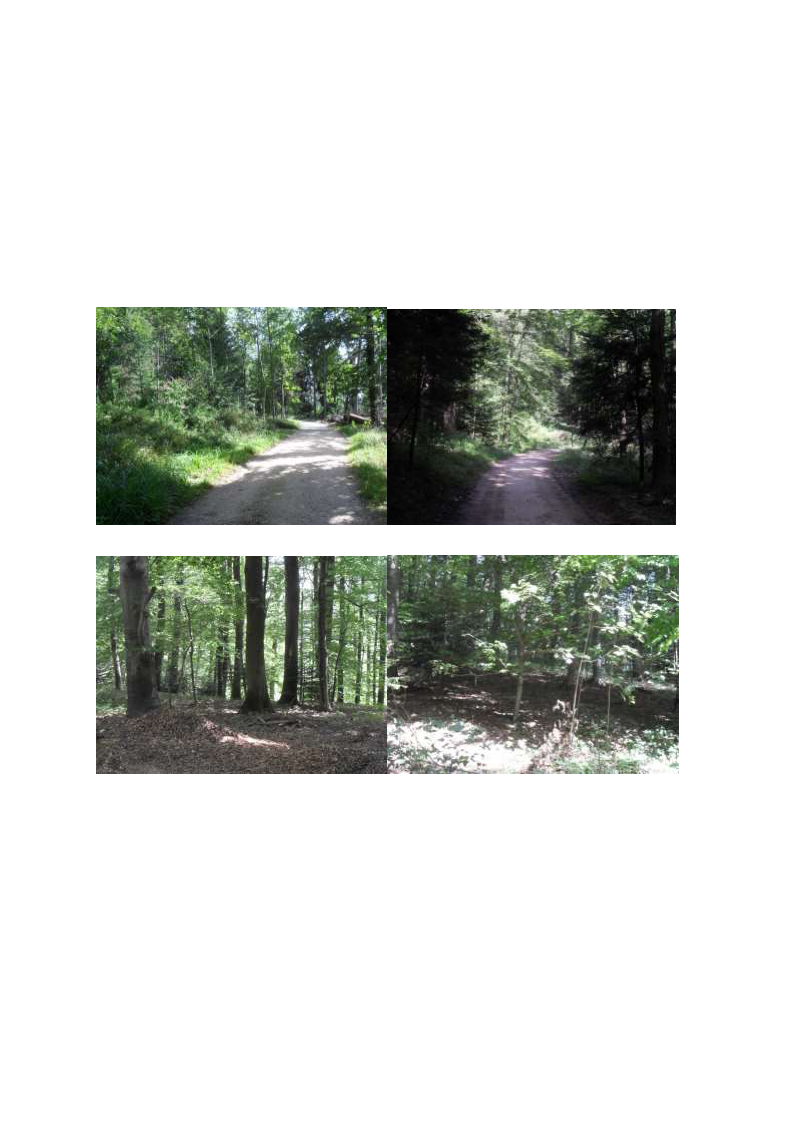
94
Interventions
The school has public woods with nature trails within 500 meters which was utilized
for the walk. It is heavily forested so when on the nature trails, only natural elements
are experienced; the woods are far enough away from any highways that no noise
external to the woods can be heard (see Figures 1-4).
Figures 1-4. Views of the Nature Environment.
Students were led on the walks by the researcher twice a week, immediately
following the school day for one hour. This was important in that following an entire
school day, the students would be in a state of cognitive fatigue, an element which
was mentioned as crucial in many of the precursor studies -- making sure that the
subjects were in a state of cognitive fatigue (Hartig et al., 1991). Therefore, no

95
artificial “cognitive fatiguing” activity was employed. It was a non-strenuous walk to
accommodate all students, regardless of physical fitness. A theme was proposed
each of the five weeks for students to focus on while walking (e.g. noticing visual
stimuli, noticing fragrances, etc.) which would encourage engagement with natural
elements. Participants were asked to turn off or silence any electronic devices. The
researcher purposely engaged in little conversation with students and usually
maintained a physical distance between the subjects and himself, although his
presence was required for health and safety considerations of the school age
population.
The study was run for five weeks from September through October to take
advantage of the relative warmth and sunny days in Switzerland at that time of year.
Additionally, the forest was still green, as the leaves fall in Switzerland towards the
end of October or November, thereby obscuring any built elements which could be
visible if the trees were leafless. Students took two nature walks per week: one on
Monday or Tuesday and the second on Thursday or Friday. These immediately
followed the school day. The walks were from 40 to 60 minutes depending upon the
pace the individual student took. While each walk began as a group, students ended
up walking individually or in dyads or triads for most of the duration of the walk. For
each of the five weeks, a theme was suggested for them to focus on centering on a
different sense: visual, auditory, olfactory, and tactile. (Appendix IV).
At the pre-intervention administration, the researcher distributed the d2 Test of
Attention answer sheet with the practice side facing upward (Appendix VI). The
standardized instructions script as found in the d2 Manual was employed in the
administration with no anomalies (Appendix VII). This administration gave the
baseline data for each participant on the d2 for comparison after the nature walk

96
interventions.
Also at the pre-intervention administration, a standard journal was distributed to each
participant. They were asked to record any thoughts, feelings or reflections regarding
the walks and make their entries as soon after each walk as possible. It was
reiterated that they could use words, pictures, drawings, etc, as each felt most
comfortable.
Subsequent to the nature walk interventions, immediately following the final walk the
same procedure was followed to measure their post-intervention d2 results. Each
participant was debriefed and given the Debriefing Document. (Appendix V). In
addition, journals were collected in the days following. Nine journals were returned
for analysis, as two students chose not to record in their journals.
Results of both the quantitative and qualitative data were compiled and analysis was
conducted. (Appendix VIII & IX).
Quantitative
d2 results were tabulated using the standardized procedures for scoring as found in
the Test Manual.
Qualitative
Upon completion of the nature walk interventions, students returned the previously-
provided journals in which they had been asked to record their thoughts and
reflections immediately following or by the end of the day of each walk. Nine of
eleven participants chose to record in their journals and returned them following the
intervention period. The journal entries were transcribed into digital format and then
inductive content analysis was employed first using the writewords.org.uk website,

97
and then manual interpretation of the data. Content analysis involves the analysis of
text allowing the identification of themes and inductive content analysis allows
themes to emerge from the text rather than deductive content analysis where the
researcher is only looking for specific topics. Inductive content analysis is considered
theory generating while deductive content analysis is considered theory testing
(Braun and Clarke, 2006; Elo and Kyngas, 2008; Franzosi, 2008, pp. 549-563).
Results were transcribed into an electronic format for ease of analysis. Inductive
content analysis was employed for this study, as mentioned above, to allow themes
to emerge from the participants’ own voices. Inductive content analysis introduced
an objective measure into the interpretation of the data. This consisted of using word
count software.
Next, the data was explored and themes were identified. There are competing and
sometimes contradictory positions in the literature regarding where inductive content
analysis ends and thematic analysis begins. Braun and Clarke take the position,
mistaken in my opinion, that themes cannot “emerge” from the data. While they
rightly call attention to the fact that experimenter bias is always a possibility, taking
their position to the extreme would discount any interpretation of qualitative data as
any researcher, regardless of how objective they try to be, would inject their own
biases, and any theme identified could be just a projection of the researcher.
However, this extreme position negates the very voice of the subjects’ experiences
by denying that the themes can reside in the data to be discovered by the
researcher. For if the themes are not “residing” in the data collected from the
subjects, where is their voice? Their only voice is contained in the words which they
choose to share. Steps can be taken to minimize the experimenter bias and indeed
identify the themes that do “emerge” and which “reside” in the data, for example by

98
using inductive content analysis in the first case.
While Braun and Clarke have the most prescriptive model of how to engage in
thematic analysis, there are a variety of other models and opinions in the literature,
ranging from inductive content analysis being identical to thematic analysis, “So CA
and TA can be very similar/identical….:it depends on how people make sense of,
and use, both of these methods.” (https://www.psych.auckland.ac.nz/en/about/our-
research/research-groups/thematic-analysis/frequently-asked-questions-8.html), to
differing simpler applications, to Braun and Clarke’s own admission: “Thematic
analysis is a poorly demarcated and rarely-acknowledged, yet widely-used
qualitative analytic method (see Boyatzis, 1998; Roulston, 2001) within and beyond
psychology.” (Braun and Clarke, 2006). Therefore, the model utilized was Millward
(2006) from Research Methods in Psychology. (Millward, 2006).
The results of the inductive content analysis were then used to help identify themes
which emerged from the data. As noted above, this was to minimize experimenter
bias in the identification of such themes. This information, taken along with reading
and rereading the journals allowed the identification of the themes emerging from the
subjects’ experiences during the nature walk interventions.
Taking this information and re-reading the journals paying especial attention to the
most frequently used terms revealed two main themes from the participants: 1.
comments noticing affective changes as a result of the nature walks, and 2.
comments noticing cognitive changes as a result of the nature walks.
My role and reactions
My goal and desire in this endeavour was and is to end up helping people improve

99
their lives. Building from my anecdotal life experiences of the restorative power of
natural settings inspired me to pursue this particular research project.
While my decision to participate on the nature walks was mainly motivated by the
health and safety factor with regard to the participants, it was fortunate that that is
how the procedure worked out. In spite of being the researcher on the project and
overseeing the participants during the walk, I was able to feel a sense of recharge
and refreshment during each of them. For me personally, I felt both stress relief and
a restoration of my attention capability. While never formally diagnosed with ADD, I
believe that I have exhibited those tendencies throughout my life and this experience
confirmed for me the ability of nature to help soothe and calm me at the end of a
particularly stressful day. It was gratifying, too, to witness this calming effect taking
place in the participants as it was occurring. Because of that, the results scored and
recorded by the participants were not surprising. I think my most meaningful
moment, albeit anecdotal, was at the end of one of the nature walks when one of the
participants who had complained of a headache at the beginning of the walk (and I
had offered to let her skip the walk in case it was too much for that day) said that by
the end of the walk that the headache had gone away completely. As it appeared
that the participants were outwardly benefitting from the nature walks as originally
conceived, no adjustment to the procedures were deemed to be necessary or
desirable during the course of the research project.
When one is part of the research, sometimes results can challenge the assumptions
that the researcher originally held. That was not the case here. The research rather
confirmed these beliefs which further strengthened my resolve to fully implement for
myself, and encourage others to benefit from, nature by immersing themselves in as
much of it as they can as often as they can.

100
Chapter 4
Results
In this chapter I will report the results obtained from the research project. This
research project employed Mixed Methods and therefore the results will need to be
presented and analysed consonant with this approach. Mixed methods gives greater
depth to the meaning of the results obtained by considering quantitative and
qualitative results and also cross correlating these results. Therefore, the data from
this research project has been subjected to the rigor of three different means of
analysis. Consequently, this chapter will present firstly the analysis of two different
scales from the d2 Test of Attention which was the quantitative measure. Secondly,
thematic results will be presented and analysed as extracted from the individual
participants’ journal entries for the qualitative analysis. Thirdly, each individual
participant’s quantitative and qualitative results will be individually integrated to
determine if the quantitative and qualitative data reinforce one another, followed by
an analysis of these integrated results.
Research Question: To what extent do nature walks have a positive impact upon
psychological health specifically cognitive attention?
Hypothesis H1: Nature walks will result in a statistically significant improvement in
mental acuity as measured by the d2 Test of Attention and related qualitative
reports.
Null Hypothesis H0: Nature walks will not not result in a statistically significant
improvement in mental acuity as measured by the d2 Test of Attention and related
qualitative reports.
Quantitative Data Analysis
Two measures of the d2 were utilized for this analysis -- the Total Number processed
(TN) and the Concentration Performance (CP). The TN reflects the speed of
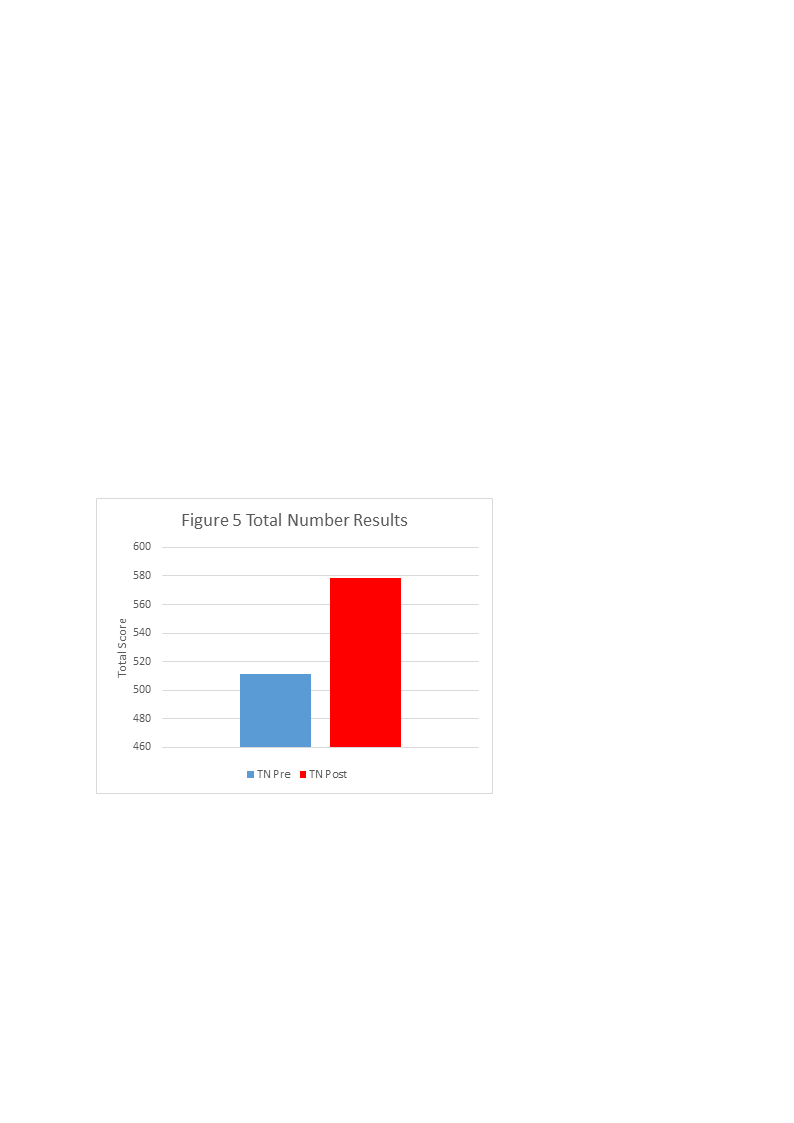
101
processing while the CP reflects the accuracy. Total Number scores can range from
215 to 652 according to the norming tables while CP scores could range between 16
and 298.
The pretest mean for TN was 511.5, with a range between 426 and 602 and the
posttest mean was 578.5 with a range of 502 to 652, demonstrating a notable
increase in total items completed. The pretest mean for CP was 212.2, with a range
between 173 and 268 and the posttest mean was 251.7, with a range of 210 to 298,
again a notable increase in accuracy of completion. As the focus of this study was
only analyzing individual participant changes, group measures of variability would
not be relevant.
Figure 5. Total Number (TN) Pre and Post Intervention

102
Figure 6. Concentration Performance (CP) Pre and Post Intervention
The raw data reflected an observable difference between pre nature walk and post
nature walk performances on both measures. (see Appendix IX).
For the TN, ten of eleven participants demonstrated an increase in number of items
completed and for the CP, ten of eleven participants demonstrated an increase in
items completed accurately. In the TN, the participant who declined in total items
completed, did increase their CP which indicates an improvement in accuracy post-
test. In the CP, another participant increased their TN, but their CP declined which
was anomalous with the rest of the group results. Upon more detailed analysis, this
anomalous CP result was brought about by the participant completing fewer answers
(slower speed) and committing fewer errors post vs. pre, but still because their
overall total items marked through declined slightly, their CP declined, but their
accuracy for items completed increased, which is not reflected in any of the
subscores.
With the TN, further analysis revealed that the majority of the participants pre
intervention began with a median percentile rank of the 88.5th percentile and ended

103
with a median of the 96.9th percentile. The only outlier scored in the 50th percentile
pre and ended in 95.5th percentile post. Excluding the outlier, this means that
participants began with percentile ranks between 69.2 and 99.2 and ended with
percentile ranks between 81.6 and 99.9 highlighting the large improvement in spite
of relatively high pre intervention results. Except for the outlier, no matter where a
subject began, all ended up in the 90th to 99.7th percentile. The outlier who actually
declined did not score so highly that no improvement was possible (94.5th
percentile), as another participant who began at the 99.2nd percentile actually
improved to the 99.7th percentile pre/post.
For the CP the median percentile rank began at the 72.6th percentile pre-
intervention and ended up at the 97.7th percentile post-intervention. Three outliers
here showed remarkable increases: #5 -- 34.5th percentile pre and ending with
84.1st percentile post; #9 -- 50th percentile pre and 96.4th percentile post; #8 --
61.8th percentile pre and 97.7th percentile post. Once again, except for the outlier
who declined (who was a different subject from the anomalous TN score mentioned
previously), all participants ended up in the 90th to 99.9th percentile no matter where
they started from, again highlighting the notable increase in this measure.
Statistical Analysis
A t-test for paired samples was used to compare the group results as this experiment
employed a repeated measurement design with the participants’ results compared
before and after the intervention. This was calculated for both the TN and the CP,
and verified using the Laerd Statistics online calculator. For the TN, the t-test for
repeated measures t=4.17, df=10, p<.001 and for the CP, the t-test for repeated
measures, t=5.107, df=10, p<.0002. (Appendix IX).

104
Therefore, based upon these quantitative results we can reject the null hypothesis
(H0) and accept the research hypothesis (H1) that nature walks had a statistically
significant positive impact upon mental acuity as measured by d2 scores. While this
provided a quantitative data set to the research study, qualitative data adds the
participants’ individual experiences and insights while this process was occurring.
Research Question: How do participants describe the nature walk experience?
Qualitative Data Analysis
Participants were given a numbered journal and asked to record their thoughts and
reflections immediately following or by the end of the day of each walk. Nine of
eleven participants chose to record in their journals and returned them following the
intervention period. Results were transcribed into an electronic format for ease of
analysis. Inductive content analysis was employed for this study, as mentioned
above, to allow themes to emerge from the participants’ own voices. The use of
qualitative data will add richness and depth of meaning to the results obtained from
the quantitative data.
In the initial reading through all journal entries, it became clear that all
participants had experienced some sort of psychological improvement which they
attributed to the nature walk intervention. By having such a small sample size,
individual results and nuances can be explored for each participant which would not
be possible in a larger study. Examples from each journal follow here:
Participant #2:
“I observed my surroundings, the forest, the trees, some flowers and how the
sunshine passed through and illuminated the leaves. It was quite beautiful. This way,

105
by being in such a calm environment, with no rush or anything special to do, I felt
more relaxed, with less pressure and more awake.”
Participant #5:
“In the woods it was beautiful and I forgot every little thing that was bothering me, I
felt at peace with the whole world, but especially with myself.”
Participant #6:
“Today’s walk was very nice and relaxing; it was the most enjoyable walk and it was
stress-releasing.”
Participant # 7:
“I believe the walks provided a calm and relaxing atmosphere after such hectic days
at school. It helped take my mind off things for awhile before continuing with school
work. I would continue these walks as I felt ‘at peace.’”
Participant #8:
“I had a busy day in school today and felt tired, almost unwilling to do the walk.
Nevertheless, after the walk I seemed to feel energized again and ready to do more
work. It seemed a little break from everything had helped me to concentrate better
afterwards.”
Participant #9:
“The walk today was enjoyable and I feel that it had an effect on my mindset. I felt
calm during the walk and also afterwards. When I arrived back at school, I reflected
on the walk which also helped. I look forward to the walks as it feels as if there has
been a difference in my mental state afterwards.”
Participant #10:
“Once again I found the walk very relaxing and felt calm after it had finished. After

106
the walk I also felt quite attentive and awake. I have noticed this on most of my
walks. This has enabled me to work more efficiently at home.”
Participant #13:
“I was distracted (in a good way) and forgot about what had been on my mind
before. Everything smelt quite fresh because of the rain but it was very humid.”
Participant #15:
“I always look forward to these walks now. I noticed that all the stress from school
and all the work that had been building up inside of me, gradually got less, the more
we walked.
I find these walks nice and calming.”
More in-depth analysis was conducted using inductive content analysis. To
begin with, a word frequency counter was employed and then common pronouns,
verbs, common adjectives and articles were excluded. Herewith follows the
frequency chart for the remaining keywords (Complete analysis in Appendix VIII):
Word
relaxed/relaxing
stress/stressed/stressing
nature
relaxed
enjoyed
mind
woods
mood
concentrate
calm
Frequency
27
22
18
16
15
13
11
10
10
10

107
Taking this information into account, the journals were then re-read noting
particularly how these ideas/concepts/nouns/adjectives were used in sentences
(positively/negatively/neutral, etc.) to give greater context to these terms and allow
the identification of themes.
Two main themes emerged from the participants. All participants reported noticing
either some form of affective change or cognitive change or both. Those who
experienced both mentioned a simultaneous improvement in both affect and
cognitive focus. These themes will be further explored below via the following
specific categories.
Subtheme #1 Relaxation: (Theme of Affective Change)
Without exception, all nine participants mentioned the word relax or a variant of it in
their journal entries. Some used it only once, but many of them multiple times. In all
cases when it was mentioned it was in the affirmative sense of experiencing
increased relaxation after the nature walks which they directly attributed to the walk
in the woods. Relaxation is a complicated concept in that it can involve components
both physical and mental. Usually seen as a bidirectional relationship, participants in
this study as well as others, generally do not distinguish between them or report the
physical and mental effects as occurring simultaneously. In addition to the examples
cited in the introduction to this section, the following reflect comments regarding the
theme of relaxation:
Participant #5:
“I am also more calm at home and I am able to relax more and I am starting to learn
how to clear my mind also without these walks which is due to those nature walks.”

108
Participant #8:
“Today I felt like I wanted to relax during the walk and enjoy the surrounding
environment. I believe it is equally important to have fitness some days but on others
just to relax and take a short break from school-life, etc.”
Participant #9:
“The walk may have subtly relaxed me, and it felt as if the relaxed mood was
sustained throughout the evening.”
Participant #13:
“I felt way more relaxed than usual when we’re on the walks.”
Participant #15:
“Taking walks generally clear my mind and I find myself very relaxed afterwards.”
Subthemes #2 and #3 Stress; Mental Acuity (Themes of Affective and Cognitive
Change)
Stress is a difficult concept to parse as it has both a physiological manifestation as
well as a cognitive/affective component. There is no clear consensus regarding
these interrelationships and stress is generally seen as having bidirectional
relationships between the physiological and cognitive/affective elements. ”Most
contemporary researchers believe that an adequate definition of stress must take
into account the interplay between external stressors and our physical and
psychological responses. This relationship is neither simple nor predictable, for it
varies from person to person and from day to day.” (Parker and Ettinger, 2010).
Subjects noticed conscious improvements in focus, attention and concentration or
mental acuity which were noted in differing ways by different subjects as reflected in
the following entries.

109
These four subjects reported an explicit link between the reduction of stress and their
ability to concentrate and focus.
Participant #5
“Every time I come back home, I feel calmer and less stressful, I am able to
concentrate and work better.”
Participant #6 (after taking the d2 for the second time):
“As for the concentration test, I did notice a difference. I think I did better on this test
than on the first one…”
Participant #8:
“Nevertheless, afterwards I always find myself refreshed not only physically but
mentally as well.”
Participant #15:
“Today I knew I had a lot of homework to finish after school and I felt very stressed
because I really had no idea where to start. This walk was very helpful because after
I had a clear mind and was therefore able to concentrate better on what I had to do.
The walks are generally just helpful, because it gives me a break from school and
the homework I normally do right after.”
Participant #9 explicitly connected mood, stress, and concentration. This particular
subject benefited from increased mental acuity whether experiencing an
improvement in mood or not. This suggests that cognitive refreshing played a role in
the ability to better focus mentally.
Participant #9:
“The nature walk was also interesting as it is nice to be fully surrounded by plant life.
I did not notice a dramatic change in mood, however as the evening progressed, I

110
found myself to feel more comfortable. Completing homework assignments also felt
a lot easier.”
“I was previously anxious about a maths test tomorrow, although the walk helped me
to concentrate when revising.”
“Today the walk was effective at improving my mood, stress levels and general well-
being….The walk improved my state of mind and made me look forward to the next.”
For Participant #10, while not stated explicitly, it is implied that the nature walk
helped with their concentration:
Participant #10:
“Once I got home I began to revise for my biology test which is in a few days. I found
revising today much easier than when I did it yesterday despite having less time than
yesterday. I was able to concentrate quite well when revising and so took in a lot of
information.”
Integration of Quantitative and Qualitative Results by Participant
Thus far, we have examined the qualitative and quantitative data discretely. While
this has value, it is also important to consider if there is correlation within each
participant between the quantitative and qualitative results. So, in the following
analysis, the qualitative reports will be paired with each participants’ quantitative data
in order to give depth of meaning and understanding to the previously identified
improvement in performance from that quantitative data. The significance of these
results can only be seen by an examination of each subject’s results, rather than
group analysis, which could dilute the significance of an individual’s impressions or
numerical data. Amalgamating results, as well as only reporting representative

111
comments, risks losing the subtlety and nuances of the participants’ experiences,
particularly as reflected in their qualitative comments. The following analysis, similar
to a case study approach, is one of the major contributions to the literature that this
study makes in that it juxtaposed completely open-ended qualitative data with
quantitative data and was able to be analysed on a subject by subject basis in a real
woods setting, which does not appear to have been reported in previous research.
Participants’ results are reported in rank order of net change on the CP, which is a
better indicator of increase in mental acuity by measuring accuracy, not just speed.
Eight out of nine participants who kept a journal consciously noted some sort of
improvement based upon the walks. Only Participant #13 deviated from these
results: “I enjoyed the walk, but I’m not noticing any difference in how I feel on days I
have the walk and days I don’t.” His/her quantitative data showed improvement, but
s/he did not attribute this improvement to the intervention.
Participant #10
Pre/Post CP
212/278
Net Change +66
Pre/Post TN
509/612
Net Change +103
Participant number 10 exhibited the largest increase in CP pre/post testing and
fourth highest increase in TN pre/post.
This participant not only showed the largest increase in the CP, they also noted
improvement in multiple areas of psychological health and well-being over the
course of the walks which included improved affect, improved mood, decreased
stress, improved concentration, and even recovery from a headache during one
particular walk.

112
This participant recorded the following thoughts:
Entry #1: “Today was the first walk. To my surprise, I quite enjoyed it, more than I
thought I would. I found that walking in the forest/nature is very calming and relaxing.
After a long day at school, this walk helped me to relax and to remove the anxiety
and stress that I had before.”
Entry #2: “Today was the second walk. After a test, it was nice to unwind by walking
through the forest.”
Entry #4: “Today was the fourth walk…..I felt very relaxed during and after the walk
despite having a lot of work to do. Although I got home an hour later than I normally
do, I didn’t feel stressed at all about having to do lots of homework. I just got on with
it.”
Entry #5: “Once I got home I began to revise for my biology test which is in a few
days. I found revising today much easier than when I did it yesterday despite having
less time than yesterday. I was able to concentrate quite well when revising and so
took in a lot of information.”
Entry #6: “Today was the sixth walk. During the walk I noticed that I felt quite happy
and optimistic more so than at school or at home. Although, I had much to do when I
got home, I knew that it would be OK so I would be able to get it all done. These
problems that I often have were cleared away during the walks.”
Entry #7: “I noticed that some of the trees have begun to shed their leaves. On other
trees the leaves have begun to change colour from green to yellow. I had a
headache for most of the day, but after the walk I forgot about it and the pain simply
went.”
Entry #8: “Today was the eighth walk. The weather was quite nice. Once again I
found the walk very relaxing and felt calm after it had finished. After the walk I also

113
felt quite attentive and awake. I have noticed this on most of my walks. This has
enabled me to work more efficiently at home.”
Participant #8
Pre/Post CP
199/263
Net Change +64
Pre/Post TN
474/597
Net Change +123
Participant number eight showed the highest increase in TN pre/post testing, and the
second highest increase in CP among the group.
This participant explicitly connects the walk in the wood and attributes the
disconnection from the “outer world” to allow them to be “refreshed” and noticed
stress relief.
Participant eight reflected on these changes throughout the intervention period:
Entry #1 (after first walk): “However, the walk did ease my mind of school and stress
and let me be a bit of myself…”
Entry #4: “I enjoyed the smell of the woods we walked in, as it had previously rained,
and it seemed to refresh my brain and make me more active.”
Entry #6: “However, I had an urgent need to walk faster and get moving to release
some built up frustration during the day. I found that afterwards I had returned to
normality and was not frustrated with the experience earlier in the day.”
Entry #7: “Nevertheless, afterwards I always find myself refreshed not only
physically, but mentally as well.”
Entry #8: “Sometimes, having time for yourself allows you to think, reflect and be
detached from work to relieve stress.”

114
Participant #16
Pre/Post CP
236/298
Net Change +62
Pre/Post TN
537/652
Net Change +115
Participant #16 had both the third highest increases in both CP and TN.
Unfortunately this participant did not complete a journal.
Participant #9
Pre/Post CP
178/235
Net Change +57
Pre/Post TN
426/547
Net Change +121
Participant number nine had the fourth largest increase in CP and recorded the
following thoughts.
Notable among this participant’s reflection was the first walk where they noticed a
delayed effect from the walk, with an appreciable improvement in both mood and
focus as reflected by the ability to more easily complete homework assignments. For
this participant, the theme of delayed positive outcome continued with the final entry
that the “evening after the walk was also fun.”
Entry #1 (after the first walk): “I found the walk to be enjoyable. It felt as if I had left
behind the worries of schoolwork, etc. The nature walk was also interesting as it is
nice to be fully surrounded by plant life. I did notice a dramatic change in mood,
however, as the evening progressed, I found myself to feel more comfortable.
Completing homework assignments also felt a lot easier. The walk may have subtly
relaxed me, and it felt as if the relaxed mood was sustained throughout the evening.”
Entry #3: “The walk today was enjoyable and I feel that it had an effect on my
mindset...I look forward to the walks as it feels as if there has been a difference in
my mental state afterwards.”

115
Entry #4: “I feel that the walk today rid me of some stress.”
Entry #5: “Today the walk was effective at improving my mood stress levels and
general well-being. I found the walk to be relaxing and entertaining. My evening after
the walk was also fun…..The walk improved my state of mind and made me look
forward to the next.”
Participant #6
Pre/Post CP 228/280
Net Change +52
Pre/Post TN 529/623
Net Change +94
Participant number six recorded the fifth largest increased in both CP and TN. For
this participant, relaxation was the most common experienced condition as a result
of the nature walks.
Entry for Day #2: “I was also able to focus on the nature more and become more
relaxed than last time.”
Entry for Day #4: “This time I was more relaxed and I enjoyed the walk itself more.”
Entry for Day #7: “Today’s walk was very nice and relaxing; it was the most
enjoyable walk and it was stress-releasing.”
Participant #15
Pre/Post CP
220/263
Net Change +43
Pre/Post TN
519/594
Net Change +75
Participant number 15 had the sixth largest improvement in both CP and TN.
This participant also notes the explicit connection between “clearing out” their minds
during the nature walks and being able to focus and concentrate better afterwards.
Entry #1: “This was my first walk and I really enjoyed it….Taking walks generally

116
clears my mind and I find myself very relaxed afterwards. I also thought that walking
in the countryside in the woods was very different to what I usually do which is walk
in the city as I live there. I noticed that I also acted more freely in the woods than I
would in a more public place.”
Entry #2: “I always look forward to these walks now. I noticed that all the stress from
school and all the work that had been building up inside of me, gradually goes less,
the more we walked. I find these walks nice and calming.”
Entry #3: “Today I was really needing this walk, as I had a lot of tests just before and
I needed to ‘air out’”.
Entry #4: “I was acting a bit ‘out of myself’ today, and I sort of showed this here,
jumping all over the place. The reason as to why I was able to show this is because I
was in the woods, outside of town and away from school.”
Entry #5: “Today I knew I had a lot of homework to finish after school and I felt very
stressed because I really had no idea where to start. This walk was very helpful
because after I had a clear mind and was therefore able to concentrate better on
what I had to do. The walks are generally just helpful, because it gives me a break
from school and the homework I normally do right after.”
Entry #6: “This was my last walk today, unfortunately, and I definitely want to have
the opportunity to continue a walk a week.”
Participant #11
Pre/Post CP 201/239
Net Change +38
Pre/Post TN 484/553
Net Change +69
Participant number 11 demonstrated the seventh largest increases in both CP and
TN. Unfortunately, this participant did not complete a journal.

117
Participant #5
Pre/Post CP 173/210
Net Change +38
Pre/Post TN 547/502
Net Change -45
Participant number five demonstrated the eighth highest improvement in CP but
recorded an anomalous result in TN. While anomalous with regard to TN, their
improvement in CP, which is the measure of mental acuity, does indicate a result
consistent with the study’s hypothesis. It appears that their experience of the walk
was perceived by the participant as having a positive effect.
This participant repeatedly shares the explicit connection between experiencing
nature both via visual and olfactory means and their capacity to help them relieve
stress, improve emotions and even allow for being “at peace with the world.”
Entry #1: “Today was the first day of our nature walks...In the woods it was beautiful
and I forgot every little thing that was bothering me, I felt at peace with the whole
world, but especially with myself. I loved the smell of the wood and the smell of the
soil and the smell of the wet forest.”
Entry #2: “The second nature walk was different than the first. I believe this is due to
the fact that I am starting to know the area better. But the effect of the appearance
and smell of the woods wasn’t as overpowering as before On the other hand, the
effect of the walk had on me remained the same. The only change was that I was
able to focus more on myself and to make sure that for the time being I forget
everything that I was worrying or stressing about before. An example of this was that
I was very worried about the Celebration Evening and this walk helped me to re-gain
a hold on my emotions and to collect myself again. To be honest, it did work…..I
think that it started to have an impact on me already.”
Entry #7: “To be honest, I am really surprised of all the effect just walking in the

118
woods had on me, the effects on my mind and my body. People say that massages
help to calm down, but why spend money, when a walk in the woods can have the
exact same results, maybe even better. At the same time, these walks can open the
eyes to a different world in a different light and to different smells.”
Participant #7
Pre/Post CP
199/224
Net Change +25
Pre/Post TN
479/528
Net Change +49
Participant number seven showed the ninth largest improvement in CP and eighth
largest improvement in TN. This participant experienced an evolving opinion of their
effect, from skepticism to a description of a relaxing experience.
It is interesting to note the evolution of the effects of the nature walk on this
participant, beginning with the first walk where they do not notice any difference at
home after the walk to the fifth entry where they directly attribute an increased sense
of calm and relaxation to the nature walk.
Entry #1: “Today I went on my first psychological walk. It is hard to describe exactly
how I feel. I quite enjoyed the walk as I felt care-free. I did not really think of anything
stressful as I usually do when coming home from school such as homework or
upcoming tests. I enjoyed seeing the greenery and wildlife as I found them
interesting considering I do not usually go on nature walks. It was exciting to explore
the various paths we took during the course of the walk. Even though the experience
during the walk felt effective in relieving stress, I did not really feel any different to
what I would have felt normally when I got home.”
Entry #3: “As I go on more walks, the more I enjoy them….As the physical aspect
became easier, I started noticing more around me. Despite taking the same or

119
similar paths on every walk, many things went unnoticed. For example I was able to
observe and look out for wildlife and the different variety of plants and trees that
surrounded us.”
Entry #5: “I believe the walks provided a calm and relaxing atmosphere after such
hectic days at school. It helped take my mind off things for awhile before continuing
with school work. I would continue these walks as I felt ‘at peace.’”
Participant #13
Pre/Post CP
220/226
Net Change +6
Pre/Post TN
520/527
Net Change +7
Participant number 13 recorded the 10th largest improvement in CP as well as TN.
While the participant recorded a slight increase in both measures, the experience of
relaxation was not very profound.
This participant reported ambivalent results on the nature walk. Early on, the
participant reported more relaxation as a result of the walks, but in the 6th entry
(participant only made six journal entries) said that they did not notice a difference in
how they felt.
Entry #1: “I was distracted (in a good way) and forgot about what had been on my
mind before. Everything smelt quite fresh because of the rain but it was very humid.”
Entry #2: “I feel way more relaxed than usual when we’re on the walks.”
Entry #5: “I walk more slowly on these walks than when I’m walking round town,
school, etc.”
Entry #6: “I enjoyed the walk, but I’m not noticing any difference in how I feel on days
I have the walk and days I don’t.”

120
Participant #2
Pre/Post CP
268/253
Net Change -15
Pre/Post TN
602/629
Net Change +27
Participant number two recorded the only result not consistent with the research
hypothesis. The participant did increase in total number of items completed (TN), but
the acuity measure (CP) declined slightly.
There is some qualitative evidence from the participant’s journal that some benefit
was experienced, however:
Entry #1: “Today we went for the first walk in the woods. I enjoyed it quite much, it
feels good to do something like this after a long day at school.”
Entry #2: “Today’s walk was definitely different than last time. Today I was very tired
during school, I wasn’t in a good mood and felt a little homesick. During the walk I
thought calmly about things, everything that made me sad, angry or happy and
questioned why it was like this. I observed my surroundings, the forest, the trees,
some flowers and how the sunshine passed through and illuminated the leaves. It
was quite beautiful. This way, by being in such a calm environment, with no rush or
anything special to do, I felt more relaxed, with less pressure and more awake.”
Entry #3: “I was ill on Monday so I wasn’t feeling extremely well, but I enjoyed it
anyway. It’s always good to take some fresh air! If not, I’m all the time inside which
affects the mood.”
Entry #4: “Today’s walk was nice, the sun was shining but the temperature was quite
cold. I thought it was relaxing because I have a maths test tomorrow so it made me
think of something else and NOT school. I enjoyed the smell of the woods, very fresh
and in some parts it smelled like fire which reminded me of when I used to go to the
mountains when I was young.”

121
For this participant, in spite of the contrary quantitative result, some mood
improvement and relief of stress was experienced which lends support to the
research hypothesis when considering the qualitative data. As with some other
participants, it was noteworthy that the participant directly connected both the
viewing of nature and the scent of nature as contributing to their sense of relaxation.
Analysis and Interpretation of Integrated Quantitative and Qualitative Results
As can been seen from the above sections, when considering solely the quantitative
data, there was a statistically significant improvement in the group scores on the d2
Test of Attention which allowed me to reject the null hypothesis and accept the
research hypothesis and conclude based upon the quantitative data that the nature
walks had contributed to improved mental acuity.
Analysis of the qualitative results, the personal journals, allowed two major themes to
emerge, either improvement in affective or cognitive state; and three subthemes --
the conscious experience by participants of a reduction in stress, improvement in
mental acuity, and/or a general improvement in mood. In no case did a participant
report an opposite reaction to any of these conditions. Only one participant noted
that they did not feel either better or worse as a result of the walks, although this
participant did show improvement in both cognitive scales as measured by the d2.
A major advantage to engaging in research with such a small subject pool is the
ability to analyze the effect of the nature walk intervention on each subject
individually, as well as the group analysis. This is usually not possible with very large
subject pools where it would not be time or cost effective.
The final section, analysis by combining individual participant quantitative and

122
qualitative data, revealed that each subject improved in at least one quantitative
measure from pre to post (or in 9 out of 11 cases, both), but that each participant
explicitly connected the nature walks at some point with their ability to experience
stress reduction, or improvement in cognitive acuity, or in improvement in overall
mood, or a combination thereof. Therefore, rather than there being simply a
correlational relationship between the nature walk interventions and improvement in
some aspect of psychological health, using the journal entries where participants
reflected on changes they experienced, I can safely conclude that the nature walk
interventions directly impacted this improved state of mind or affect. This result is
consistent with previous similar antecedent research results achieved.
SUMMARY
● In summary, the quantitative results were analyzed statistically which allowed
for the null hypothesis to be rejected and the research hypothesis to be
accepted.
● The analysis of the group qualitative results revealed that each participant
directly attributed an improvement in mood, affect and/or mental sharpness to
the nature walk interventions.
● Finally, each participant’s quantitative and qualitative results were individually
combined and analyzed. For 8 out of 9 participants who kept a journal, the
quantitative and qualitative results mutually reinforced one another with
quantitative data indicating an improvement in attention and qualitative data
connecting these improvements to the nature walk experience.

123
Chapter 5
Discussion
This study examined the effect of a nature walk on a specific aspect of mental acuity,
that of attention. The questions the researcher asked were: “To what extent do
nature walks have a positive impact upon psychological health specifically cognitive
attention?” and “how do participants describe the nature walk experience?” These
questions required a Mixed Methods Approach as both quantitative and qualitative
data would need to be collected in order to answer these questions. The quantitative
hypothesis tested was that nature walks would result in a statistically significant
improvement in mental acuity, an aspect of psychological health, as measured by
the d2 Test of Attention. The quantitative data demonstrated a statistically significant
increase in attention after the nature walk interventions. The qualitative data
collected consisted of personal reflection journals in which subjects recorded their
impressions and experiences of the nature walks as they occurred, not
retrospectively. Similarly, eight out of nine participants who completed the journal
concluded that there had been an improvement in some aspect of mental acuity to
the nature walk intervention in their qualitative assessment journals, while all nine
attributed some improvement to the nature walks at some point during the five week
intervention. Thus both quantitative and qualitative data reinforced one another and
were found to support the research hypothesis.
Considering the specific results obtained on the d2 Test of Attention, 10 of 11
subjects demonstrated increased mental processing speed reflected in their TN

124
scales. When considering their accuracy in mental processing, 10 of 11 subjects also
increased their accuracy as measured by their CP scales.
Considering the results in the aggregate on both measures, the group demonstrated
improved post-intervention scores that were statistically significant compared with
their pre-intervention scores. Because of these results, this suggests that the nature
walk intervention improved an aspect of mental acuity, that of attention, and supports
the research hypothesis.
Further, the integrated data demonstrate the mutual support of the conclusion. The
quantitative data gave a snapshot of performance on a cognitive task at two fixed
points -- once before and once after the interventions. In this case the quantitative
results can be seen as “bookends” which support the rich, more detailed verbal
descriptions and impressions which the subjects experienced and recorded over the
course of the five weeks of intervention.
These results contribute to theory. Firstly, the improvement in cognitive ability as
recorded by the subjects’ performance on the d2 Test of Attention is consistent with,
and reinforces, previous research utilizing other instruments to measure various
aspects of mental acuity and supports the Attention Restoration Theory (Kaplan,
1995). Secondly, the direct attribution of this achievement (as well as improved
mood and emotional state) by the subjects to the nature walks, is consistent with
other research results.
But the unique features of this research include both the use of the d2 Test of
Attention to measure mental acuity and the use of the personal reflection journals to
record their experiences throughout the entire research period of five weeks. It is

125
believed to be the first use of either of these in this manner for this type of research.
It appears to be the first time that the d2 has been used in nature walk research,
even though it is used extensively in medical research and other psychological
research. Further, it appears that this is the first use of personal reflection journals
where subjects recorded their reactions throughout an entire five week intervention
period, not retrospectively, or via individual interviews.
Comparison with Literature Review
The results of this study are consistent with similar studies and literature regarding
the potential impact of a green intervention -- in this case a nature walk -- on one
aspect of psychological health -- that of mental acuity. As this research project was
designed based upon DeYoung’s 2010 original article suggesting nature walks be
used to help restore mental vitality and making specific suggestions of the criteria for
the walks, these results can be juxtaposed with his suggestions for “many
researchable issues with theoretical and practical implications” (p. 19).
His criteria included a few basic prescribed conditions. The first was “simply to walk
in a natural setting.” (p. 19). This was accomplished by conducting the nature walks
in a nearby wood which, fortunately, were thick enough and removed enough that
outside noises or built environments did not enter the participants’ earshot or
eyeshot during the treatment, yet near enough to the school to be accessible with
only a short walk.
His second criterion included the preference to walk alone. As noted in the
methodology section, small groups of students were guided on each walk for a
variety of reasons including health and safety concerns. However, during most every

126
walk subjects either walked alone or in dyads or triads, and even then, usually
engaging in relatively little conversation, much of which was directed at observing
the surrounding environment which DeYoung notes: “....if the social interaction is
itself engaged in noticing nearby nature, then the conversation might help both
individuals to dwell more deeply in the setting and thus gain additional restoration.”
(p. 19).
A third criterion was the suggestion that perception should be directed toward the
surrounding natural features in order to maximize the restoration effect. This was
accomplished by having a suggested theme for each walk that alternated between
the various senses (see Appendix IV). As an alternative to the above, meditation
while walking was also suggested as a possibility for research but since DeYoung
speculates that it might be effective but for different reasons, it was felt that would be
most appropriate for a separate research project.
His final point regarding the possibly disruptive effects of electronic technology
during the walk was observed. All participants were asked to silence (and even turn
off the vibrate feature) all electronic devices in order to disconnect from possibly the
very sources of stress which the project was seeking to measure.
His final researchable question dealt with how much and how often the nature walk
should occur: “More research is needed to answer this question, but findings suggest
that restoration may result from exposure to very limited amounts of nature.” (p. 20).
The decision to use a two-times a week for five week schedule for the subjects was
based upon the researcher’s estimate of an efficacious timeframe since this was a
novel investigation into these particular criteria. This was consistent with another
nature walk research project which took place over a period of weeks (Johansson,
Hartig and Staats, 2011) yet shorter than another study over a 10 week period

127
investigating aesthetic appreciation and nature walks (Diessner, Woodward, Stacy
and Mobasher, 2015).
In addition to DeYoung’s research, the results achieved were similar to Hartig et al.’s
2003 study comparing urban versus nature walks using university students. This
piece of research helped establish the concepts of the content of the walk having an
effect upon the subject using a variety of measures, although using differing
instruments and a different population group (Hartig: university students and all
Americans). The current research extended their findings in a number of significant
ways: firstly, by specifically examining nature walks with a multicultural group of 16-
18 year olds in Europe; secondly, working with 16-18 year olds who are TCKs and
finally, using the d2 Test of Attention as the psychological instrument to measure
mental acuity improvement, all novel aspects in this area of research. It is believed
that this is the first project in nature walk research in Ecopsychology to utilize the d2
Test of Attention.
This study further expanded upon a number of seminal research studies which relied
upon correlational measures of observing nature from various settings. Tennessen et
al. (1995) examined the effect of the view from a college dormitory window; Wells in
2000 examined the effect on cognition of school students’ views from their homes;
Kaplan in 2001 examined Attention Restoration Theory of adults based upon the
views from their apartment windows; and Pretty et al. in 2005 examined the effect of
taking exercise while viewing green scenes. All of these found a benefit to those
observing nature scenes but did not involve direct exposure to the nature
environment. The current research advanced these concepts by immersing the
subjects in an actual nature setting while attempting to demonstrate a cause and
effect relationship rather than an observational/ correlational result.

128
Additionally, it is believed that this is the first research to specifically target, not just
16-18 year olds, which it does, but also the first to examine the effect of nature
interventions with Third Culture Kids. This may seem a limited grouping to consider,
but the trend in growth is continuing, meaning this population will continue to
increase (Hayden and Thompson, 2008). It seems that Ecopsychology and green
interventions may be able to assist in some of the attachment issues unique to these
TCKs, as reflected in some participants’ observations and comments.
Limitations
While this study did reveal significant results which have addressed a gap in the
literature, it is important to address limitations to the study. The first limitation is the
sample size. While 11 was a significant number of the population made available to
the researcher (out of a possible 85 school students), this is simply not a large
enough sample to make a conclusion to the general populace without further
replication.
Further, due to resource limitations, this was a self-selected group. Generalizability
of research is always improved by the ability to engage with randomly selected
subjects. Additionally, while it was a multinational pool of subjects, they were all
Western Europeans, and therefore share a level of homogeneity in culture.
While the focus was on Third Culture Kids (TCKs), a subject group not examined in
any of the previous literature, it must be acknowledged that universally, TCKs tend to
be students of means and therefore may not truly represent all the characteristics of
their passport nationalities such as socio-economic status and cultural connection.

129
While the lack of a control group might prove problematic for a purely quantitative
study, the same is not the case for a Mixed Methods research project. Rarely, if ever,
does a qualitative study employ the use of a control group for comparison, as the
purpose of a qualitative study is to understand a subject’s unique perspective and
internal psychological processes of the phenomenon being studied. Examining this
data in this research project revealed that all subjects at some point during the
nature walks intervention clearly identified a link directly between an improved
mood/emotion/cognition and the nature walks themselves. Further, the quantitative
results reinforced the subjects’ impressions of improved cognitive ability as
demonstrated in their performance results on the d2 Test of Attention. Further, the
question of the efficacy of nature walks was not in question. The literature agrees
that nature walks have overall positive impacts. Rather, the goal was to examine
specific effects of the nature walks. To that end and in consideration of the above, a
control group was not employed. However, a control group could have given a
comparison to a similar population’s change over the five week intervention on the
quantitative measure. In this instance, though, that would have given an
unacceptably smaller subject pool of 5 or 6 in the control group and only 5 or 6 in the
intervention group.
Finally, the subject of confounding variables which may have served to help improve
the subjects’ performance on the d2 could not be controlled as the study took place
over a five week period. For any research project intervention which takes place
more than once, this will continue to be a challenge for future researchers. However,
this concern was also partially mitigated by the use of Mixed Methods research
wherein the subjects reported qualitatively during the course of the nature walk

130
interventions that they felt that the walks themselves were a contributing factor to
their improved focus ability.
To summarize, this Mixed Methods research finding has demonstrated that subjects
described and exhibited results that confirm that nature walks helped to improve
restoration, not just of attention, but also other aspects of psychological health, in a
population of 16-18 TCKs

131
Chapter 6
Conclusion
Implications for Future Research
The findings and limitations of this study indicate the need for additional research
regarding the efficacy of nature walks on human psychological health and well-being.
There are many directions which this research can be extended. While this was a
relatively short-term intervention of only five weeks, the question arose in the
researcher’s mind what the least amount of treatment or intervention could be
effective, as well as, if there was a point of diminishing return. For the former, an
intervention of one nature walk could be the experimental condition and the mental
acuity measured immediately before and immediately following. For the latter, the
intervention could be extended to an entire semester or even school year to measure
if there is a point of saturation, but with the added concern of confounding variables.
Another suggestion for a follow up study would be to increase the sample size and
improve the means of selection to include random sampling. Both of these would
improve the generalizability of the results. Further, the use of a control group of
similar subjects could be used to compare the changes in mental acuity and perhaps
more precisely discern the change due specifically to the nature walk intervention.
While a larger sample size is desirable, the most optimal situation would be the
involvement of 16-18 year old students from differing backgrounds and cultures,
including those from more collectivist and less Western individualist cultures. Further
diversity in the sample size on many levels would make the results even more
generalizable -- this would include socio-economic background, education level, and
ethnicity.

132
Additional research into mental acuity could utilize measurements of the other
aspects of acuity: memory, focus, concentration and understanding, but still
examining only one of these at a time to answer the calls in research to have more
directed quantitative research in order to attempt to establish specific cause and
effect.
All of the above deal with measurements of the effect on mental acuity, but there is
an entire other realm of measuring the nature walk impact upon the affective side of
human personality. While the intervention (nature walk) would be similar, the
measurements would focus on the emotions and feelings, rather than on the
cognitive processes. In order to answer the call in literature for more objective data
to supplement the qualitative data, physiological or observational measures could
supplement the more subjective questionnaires or journals of participants.
Practical Implications
These results support the introduction of green interventions into a school curriculum
in order to improve psychological health and well-being. Just as pressures are
mounting for adults in the world, pressures are also mounting for students as high
stakes testing encroach further and further into the school curriculum, in many
different places. Additionally, while technology has improved many aspects of
education, it has also introduced additional stressors for children such as
cyberbullying. Therefore, green interventions could be implemented to help to
ameliorate these negatives. These interventions could take many different forms
depending upon the setting and resources available to each school.

133
In my working with high school students, the results gave impetus into a continuing
after-school Eco Walks for Wellness programme in which students chose to
participate. Based upon the demonstrated results, students were able to have a brief
mental recharge time to refocus and escape the built environment which helped
them restore mental vitality and improve their psychological well-being.
It is recommended that high schools adopt, to the extent possible, but recognizing
possible limitations due to their geographical settings, a similar programme which will
have obvious benefits to their student populations, namely a chance for them to
mentally re-charge and re-set -- to re-focus their attention, on a regular basis. If the
nearest natural greenspace is not within a practicable distance, a regular outing
should be considered to become part of the student wellness plan. Finally, as
schools are being developed, planned or renovated, provision should be made for
adequate and appropriate greenspace. This could consist of the simplest collection
of shrubbery and trees to more elaborate greenspaces allowing for students to meet
and congregate.
Additionally, building upon the results from this as well as the previously cited
studies, the introduction of nature scenes should be considered in urban school
environments which lack any access to natural green space. While not a substitute
for an actual nature experience, the direction of research in this area indicates that
even in simply viewing representations of nature, subjects may show improvement in
aspects of psychological focus and health.

134
Imperfect an analogy as it is, periodically our computers need to be shut down down
to clear out their RAM (random access memory); similarly, the human brain needs to
be able to switch off, clear out, and refresh. Sleep accomplishes some of this re-
setting; nature walks are a positive way to benefit students during their waking hours,
however. As evidenced by this research as well as the growing body of literature,
nature contact facilitates this recovery and thereby contributes to a student’s mental
vitality.

135
LIST OF REFERENCES
ABERLEY, D., 1999. Interpreting bioregionalism. In: M.V. MCGINNIS, ed, Bioregionalism.
Routledge, pp. 13-42.
ALBRECHT, G., SARTORE, G., CONNOR, L., HIGGINBOTHAM, N., FREEMAN, S., KELLY, B., STAIN,
H., TONNA, A. and POLLARD, G., 2007. Solastalgia: the distress caused by environmental change.
Australasian Psychiatry, 15(Supplement), pp. S95-S98.
AMERICAN PSYCHOLOGICAL ASSOCIATION, 2013. Stress in America: Missing the Health Care
Connection. Washington, DC: American Psychological Association.
BAGNALL, N., 2012. National or global: The mutable concepts of identity and home for
international school students. Prospects: Quarterly Review of Comparative Education, 42(2), pp.
177-181.
BATES, M. and LEMAY, E., 2004. The d2 Test of attention: construct validity and extensions in
scoring techniques. Journal of the International Neurological Society, 10(3), pp. 392-400.
BERMAN, M.G., JONIDES, J. and KAPLAN, S., 2008. The Cognitive Benefits of Interacting with
Nature. Psychological Science, 19(12), pp. 1207-1212.
BERTO, R., 2014. The Role of Nature in Coping with Psycho-Physiological Stress: A Literature
Review on Restorativeness. Behavioral Sciences, 4, pp. 304-409.
BISHOP, F.L., 2015. Using mixed methods research designs in health psychology: An illustrated
discussion from a pragmatist perspective. British Journal of Health Psychology, 20(1), pp. 5-20.
BOWLER, D., BUYUNG-ALI, L., KNIGHT, T. and PULLIN, A., 2010. A systematic review of evidence
for the added benefits to health of exposure to natural environments. BMC (Bio Med Center) Public
Health,10(456), pp. 1-10.
BRATMAN, G., HAMILTON J. PAUL and DAILY, G., 2012. The impacts of nature experience on
human cognitive function and mental health. Annals of the New York Academy of Sciences,
1249(1), pp. 118-136.
BRAUN, V. and CLARKE, V., 2006. Using thematic analysis in psychology. Qualitative research in
psychology, 3(2), pp. 77-101.
BRICKENKAMP, R. and ZILLMER, E., 1998. The d2 Test of Attention. 1st US edn. Cambridge, MA:
Hogrefe & Hubler Publishers.
BRYMER, E.G., CUDDIHY, T. and SHARMA-BRYMER, V., 2010. The role of nature-based
experiences in the development and maintenance of wellness. Asia-Pacific Journal of Health, Sport
and Physical Health, 1(2), pp. 21-27.
BUZZELL, L. and CHALQUIST, C., eds, 2009. Ecotherapy. 1st edn. San Francisco: Sierra Club
Books.
BUZZELL, L. and CHALQUIST, C., 2015. Ecopsychology and the Long Emergency: Fostering Sanity
as the World Goes Crazy. Ecopsychology, 7(4), pp. 183-184.

136
CASCADIA NOW, January 8, 2015, 2015-last update, Welcome to Cascadia [Homepage of Cascadia
Now], [Online]. Available: http://cascadianow.org/ [January 10, 2015, 2015].
CHALQUIST, C., 2009. A Look at the Ecotherapy Research Evidence. Ecopsychology, I(June), pp.
64-74.
DAVIS, P., HEADLEY, K., BAZEMORE, T., CERVO, J., SICKINGER, P., WINDHAM, M. and REHFUSS,
M., 2010. Evaluating Impact of Transition Seminars on Missionary Kids' Depression, Anxiety,
Stress and Well-Being. Journal of Psychology and Theology, 38(3), pp. 186-194.
DEANGELIS, T., 2013. Therapy gone wild. APA Monitor on Psychology, 44(8), pp. 48-52.
DEYOUNG, R., 2010. Restoring Mental Vitality in an Endangered World: Reflections on the Benefits
of Walking. Ecopsychology, 2(1), pp. 13-22.
DEYOUNG, R., 2014. Using the Stroop Effect to Test Our Capacity to Direct Attention: A Tool for
Navigating Urgent Transitions.
http://www.snre.umich.edu/eplab/demos/st0/stroopdesc.html#sthash.1i4XaKoF.dpuf edn. Ann
Arbor, MI: University of Michigan.
DIESSNER, R., WOODWARD, D., STACY, S. and MOBASHER, S., 2015. Ten Once-A-Week Brief
Beauty Walks Increase Appreciation of Natural Beauty. Ecopsychology, 7(3), pp. 126-133.
DOHERTY, T.J., 2009. A Peer Reviewed Journal for Ecopsychology. Ecopsychology, 1(1), pp. 1-7.
DOUGLAS, I., 2008. Psychological and mental health benefits from nature and urban greenspaces.
Statins and Greenspaces: Health and the Urban Environment, pp. 12-22.
DUNCAN, S. and BARRETT, L., 2007. Affect is a form of cognition: A neurobiological analysis.
Cognitive Emotion, 21(6), pp. 1184-1211.
ECKARDT, M.H., 1992. Fromm's Concept of Biophilia. Journal of the American Academy of
Psychoanalysis, 20(2), pp. 233-240.
ELO, S. and KYNGÄS, H., 2008. The qualitative content analysis process. Journal of advanced
nursing, 62(1), pp. 107-115.
FAIL, H., THOMPSON, J. and WALKER, G., 2004. Belonging, Identity and Third Culture Kids: Life
histories of former international school students. Journal of Research in International Education,
3(3), pp. 319-338.
FRANK, A., 1947 (Original). The Diary of a Young Girl. Doubleday Edition edn. New York: Bantam.
FRANZOSI, R., 2008. Content Analysis. In: M. HARDY and A. BRYMAN, eds, Handbook of Data
Analysis. Sage, pp. 549-563.
FREDERICKSON, B., GREWEN, K., COFFEY, K., ALGOE, S., FIRESTINE, A., AREVALO, J., MA, J. and
COLE, S., 2013. A functional genomic perspective on human well-being. Proceedings of the
National Academy of Sciences of the United States of America, 110(33), pp. 13684-13689.
GARDNER, H., 2006. Multiple Intelligences. New York: Basic Books.

137
GATERSLEBEN, B. and ANDREWS, M., 2013. When walking in nature is not restorative—The role of
prospect and refuge. Health & place, 20, pp. 91-101.
GILLIES, W., 1998. Children on the move: third culture kids. Childhood Education, 75(1), pp. 36-
38.
GRAHN, P. and STIGSDOTTER, U.A., 2003. Landscape planning and stress. Urban forestry & urban
greening, 2(1), pp. 1-18.
GRIMSHAW, T. and SEARS, C., 2008. "Where am i from?" "Where do I belong"" The negotiation
and maintenance of identity by international school students. Journal of Research in International
Education, 7(3), pp. 259-278.
GRINDE, B. and PATIL, G.G., 2009. Biophilia: does visual contact with nature impact on health and
well-being? International Journal of Environmental Research and Public Health, 6(9), pp. 2332-
2343.
GULLONE, E., 2000. The Biophilia Hypothesis and Life in the 21st Century: Increasing Mental
Health or Increasing Pathology? Journal of Happiness Studies, I(June), pp. 293-321.
HANFORD, E., May 26, 2015, 2015-last update, Out of the Classroom and Into the Woods
[Homepage of All Things Considered National Public Radio], [Online]. Available:
http://www.npr.org/sections/ed/2015/05/26/407762253/out-of-the-classroom-and-into-the-
woods?utm_source=facebook.com&utm_medium=social&utm_campaign=npr&utm_term=nprnews
&utm_content=20150527 [May 26, 2015, 2015].
HARTIG, T., EVANS, G., JAMNER, L.D., DAVIS, D.S. and GARLING, T., 2003. Tracking restoration
in natural and urban field settings. Journal of Environmental Psychology, (23), pp. 109-123.
HARTIG, T., KORPELA, K., EVANS, G.W. and GARLING, T., 1997. A Measure of Restorative Quality
in Environments. Scandinavian Housing & Planning Research, 14(4), pp. 175-194.
HARTIG, T., MANG, M. and EVANS, G.W., 1991. Restorative effects of natural environment
experiences. Environment and behavior, 23(1), pp. 3-26.
HARTIG, T. and STAATS, H., 2003. Guest Editors' introduction: Restorative environments. Journal
of Environmental Psychology, 23, pp. 103-107.
HARTIG, T. and STAATS, H., 2006. Linking preference for environments with their restorative
quality. In: B. TRESS, G. TRES, G. FRY and P. OPDAM, eds, From Landscape Research to
Landscape Planning: Aspects of Integration, Education and Application. 2006 edn. New York, NY:
Springer, pp. 279-292.
HARTIG, T. and STAATS, H., 2006. The need for psychological restoration as a determinant of
environmental preferences. Journal of Environmental Psychology, 26, pp. 215-226.
HASBACH, P., 2015. Therapy in the Face of Climate Change. Ecopsychology, 7(4), pp. 205-210.
HAWKINS, J.L., MERCER, J., THIRLAWAY, K.J. and CLAYTON, D.A., 2013. "Doing" Gardening and
"Being" at the Allotment Site: Exploring the Benefits of Allotment Gardening for Stress Reduction
and Healthy Aging. Ecopsycology, 5(2), pp. 110-125.

138
HAYDEN, M. and THOMPSON, J., 2008. International Schools: growth and influence. 92. Paris:
UNESCO.
HEGARTY, J., 2010. Out of the consulting room and into the woods? Experience of nature-
connectedness and self-healing. European Journal of Ecopsychology, 1(1), pp. 64-84.
HESSE-BIBER, S.N., 2010. Mixed Methods Research: Merging Theory with Practice. First edn. New
York: The Guilford Press.
HESSE-BIBER, S.N. and LEAVY, P., 2010. Ethics of Social Research. The Practice of Qualitative
Research. 2nd edn. Sage Publications, pp. 59-89.
HIGGINBOTHAM, N., CONNOR, L., ALBRECHT, G., FREEMAN, S. and AGHO, K., 2006. Validation of
an Environmental Distress Scale. EcoHealth, 3(4), pp. 245-254.
HIGGINS, A., 2014, http://www.washingtonpost.com/local/new-yorks-high-line-why-the-floating-
promenade-is-so-popular/2014/11/30/6f3e30cc-5e20-11e4-8b9e-2ccdac31a031_story.html. New
York's High Line: Why the floating promenade is so popular. Washington Post Lifestyle.
HINDS, J. and SPARKS, P., 2009. Investigating Environmental Identity, Well-Being, and Meaning.
Ecopsychology, 1(4), pp. 181-186.
HOLDEN, L. and MERCER, T., 2014. Nature in the Learning Environment: Exploring the
Relationship Between Nature, Memory and Mood. Ecopsychology, 6(4), pp. 234-240.
ISENBERG, J. and QUISENBERRY, N., 2002. Play: essential for all children. Childhood Education,
79(1), pp. 33-339.
JOHANSSON, M., HARTIG, T. and STAATS, H., 2011. Psychological Benefits of Walking: Moderation
by Company and Outdoor Environment. Applied Psychology Health and Well-Being, 3(3), pp. 261-
280.
JOHNSEN, S.Å.K., 2011. The use of nature for emotion regulation: Toward a conceptual
framework. Ecopsychology, 3(3), pp. 175-185.
JOHNSON, B. and CHRISTENSEN, L., 2010. Quantitative, Qualitative and Mixed Research.
Educational Research. 4th edn. London: Sage, pp. 29-56.
JOHNSON, R.B. and ONWUEGBUZIE, A.J., 2004. Mixed Methods Research: A Research Paradigm
Whose Time Has Come. Educational Researcher, 33(7), pp. 14-26.
JORDAN, M., 2009. Nature and Self -- An Ambivalent Attachment? Ecopsychology, I(March), pp.
26-31.
KAHN JR., P.H., 1997. Developmental Psychology and the Biophilia Hypothesis: Children's
Affiliation with Nature. Developmental Review, 17(1), pp. 1-61.
KAPLAN, R., 2001. The Nature of the View from Home: Psychological Benefits. Environment and
Behavior, 33(July), pp. 507-542.
KAPLAN, R. and KAPLAN, S., 1989. The Experience of Nature: A Psychological Perspective. 1st
edn. Cambridge, UK: Cambridge University Press.

139
KAPLAN, S., 1995. The Restorative Benefits of Nature: Toward an Integrative Framework. Journal
of Environmental Psychology, 15, pp. 169-182.
KELLERT, S.R., 1995. The biophilia hypothesis. Island Press.
KELLERT, S.R., 2003. Kinship to mastery: Biophilia in human evolution and development. Island
Press.
KELLERT, S.R. and WILSON, E.O., eds, 1993. The Biophilia Hypothesis. Washington, DC: Island
Press.
KLEIN, N., 2014. This changes everything: capitalism vs. the climate. Simon and Schuster.
KOGER, S.M. and WINTER, D.D., 2010. The Psychology of Environmental Problems: Psychology for
Sustainability. 3rd edn. London: Psychology Press.
KORPELA, K.M., HARTIG, T., KAISER, F.G. and FUHRER, U., 2001. Restorative experience and self-
regulation in favorite places. Environment and Behavior, 33(4), pp. 572-589.
LIMBERG, D. and LAMBIE, G.W., 2011. Third Culture Kids: Implications for Professional School
Counseling. Professional School Counseling, 15(1), pp. 45-54.
LOUV, R., 2005. Last Child in the Woods: Saving our Children from Nature-Deficit Disorder. 2nd
edn. Chapel Hill, NC: Algonquin Books of Chapel Hill.
MALLER, C., TOWNSEND, M., PRYOR, A., BROWN, P. and ST. LEGER, L., 2005. Healthy nature
healthy people: 'contact with natue' as an upstream health promotion intervention for populations.
Health Promotion International, 21(1), pp. 45-54.
MALLER, C., TOWNSEND, M., ST LEGER, L., HENDERSON-WILSON, C., PRYOR, A., PROSSER, L.
and MOORE, M., 2008. Healthy Parks, Healthy People: The Health Benefits of Contact with Nature
in a Park Context. Vol. 26 Number 2. Melbourne: Deakin University and Parks Victoria.
MARCUS, C.C., 2000. Gardens and health, Design and Health: The Therapeutic Benefits of Design,
2nd International Congress on Design and Health, Karolinska Institute, Stockholm 2000, pp. 461-
471.
MARCUS, C.C. and BARNES, M., 1999. Healing gardens: Therapeutic benefits and design
recommendations. New York: John Wiley & Sons.
MARSELLE, M.R., IRVINE, K.N. and WARBER, S.L., 2014. Examining group walks in nature and
multiple aspects of well-being: A large-scale study. Ecopsychology, 6(3), pp. 134-147.
MARSHALL, L., MOLLE, M., HALLSCHMID, M. and BORN, J., 2004. Transcranial direct current
stimulation during sleep improves declarative memory. The Journal of neuroscience : the official
journal of the Society for Neuroscience, 24(44), pp. 9985-9992.
MASLOW, A., 1943. A theory of human motivation. Psychology Review, 50(4), pp. 370-396.
MERTENS, D., 2015. An Introduction to Research. In: D. MERTENS, ed, Research and Evaluation in
Education and Psychology. 4th edn. Sage, pp. 1-46.

140
MIDDLETON, J., 2011. Walking in the city: the geographies of everyday pedestrian practices.
Geography Compass, 5(2), pp. 90-105.
MIDDLETON, J., 2010. Sense and the city: exploring the embodied geographies of urban walking.
Social & Cultural Geography, 11(6), pp. 575-596.
MILLWARD, L.J., 2006. Focus Groups. In: G. BREAKWELL, S. HAMMOND, C. FIFE-SCHAW and J.
SMITH, eds, Research Methods in Psychology. 3rd edn. London: Sage Publications, pp. 274-299.
MIND, 2013. Feel better outside, feel better inside. London: Mind.org.uk.
MIND, 2007. Ecotherapy: The green agenda for mental health. London: The Mind.
MOORE, E., 1981. A Prison Environment's Effect on Health Care Service Demands. Journal of
Environmental Systems, 11(1), pp. 17-34.
NEWTON, J., 2007. Wellbeing and the Natural Environment: A brief overview of the evidence.
University of Bath: Wellbeing in Developing Countries.
NORTON, C.L., 2009. Ecopsychology and Social Work: Creating an Interdisciplinary Framework for
Redefining Person-in-Environment. Ecopsychology, 1(3), pp. 138-145.
ORR, D.W., 2009. Foreword. In: L. BUZZELL and C. CHALQUIST, eds, Ecotheraphy. 1st edn. San
Francisco: Sierra Club Books, pp. 13-16.
ORR, D.W., 2004. Earth in Mind. 1st edn. Washington, DC: Island Press.
PARKER, M. and ETTINGER, R.H., 2010. Emotion and Stress. Understanding Psychology. 3rd edn.
BVT Publishing, pp. 325-361.
PASSMORE, H. and HOWELL, A., 2014. Nature Involvement Increases Hedonic and Eudaimonic
Well-Being: A Two Week Experimental Study. Ecopsychology, 6(3), pp. 148-154.
PECKHAM COAL LINE, 01/23, 2016-last update, The Peckham Coal Line [Homepage of Peckham
Coal Line], [Online]. Available: http://peckhamcoalline.strikingly.com/ [02/16, 2016].
PERGAMS, O.R.W. and ZARADIC, P.A., 2008. Evidence for a fundamental and pervasive shift away
from nature-based recreation. Proceedings of the National Academy of Sciences of the United
States of America, 105(7), pp. 2295-2300.
PLANT, M., 2005. Researching Education for Sustainability. London: London South Bank University.
POLLOCK, D.C. and VAN REKEN, R.E., 2003. 2nd edn. Yarmouth, Maine, USA: Intercultural Press
Inc.
PORBADNIGK, A.K., GORNITZ, N., SANNELLI, C., BINDER, A., BRAUN, M., KLOFT, M. and MULLER,
K., 2014. When brain and behavior disagree: Tackling systematic label noise in EEG data with
machine learning, Brain-Computer Interface (BCI), 2014 International Winter Workshop on 2014,
IEEE, pp. 1-4.
POVEE, K. and ROBERTS, L.D., 2015. Attitudes toward mixed methods research in psychology: the
best of both worlds? International Journal of Social Research Methodology, 18(1), pp. 41-57.

141
PRETTY, J., GRIFFIN, M., SELLENS, M. and PRETTY, C., 2003. Green Exercise: Complementary
Roles of Nature, Exercise and Diet in Physical and Emotional Well-Being and Implications for Public
Health Policy. CES Occasional Paper 2003-1. Colchester, UK: University of Essex.
PRETTY, J., PEACOCK, J., SELLENS, M. and GRIFFIN, M., 2005. The mental and physical health
outcomes of green exercise. International Journal of Environmental Health Research, 15(5), pp.
319-337.
RICHARDSON, C.R., FAULKNER, G., MCDEVITT, J., SKRINAR, G.S., HUTCHINSON, D.S. and
PIETTE, J.D., 2005. Integrating Physical Activity Into Mental Health Services for Persons With
Serious Mental Illness. Psychiatric Services, 56(3), pp. 324-331.
ROSZAK, T., GOMES, M.E. and KANNER, A.D., eds, 1992. Ecopsychology. Berkeley: Sierra Club
Books.
RUSSELL, K.M., 2011. Growing Up A Third Culture Kid: A Sociological Self-Exploration. Human
Architecture: Journal of the Sociology of Self-Knowledge, IX(1), pp. 29-42.
SABINI, M., 2002. The earth has a soul: CG Jung on nature, technology & modern life.
SAMPSON, S.D., 2012. The Topophilia Hypothesis: Ecopsychology meets Evolutionary Psychology.
In: P.H. KAHN and P.H. HASBACH, eds, Ecopsychology: Science, Totems, and the Technological
Species. pp. 23-53.
SANGARAMOORTHY, T., JAMISON, A.M., BOYLE, M.D., PAYNE-STURGES, D., SAPKOTA, A.,
MILTON, D.K. and WILSON, S.M., 2016. Place-Based Perceptions of the Impacts of Fracking along
the Marcellus Shale. Social science & Medicine, 151, pp. 27-37.
SCHROLL, M., 2007. Remembering Ecopsychology's Origins: A Chonicle of Meetings,
Conversations, and Significant Publications. The Trumpeter Journal of Ecosophy, 23(1), pp. 28-57.
SCHROLL, M.A., Tracing the Many Paths of Ecopsychology's Origin [Homepage of Journal of the
International Community for Ecopsychology], [Online]. Available:
http://ecopsychology.org/journal/ezine/ep_origins.html [September 27, 2014].
SCOTT, B.A., AMEL, E.L. and MANNING, C.M., 2014. In and Of the Wilderness: Ecological
Connection Through Participation in Nature. Ecopsychology, 6(2), pp. 81-91.
SEIDL, R., PEYRL, A., NICHAM, R. and HAUSER, E., 2000. A taurine and caffeine-containing drink
stimulates cognitive performance and well-being. Amino acids, 19(3-4), pp. 635-642.
SMITH, D.B., January 27, 2010, January 27, 2010. Is there an Ecological Unconscious?. New York
Times The Times Magazine, 1-5.
SMYTH, F., 2005. Medical geography: therapeutic places, spaces and networks. Progress in Human
Geography, 29(4), pp. 488-495.
STAATS, H. and HARTIG, T., 2004. Alone or with a friend: A social context for psychological
restoration and environmental preferences. Journal of Environmental Psychology, 24, pp. 199-
211.
STAATS, H., KIEVIET, A. and HARTIG, T., 2003. Where to recover from attentional fatigue: An
expectancy-value analysis of environmental preference. Journal of Environmental Psychology, 23,
pp. 147-157.

142
STAATS, H., VAN GEMERDEN, E. and HARTIG, T., 2010. Preference for Restorative Situations:
Interactive Effects of Attentional State, Activity-in-Environment, and Social Context. Leisure
Sciences, 32, pp. 401-417.
STERNBERG, E., 2009. Healing Spaces: The Science of Place and Well-Being. 1st edn. Cambridge,
MA: Belknap Press of Harvard University Press.
TENNESSEN, C.M. and CIMPRICH, B., 1995. Views to Nature: Effects on Attention. Journal of
Environmental Psychology, 15(1), pp. 77-85.
THOMPSON, C., 2008. Clive Thompson on How the Next Victim of Climate Change Will Be Our
Minds. Wired, (16.01).
ULRICH, R., 1983. Aesthetic and affective response to natural environment. Human Behavior and
Environment, 6, pp. 85-125.
ULRICH, R., 1984. View through a window may influence recovery from surgery. Science,
224(none used), pp. 420-421.
ULRICH, R.S., SIMONS, R.F., LOSITO, B.D., FIORITO, E., MILES, M.A. and ZELSON, M., 1991.
Stress recovery during exposure to natural and urban environments. Journal of Environmental
Psychology, 11(3), pp. 201-230.
USEEM, R., 1999, 1993,1999-last update, Third Culture Kids: Focus of Major Study -- TCK
"mother" pens history of field [Homepage of TCK World], [Online]. Available:
http://www.tckworld.com/useem/art1.html [March 27, 2011].
VAN DEN BERG, AGNES E., HARTIG, T. and STAATS, H., 2007. Preference for Nature in Urbanized
Societies: Stress, Restoration, and the Pursuit of Sustainability. Journal of Social Issues, 63(1),
pp. 79-96.
WASSENBERG, R., HENDRIKSEN, J.G., HURKS, P.P., FERON, F.J., KEULERS, E.H., VLES, J.S. and
JOLLES, J., 2008. Development of inattention, impulsivity, and processing speed as measured by
the d2 Test: results of a large cross-sectional study in children aged 7–13. Child Neuropsychology,
14(3), pp. 195-210.
WEIR, K., 2013. Design in Mind. Monitor on Psychology, 44(10), pp. 50-51.
WELLS, N., 2000. At Home with Nature Effects of "Greenness" on Children's Cognitive Functioning.
Environment and Behavior, 32(6), pp. 775-795.
WHITE, M., ALCOCK, I., WHEELER, B. and DEPLEDGE, M., 2013. Would You Be Happier Living in a
Greener Urban Area? A Fixed-Effects Analysis of Panel Data. Psychological Science, 24(6), pp.
920-928.
WILSON, E.O., 1984. Biophilia. Harvard University Press.
WILSON, N.W., JONES, R., FLEMING, S., LAFFERTY, K., KNIFTON, L., CATHRINE, K. and MCNISH,
H., 2011. Branching Out: The Impact of a Mental Health Ecotheraphy Program. Ecopsychology,
3(1), pp. 51-57.

143
WILSON, N.W., ROSS, M., LAFFERTY, K. and JONES, R., 2009. A review of ecotherapy as an
adjunct form of treatment for those who use mental health services. Journal of Public Mental
Health, 7(3), pp. 23-35.
WOLF, K. and FLORA, K., 2010. Mental Health & Function. Washington, DC: University of
Washington/USDA Forest Service.
WRIGHTSON, K., 2000. An Introduction to Acoustic Ecology. Soundscape: the Journal of Acoustic
Ecology, 1(1), pp. 10-13.
ZILLMER, E.A. and KENNEDY, C.H., 1999. Construct validity for the d2 test of attention. Archives
of Clinical Neuropsychology, 14(8), pp. 728.

144
APPENDIX I
PUBLICITY POSTER
After School Nature Walks
Eco Walks for Wellness
10 CAS Hours available
In the style of the Aesch campus Waldkinder programme, you can have the opportunity to
participate in the initial group to evaluate if nature walks can help improve your
psychological health and well-being among high school aged students!
What/when: One hour “Eco Walks for Wellness” on the nature trails behind the Reinach
campus twice a week for 5 weeks after school between now and October break. Plus the
opportunity to participate in a real academic research study!
FMI see Mr. Bowen or email him at markfbowen@hotmail.com

145
APPENDIX II
Initial Information Sheet
Nature Walk Research Project
“Eco Walks for Wellness” is a research project which is seeking to investigate the effect of
nature walks on various measures of psychological well-being. This is NOT a therapeutic
intervention, but rather a complementary approach which proposes that being exposed to
nature via nature walks can help to reduce stress, improve self-esteem, mental acuity, and
mood.
Research on this topic dates back to 1984 with the publication of a study in which hospital
patients who had a view of nature from their rooms recovered better than those who had
only a view of the parking lot.
You are being asked to commit 11 hours of your time. 10 hours will be in the form of one
hour nature walks or “Eco Walks for Wellness” two times a week for five weeks from now
until October break and keep a journal recording your thoughts and feelings about the
Walks. The other hour is ½ hour of filling out one instrument regarding mental acuity before
the nature walks and ½ hour after five weeks for comparison purposes only. These are
NOT to diagnose you for any condition. The walks will take place on the nature trails
adjacent to the Reinach campus.
This is an extracurricular activity run by Mr. Bowen independent of the ISB, however Fr.
Jaehde has confirmed that you will be able to receive 10 hours of “Action” credit toward your
CAS requirement.
If you choose to participate, you will receive a full information briefing and need to grant your
consent; your individual data will remain confidential; you will be able to stop at any time you
would like to; and you will have the opportunity to review the results upon completion of the
project.

146
APPENDIX III
INFORMED CONSENT FORM
Title of Study:
To What Extent Do “Green” Interventions
Improve Psychological Health and Well-Being?
Principal Investigator:
Mark Bowen
Department of Education
London South Bank University
+41 61 331 0961
markfbowen@hotmail.com; markbowen@lsbu.ac.uk
Background:
You are being invited to take part in a research study which has been approved by the
London South Bank University as part of a doctoral research programme. Before you decide
to participate in this study, it is important that you understand why the research is being done
and what it will involve. Please take the time to read the following information carefully.
Please ask the researcher if there is anything that is not clear or if you need more information.
The purpose of this study is to investigate if green interventions in the form of nature walks
will help improve psychological outlook using a number of methods.
Study Procedure:
Your expected time commitment for this study is: 11 hours.
Before the first nature walk, you will be asked to complete 1 very short assessment of mental
acuity. Your temperature, blood pressure and pulse will be taken by the nurse to insure your
healthiness for the study.
You will then have two 1-hour nature walks per week for 5 weeks. You will be asked to keep
a detailed journal recording your thought processes, feelings, etc. during the nature walk and
reflecting upon them afterwards. You can use words, pictures, drawings, etc as you feel
moved.
Following the last one you will be asked to complete the same assessment and have your
blood pressure, pulse and temperature taken. You will be asked to turn in your journal and to
discuss points of significance you found. Following a short debriefing, you will be released
from the research study. You are entitled to see your results as well as the overall research
conclusions by contacting me at the above email address.
Including debriefing, your participation should last no more than 7 weeks (5 weeks walking,
2 weeks for follow-up.)
Risks:
The risks of this study are minimal. These risks are similar to those you experience when you
are disclosing personal information to others; however, the confidentiality of your data is
assured. You may decline to answer any or all questions and you may terminate your
involvement at any time if you choose. The physical measurements are non-obtrusive and
low stress, the measure of acuity was originally designed for 16-18 year olds applying for a
driver’s license in Switzerland or German and so is appropriate, and the interviews will only
ask for your reflections and be non-confrontational, and therefore low stress.

147
Benefits:
There will be no material benefit to you; however, if the hypothesis is correct you may
experience improved mood and outlook. This research may benefit other people by helping
us to know if activities like this can improve these dimensions.
Confidentiality:
Every effort will be undertaken by the researcher to preserve your confidentiality including
the following:
● Assigning code numbers for participants that will be used on all researcher notes and
documents.
● Notes, interview transcriptions and transcribed notes and any other identifying
participant information will be kept in a locked file cabinet in the personal possession
of the researcher. When no longer necessary for research, all materials will be
destroyed.
● The researcher and members of the researcher’s committee will review the
researcher’s collected data. Information from this research will be used solely for the
purpose of this study and any publications that may result from this study. All
participants in this study will not be identified and their anonymity maintained.
Person to Contact:
Should you have any questions about the research or any related matters, please contact the
researcher at the above phone number or email.
Institutional Review Board:
If you have questions regarding your rights as a research subject, or if problems arise which
you do not feel you can discuss with the Investigator, please contact his Supervisor, Stephen
Lerman at lermans@lsbu.ac.uk, or Joan Curzio of the London South Bank University
Research Ethics Committee at: curziojl@lsbu.ac.uk.
Voluntary Participation:
Your participation in this study is voluntary. It is up to you to decide whether or not to take
part in this study. If you decide to take part in this study, you will be asked to sign a consent
form. If you decide to take part in this study, you are still free to withdraw at any time and
without giving a reason and your records would be destroyed at that point. You are free to not
answer any question or questions if you choose. This will not affect the relationship you have
with the researcher.
Unforeseeable Risks:
There may be risks that are not anticipated. However the activity is no different than
undertaking a walk in the woods and every effort will be made to minimize any risks.
Costs to Subject:
There are no costs to you for your participation in this study.
Compensation:
There is no monetary compensation to you for your participation in this study, but you will be
allowed to claim 10 hours of Action for your Creativity, Action, Service requirement at ISB.
Consent:

148
By signing the consent form, I confirm that I have read and understood the information and
have had the opportunity to ask questions. I understand that my participation is voluntary and
that I am free to withdraw at any time, without giving a reason and without cost. I understand
that I will be given a copy of this consent form. I voluntarily agree to take part in this study.
Participant Signature ___________________________________ Date __________________
Researcher Signature ____________________________________Date _________________
(Copy to participant)
Summary Provisions:
10 one-hour nature walks spread over 5 weeks.
Up to two weeks more for follow up information.
You will be asked to record your thoughts and feelings concerning the Nature Walks
throughout in a journal to be provided.
Confidentiality of Data Assured via numbering system.
You have the Right to Withdraw at any point with no consequence.
Including debriefing, your participation should last no more than 7 weeks (5 weeks walking,
2 weeks for follow-up.)

149
APPENDIX IV
WEEKLY THEME HANDOUTS
WEEK 1
Welcome to Eco Walks for Wellness!
The goal of our journeys on Eco Walks for Wellness is to both physically and mentally
leave the everyday behind. So to foster this goal, for just one hour during our time
together, please turn off all electrical equipment. On our Walks, try to focus on the
natural elements around you. This is not a silent walk by any means, but try and
refrain from rehashing the day or planning for tonight; if possible discuss elements of
nature you see around you. For each walk, I will provide you with some points to ponder
(NOT questions to answer!) regarding the natural world around you. This exercise builds
upon existing research which has demonstrated the positive influence that nature can
have on our stress levels and psychological health and well-being
Today and this week, why not focus on the visual elements around you? What colours are
you seeing? What shapes are you seeing? Are there different species of plants? What is
pleasant to you? Is there anything unpleasant to view? Why do you think that is? Do
these sights bring to mind any associations or memories?
WEEK 2
This week’s walk theme
Why not take notice of the sounds you hear?
What do you notice?
Is it quieter than you are accustomed to?
How is this different than a walk in a more urban setting?
Do you notice the sound of your own footsteps?
WEEK 3
Today’s walk theme

150
Why not take notice of the temperature today?
Do you feel a noticeable change in temperature?
Do you notice the shade areas?
Do you like feeling the warmth/chill of the woods?
Does the temperature affect any of the scents or fragrances (or odours) in the
forest?
WEEK 4
Thought for the day:
Why not focus on the scents, fragrances or even odours you experience on the
walk?
Are they the same as you experience in everyday life?
Are they different?
How?
Do you like them?
WEEK 5
FINAL WEEK THEME
Focus on the all of the surrounding natural elements and their impact upon you.
Sometimes focusing on one might be best for you and sometimes focusing on all of them
combined might be best; it’s up to you!
Have you noticed any changes by taking the afternoon walks?

151
APPENDIX V
Debriefing Document
TO WHAT EXTENT DO “GREEN” INTERVENTIONS IMPROVE
PSYCHOLOGICAL HEALTH AND WELL-BEING
DEBRIEFING FORM
1. PURPOSE OF THE STUDY
The study in which you just participated was designed to identify the psychological benefits of
Eco Walks for Wellness.
2. METHODOLOGY
In this study you were asked to take nature walks (Eco Walks) twice a week for five weeks and
record your thoughts and reflections in journals. Additionally you participated in an objective measure
of mental acuity (the d2) pre and post walk.
3. ADDITIONAL RESOURCES
For more information on the topic of this research, there are two key studies you could review:
PRETTY, J., GRIFFIN, M., SELLENS, M. and PRETTY, C., 2003. Green Exercise:
Complementary Roles of Nature, Exercise and Diet in Physical and Emotional Well-Being
and Implications for Public Health Policy. CES Occasional Paper 2003-1. Colchester, UK:
University of Essex.
DEYOUNG, R., 2010. Restoring Mental Vitality in an Endangered World: Reflections on the
Benefits of Walking. Ecopsychology, 2(1), pp. 13-22.
4. CONTACT INFORMATION
If you are interested in learning more about the research being conducted, or the results of the
research of which you were a part, please do not hesitate to contact the Principal Investigator,
Mark Bowen at markfbowen@hotmail.com or his principal supervisor, Stephen Lerman at
lermans@lsbu.ac.uk.
Thank you for your help and participation in this study.
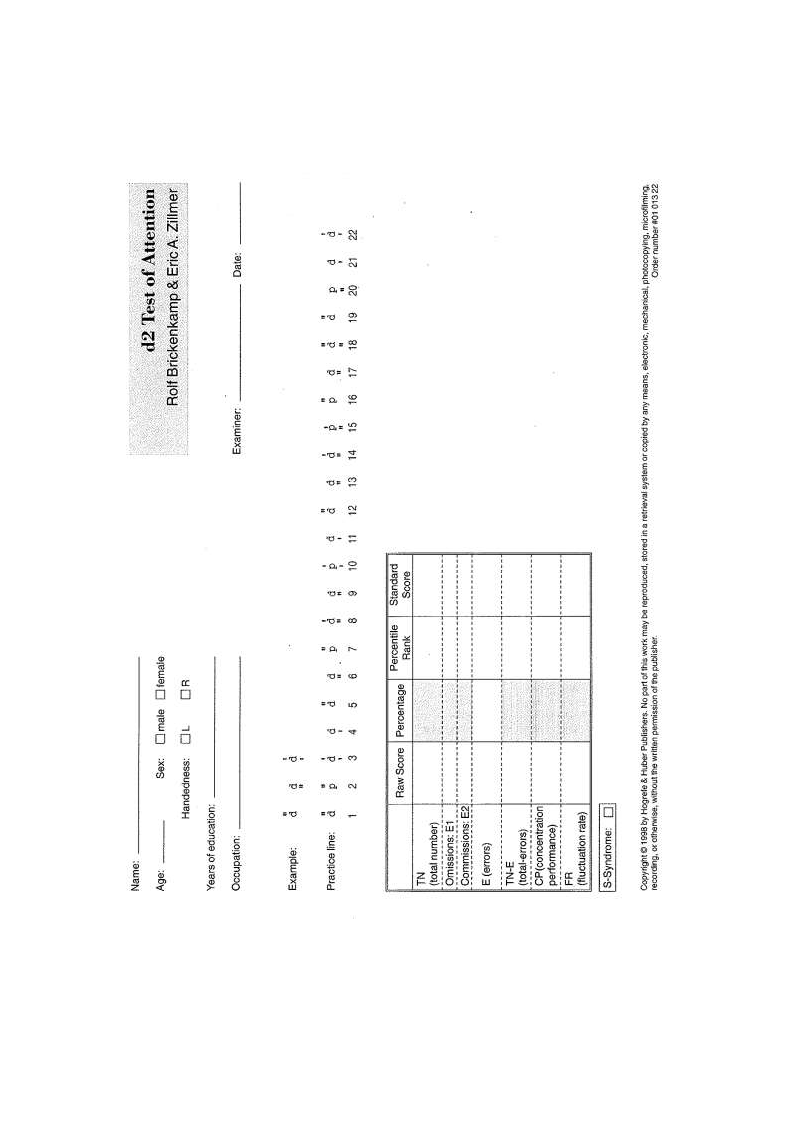
152
APPENDIX VI
d2 Answer Sheet

153
APPENDIX VII
d2 Instructions
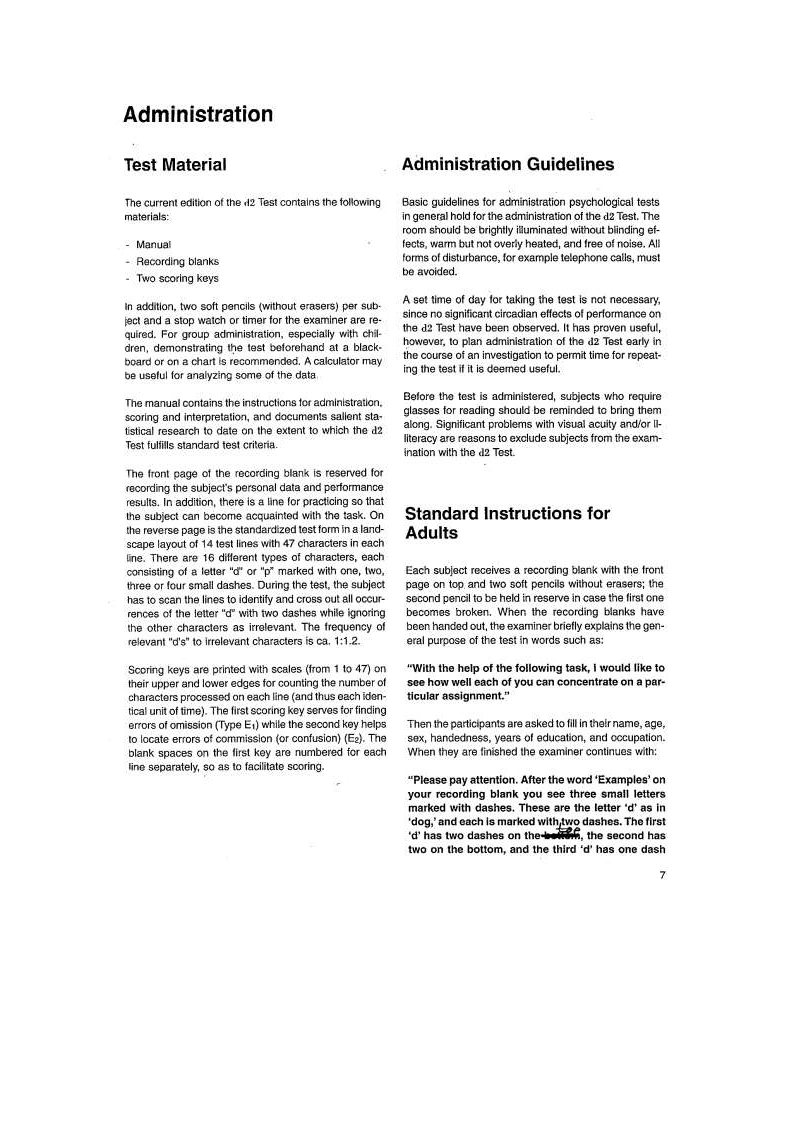
154
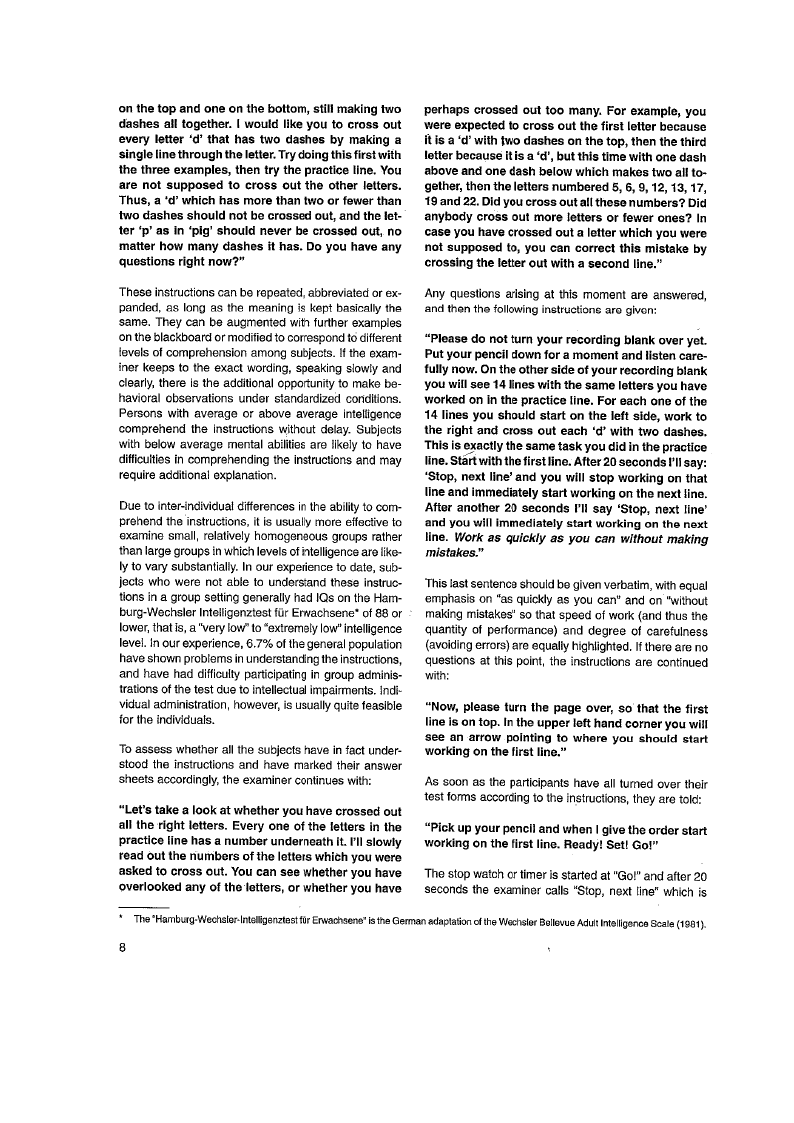
155
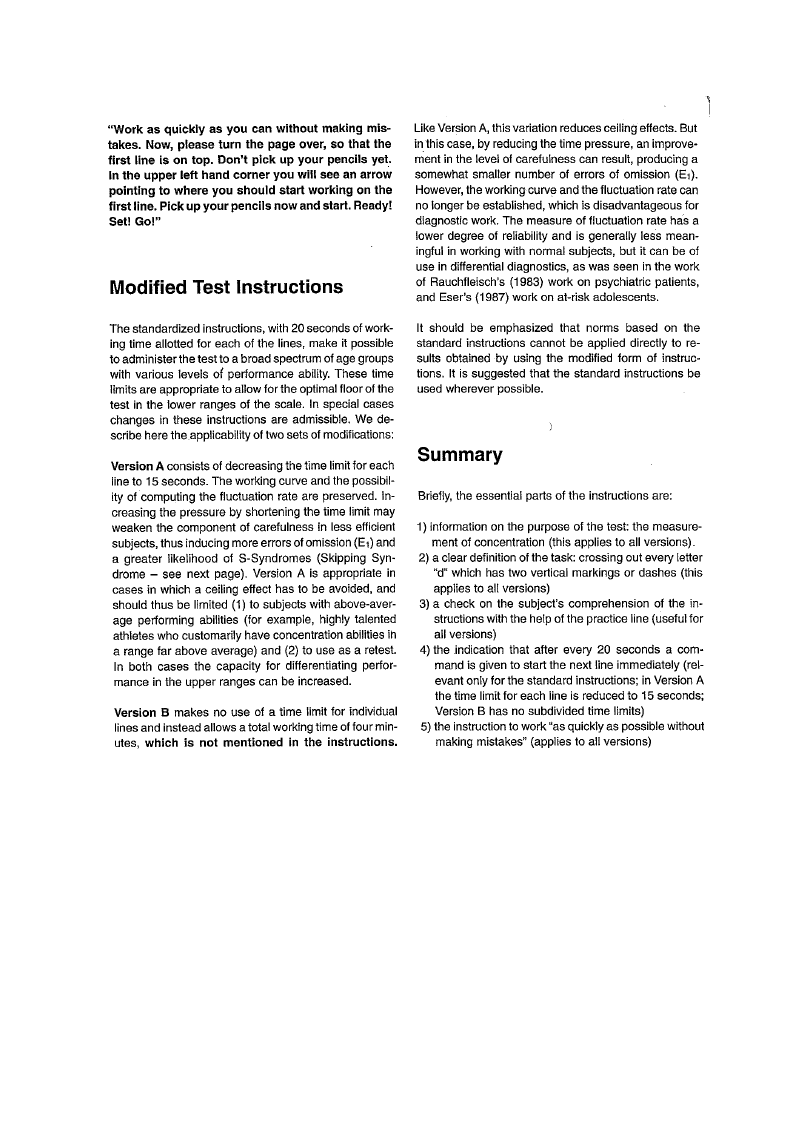
156

157
Word Count Results
234 i
215 the
123 to
112 walk
109 and
89 was
82 a
67 it
55 of
54 more
50 today
49 as
41 my
41 entry
40 that
40 in
39 this
39 on
36 had
34 me
28 also
27 not
27 have
26 felt
25 day
24 than
23 we
23 walks
21 with
21 which
21 quite
20 school
19 time
19 t
19 from
APPENDIX VIII
Word Analysis

158
19 do
19 be
18 during
17 when
17 very
17 is
17 for
17 but
16 people
16 did
16 after
15 relaxed
15 found
14 some
14 however
14 at
13 enjoyed
12 so
12 nature
12 feel
12 didn
12 been
12 able
11 were
11 walking
11 relaxing
11 like
11 good
10 these
10 stress
10 much
10 mood
10 lot
10 group
10 first
10 am
10 all
10 about
9 seemed

159
9 nice
9 because
8 would
8 there
8 really
8 participant
8 noticed
8 myself
8 mind
8 less
8 last
8 home
8 helped
7 woods
7 used
7 things
7s
7 out
7 having
7 got
7 forest
7 enjoyable
7 enjoy
7 different
7 days
7 concentrate
7 better
7 although
6 work
6 usually
6 tired
6 think
6 them
6 test
6 spent
6 part
6 other
6 longer
6 if

160
6 homework
6 get
6 friends
6 find
6 due
6 could
6 calm
6 by
6 bit
6 an
5 will
5 who
5 went
5 way
5 walked
5 up
5 trees
5 thought
5 talking
5 talk
5 such
5 stressed
5 or
5 only
5 may
5 made
5 look
5 little
5 just
5 interesting
5 how
5 go
5 friend
5 fresh
5 forward
5 focus
5 easier
5 despite
5 before

161
5 around
5 are
5 afterwards

162
APPENDIX IX
RAW DATA/INFERENTIAL STATISTICS

163
CP Data

164
TN Data

165
APPENDIX X
TWO COMPLETE PARTICIPANTS’ JOURNALS
Participant #9
Entry #1
I found the walk to be enjoyable. It felt as if I had left behind the worries of schoolwork, etc.
The nature walk was also interesting as it is nice to be fully surrounded by plant life. I did not
notice a dramatic change in mood, however as the evening progressed, I found myself to
feel more comfortable. Completing homework assignments also felt a lot easier. The walk
may have subtly relaxed me, and it felt as if life relaxed mood was sustained throughout the
evening.
Entry #2
Today I did not feel very different from the walk in the woods. I was tired from the school
day, and this may have been a factor contributing to this. The walk didn’t seem to noticeably
change my mood, rather I felt more physically drained. I did however feel calmer when on
the walk.
Entry #3
The walk today was enjoyable and i feel that it had an effect on my mindset. I felt calm
during the walk and also afterwards. When I arrived back at school, I reflected on the walk
which also helped. I look forward to the walks as it feels as if there has been a difference in
my mental state afterwards. The only noticeable disadvantage of the walks is that it indirectly
adds a bit of pressure onto academic deadlines, although today was the only day I
experienced this.
Entry #4
I feel that the walk today rid me of some stress. I was previously anxious about a maths test
tomorrow, although the walk helped me to concentrate when revising. Today I looked
forward to the walk, as it often has positive impacts.
Entry #5
Today the walk was effective at improving my mood stress levels and general well-being. I
found the walk to be relaxing and entertaining. My evening after the walk was also fun. This
walk was my favourite to date, as there was a calm atmosphere within the group and
surroundings. The walk improved my state of mind and me look forward to the next.
Entry #6
Today the walk felt as if it was longer and more tiring than usual, however this may have
been due to the poor weather conditions. We also walked at a fast pace, which limited the
time actually spent in the forest. Due to less time spent in the forest, I think that the benefits

166
of the nature walks were not as pronounced. That said, I did still enjoy the walk as they help
to relieve stress after school.
Participant #10
Entry #1
Today was the first walk. To my surprise I quite enjoyed it, more than I thought I would. I
found that walking in the forest/nature is very calming and relaxing. After a long day at
school, this walk helped me to relax and to remove the anxiety and stress that I had before.
By talking to a friend during the walk, I was able to pass the time a lot easier; it also made it
more enjoyable as I was able to socialize in a more relaxing way than I am used to. The only
part of the walk that was tedious was the large hill we had to walk up.
Entry #2
Today was the second walk. After a test, it was nice to unwind by walking through the forest.
I found myself having a really indepth conversation with a friend which I have not done in a
long time. We talked about many things and it helped me to figure out some problems from a
difficult class that had been puzzling both of us for awhile. As a result I do not have to worry
about the issues anymore. After the walk I felt quite awake and attentive which surprised me.
Entry #3
Today was the third walk. I thought it would be cancelled due to the thunderstorms earlier in
the day, however it wasn’t. There was no rain during the walk, however it was quite humid.
Although the walk was nice and relaxing, the humidity prevented me from feeling as calm
and relaxed as I did on the previous two walks. I felt a bit too warm and damp. I spent alot of
time trying not to walk in mud and so could not fully concentrate on enjoying the walk.
Despite all of this, the walk still helped me get some fresh air, which I had not had all day.
Entry #4
Today was the fourth walk. The weather today was much nicer than on Tuesday.
Surprisingly the walk seemed to go alot quicker today than it did on the three previous
sessions. The large hill also seemed less of a problem. I felt very relaxed during and after
the walk despite having alot of work to do. Although I got home an hour later than I normally
do, I didn’t feel stressed at all about having to do lots of homework. I just got on with it.
Entry #5
Today was the fifth walk and I am now half way through these sessions. I talked about a lot
of things with my friend and this also helped to uplift my mood. We passed a point where I
saw two deers two days ago during cross country. Unfortunately they were not to be seen.
Once I got home I began to revise for my biology test which is in a few days. I found revising
today much easier than when I did it yesterday despite having less time than yesterday. I
was able to concentrate quite well when revising and so took in a lot of information.

167
Entry #6
Today was the sixth walk. During the walk I noticed that I felt quite happy and optimistic
more so than at school or at home. Although I had much to do when I got home, I knew that
it would be OK so I would be able to get it all done. These problem that I often have were
cleared away during the walks. By talking to other people, I was able to laugh which also
brightened my mood. The walk today was really enjoyable and I had a lot of fun.
Entry #7
Today was the seventh walk. We went on the longer route today. I liked this as it was a
change of scenes and prevented the walk from becoming boring and regimental. The big hill
didn’t bother me at all and I didn’t have any problem walking up it. I noticed that some of the
trees have begun to shed their leaves. On other trees the leaves have begun to change
color from green to yellow. I had a headache for most of the day but after the walk I forgot
about it and the pain simply went.
Entry #8
Today was the eighth walk. The weather was quite nice. Once again I found the walk very
relaxing and felt calm after it had finished. After the walk I also felt quite attentive and awake.
I have noticed this on most of my walks. This has enabled me to work more efficiently at
home.
Entry #9
Today was our 9th walk. It is likely to be our last as the weather forecast for Thursday is not
good. There were only three of us on the walk today. We discussed many things such as
sports and films. It was quite fun. It was colder today than it was in the past, however we
were walking quite quickly. I didn’t notice as much.
